Australian
and international
exploratory
performance and
media arts
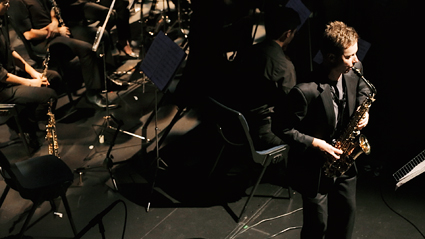
James Nightingale, Voyage Through Radiant Stars, Aurora New Music Festival
courtesy Aurora New Music Festival
James Nightingale, Voyage Through Radiant Stars, Aurora New Music Festival
The first half of the opening night of the 2014 Aurora New Music Festival in Sydney’s west sparkled with variety and invention while the second half introduced us to a major new work, Brian Howard’s Voyage Through Radiant Stars, which shone obsessively with cosmic aspirations.
The immediately engaging concert opener was Marcus Lindberg’s Ablauf (1983/88; Finland) featuring clarinettist Jason Noble in rapid vertiginous flights from raw depths to lucid heights while positioned between the emphatically slow-paced boom of two bass drums (Claire Edwardes, James Townsend). In the end, after a moment of silence there emerged sibilants, sharp consonants, soft drum beats, like distant thunder, final flourishes and a single full-breathed exhalation from Noble.
Ekrem MuLayim’s Sonolith (2014, Australia) is an aural and visual response to the Universal Declaration of Human Rights for piano (Roland Peelman) and projections (MuLayim, Mic Gruchy): “certain pitches are ascribed to certain letters, certain chords to certain words and certain melodic phrases to key words or word groups” (composer’s program note). On three long screens, the words appear in various patternings almost simultaneously with the notes, as if the pianist is typing them (an impression reinforced by recurrent dings, piano slaps and cries). The outcome is a flexible minimalism now and then powered by a fluent, assertive stride (from 20s American jazz pianism) or disintegrating into near discordancies.
The inclination of composer and pianist (who is given room to freely interpret) is not seemingly programmatic although Clause 5 on Torture is stressfully fast and high pitched, Clause 7 on Discrimination threatens to break up, 11’s Presumption of Innocence strides proudly and in 14, on Asylum, the loud pedal is held firm on deep notes beneath those rushing on above, as if hope is disintegrating. Associations are fleeting but inevitable in an ambitious and audio-visually potent work (convincingly played by Peelman) although the composer’s commitment to illuminating all the clauses of the charter with a limited sound palette and a lot of reading proved a tad taxing in the long run.
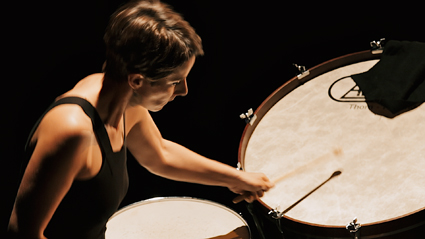
Claire Edwardes, Aurora New Music Festival
photo courtesy Aurora
Claire Edwardes, Aurora New Music Festival
Iannis Xenakis’ Rebonds A/B (1987-89, France) is a work for percussion in two resonating movements. The first, A, has a dance-like compulsiveness, its deep beat soon overlaid with a multitude of improvisation-like, increasingly rapid-fire flourishes until it finally slows to a hesitant if emphatic halt. B feels less complex with its open pattern on drums and then on woodblocks; then it’s back to the drums at a steady pace but with some fast counterpointing. Pause. The woodblocks chirrup and are joined by the drums in a race to the finish. Both movements are finely articulated, played as ever with Edwardes’ capacity for finesse and passion—Xenakis’ music might be conceived in part algorithmically but she makes its beauty self-evident.
Sydney composer Alex Pozniak paired virtuosic dijeridu players Mark Atkins and Gumaroy Newman in his new work Blow by Blow, focusing on the drone potency of the rich sonic textures offered by these traditional instruments. Alongside the anticipated sounds of animal and bird cries, cars and aeroplanes, soft sssh-ings and Atkins’ vocals we hear strikingly high, long sustained horn-like notes, pulsating deep beats and surprising (and recurrent) glissandi. Each player handles three instruments, swapping from one to another, introducing new layers of sound at once familiar and strange—as if not coming from dijeridus at all. At the end the players slip into improvisation, merging with the distant offstage strings of two members of the Noise Quartet.
Brian Howard’s Voyage Through Radiant Stars (2013, an Aurora Festival commission) with its constant ascending flights felt more often cyclical than linear, each star (one per movement within its “radiant constellation”) evoked as if like any other—save in degrees of luminous intensity or aural mood, including passion or awe as brass and percussion repeatedly and thunderously grounded the work with an emphatic motif often at the beginning of movements and then later in each. Against this deep tremulousness, as if in flight from it (or like lines of radiating light), is the saxophone (James Nightingale), variously solo, placed within the 18-strong ensemble or before it as in a concerto—which the overall work is not, at least not conventionally.
The compositional motifs in the sax solos and ‘concerto’ movements evoke the traveller more than they do the stars. There’s a greater freedom than felt in the gravitational pull of the brass. Indeed there are movements when the saxophone seems to draw the ensemble up with it—the drumming accelerates, oboe, clarinet and brass scale upward, the strings echoing the saxophone’s ascending dance.
Howard and Nightingale exploit much of the saxophone’s range—pure, whistling, staccato-voiced, jazzy, guttural and striving and soaring to ever increasing heights before commencing its flight yet again, but with little suggestion of fall or defeat despite the ensemble rumblings beneath. It is the characterful saxophone, in a work of some 60 minutes, that keeps Voyage Through Radiant Stars luminous, in a journey in which the saxophone is itself a star or, elsewhere, part of one or even absent, just listening, when one star is solely represented by a sinuous string quartet. This is an epic work, needing firmer acquaintance and perhaps greater concision, but on first hearing superbly realised by James Nightingale, conductor Daryl Pratt and the Sydney Conservatorium Modern Music Ensemble.
The Aurora New Music Festival’s opening night proved to be memorable, programmed with fascinating new Australian works that innovated with text and piano, the dijeridu and the relationship between saxophone and ensemble. The long first half of the concert did put Voyage Through Radiant Stars at risk; my attention certainly wavered, partly because the work’s patterning became hypnotic however varied it was in the detail. If deserving a stand-alone outing, its premiere performance was nonetheless welcome and highly significant. Thank you, Aurora.
Aurora New Music Festival 2014, Opening Night, Aurora Artistic Director James Eccles, Riverside Theatre, Parramatta, 30 April
RealTime issue #121 June-July 2014 pg. 46
© Keith Gallasch; for permission to reproduce apply to realtime@realtimearts.net
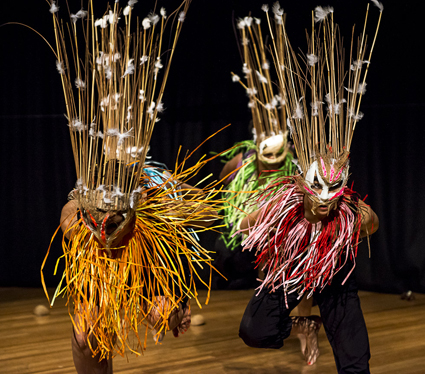
Winds of Woerr, Ghenoa Gela
photo Gregory Lorenzutti
Winds of Woerr, Ghenoa Gela
Next Wave is an ambitious festival—a major, well-funded biennial curatorial project which commissions and develops innovative work by young artists (notably through its Kickstart program). The final works, unveiled only at the festival, are often variable in their execution. This, I have come to realise, is legitimate. The level of risk involved in working with very inexperienced artists on extremely ambitious projects is extremely high, and it is part and parcel of the project that the whole experience can feel very hit-and-miss. As the statement of intent for 2014 said: “We support what is attempted over what is achieved.”
2014 Next Wave, however, was the most even I have yet experienced. Not only was the quality of the work high overall, but the program was presented in a very cohesive manner, thanks in no small measure to Emily Sexton’s strong curatorial steering. This was Sexton’s second Next Wave, and her customary attention to detail was visible at every step: in day tickets tailored to various audience profiles, a well-considered talk program and two excellent publications. The heart of the festival was BLAK WAVE, a festival within a festival, incorporating seven works by Aboriginal artists that in various ways questioned the place of Aboriginal art, a series of talks and its own book.
BLAK WAVE
Perhaps the most notable thing about BLAK WAVE is that it happened in the first place. Sexton’s foregrounding of Aboriginal art and artists in the context of new, emerging, urban and experimental art made a very strong statement about the place Aboriginal artists should occupy in Australian culture. Through talks and the book, BLAK WAVE also created its own critical and analytical commentary, forging a nuanced, discursive context not likely to manifest in mainstream media. The entire project was simply extraordinary in its scope, both educational and emancipatory.
The inclusion of so many Aboriginal events radically changed the feel of the festival, and, in a certain sense, our expectations of contemporary art and performance. In Melbourne, a southern city, Aboriginality is not very visible. Yet at Next Wave we were introduced to an alternative reality, in which every evening we were welcomed to country—did you know how varied is the traditional ownership of inner-city Melbourne?—with elders praising young artists and speaking about the importance of contemporary art—when is the last time you have seen an elderly Australian of stature, a non-artist, speak from the heart about the importance of contemporary art for our culture? Here a performance was first and foremost a social event, a gathering, where we were welcomed as guests, not simply as paying customers. For a little while, BLAK WAVE created an alternative Australia, an Australia that could have been, and may still come to be, in which hatred, ignorance and fear were bridged over by gestures of generosity; in which silent gaps in our history were filled with stories; and in which our own history of art expanded to connect ancient traditions and the cutting edge of the present. It offered an immense gesture of healing.
Winds of Woerr
Ghenoa Gela, an accomplished dance performer, devised Winds of Woerr to introduce a traditional Torres Strait Islander story of the four winds, whose influence shapes the climate more than the notional four seasons. It opens with a greeting, a cup of tea and the voice of Gela’s mother Annie correcting her daughter, instructing her on how to properly conduct the performance. The dance theatre piece unfolds with four performers (two Indigenous, two not) each representing a wind with a mask and a prop. They are the four sisters Kuki, Sager, Naigai and Ziai. It is impossible to critique Winds of Woerr through the prism of Anglo-European performance history because it is not yet integrated into that experience, but is here brought to life as pure cultural material, to be shared, spread and saved from extinction. The beauty of the work is primarily in the texture of its culturally specific material: a yarn from Creation Time, narrated through Islander movement, sound and costume.
White Face
Carly Sheppard’s White Face, a predominantly abstract duet between Sheppard and non-Aboriginal dancer Ryl Harris, was easier to read as a dance piece in the conceptual/formalist Anglo-European tradition. It explores the experience of a fair-skinned Aborigine—the cultural dislocation and gaps, the ungrounded sense of identity, the loss, the insecurity. Sheppard covers her face, rubs her skin with white powdered sugar, wrestles with Harris and compares their shades of fair skin side by side in a powerful gesture of uncertainty. At the height of tension, the work breaks out of solemn silence and abstraction. Sheppard becomes ‘Chase,’ and tells us how, “When I discovered I was an Abo I was bloody ropeable…But, like, I thought about it ‘n I realised that it all makes sense coz I’ve always been real spirichulle…After I found out I went straight down to Cenners to claim me cultural heritage…you know like free house, free car, free Abo money.” The extremely harsh caricature is powerfully accusing, reclaiming discursive ground without ever becoming complicit.
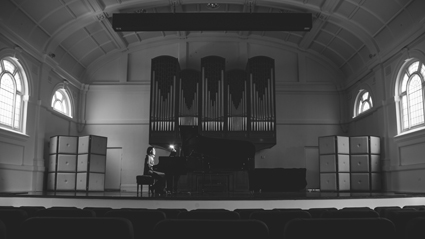
Jesse Hunniford, Concerto No. 3. Sarah-Jane Norman
courtesy the artist
Jesse Hunniford, Concerto No. 3. Sarah-Jane Norman
Concerto No. 3
Sarah Jane Norman’s Concerto No. 3 moved away from Aboriginal identity to address failure. Norman, formerly a prodigious pianist, sets an impossible task. Rachmaninoff’s Third Piano Concerto is considered one of the most difficult piano pieces ever written (even the performer for whom the work was originally composed refused to perform it in public). For 12 hours straight, six non-virtuosic performers (former pianists, post-prodigies) attempt to sight-read the concerto, one at a time, in a dark and solemn Melba Hall at the University of Melbourne Conservatorium of Music.
Immediately on arrival, I realised what a mistake it had been to assume I could see other shows around this performance. Next Wave 2014 is for me marked by regret at not having spent 12 hours in Melba Hall. For spectators without classical music training, this was a work of incidental sound art. But for spectators aware of the intense physical training and sports-like culture of classical music, Concerto No. 3 was like watching an extreme sport in which all our anxieties were realised: like seeing a tightrope walker endlessly fall and climb back up, or a high-jumper repeatedly dislodge the bar—and, say, break an arm. The intense focus and effort of pianists struggling through “Rach 3” put this performance on a par with some of the most involved dance improvisation pieces I have seen.
New Grand Narratives
The theme of the 2014 festival was New Grand Narratives, somewhat vaguely described as “potent visions of a new world, and the relationships within it.” Sexton accurately noted the cracking of old institutions and old ideas. However, the artists did not respond with the same political perspicacity. Indeed, the most overtly political works were not very interesting, reflecting the broader problem the new generation of young Australians has with envisaging possibilities for political engagement. The biggest offender, however, was Dutch outfit New Heroes with Club 3.0, a combination TEDx talk and Fight Club.
Club 3.0
There were four parts to Club 3.0. It opened with a list of well-known collaborative, creative, make-world-a-better-place initiatives that sit halfway between urban design and performance: Reclaim the Streets, local currency initiatives, Park(ing) Day and one very entertaining spoof. It launched into a full-blown retelling of Fight Club, culminating in an actual tournament between audience members. Amazingly, even the hipster, late-night Next Wave audience was inspired to fight amongst themselves, roused by the two performers’ passionate call for action and finding meaning. Had it all ended there, it would have been the best work of the festival. Instead, we were then encouraged to renounce literature and philosophy (this did not work well, probably because the weight of culture is lesser in Australia than in Europe) and were finally sent out into the cold, to receive a non-committal phone message about already knowing all there is to know. I have rarely seen a work rise to such powerful rousing of emotion and agency and then fall into such non-committal disappointment. Club 3.0 managed to deploy all the neo-fascism present in Fight Club, with the very neo-liberal, free-market fallacy of choice that it purported to resist.
New feminism
However, a new grand narrative did emerge at Next Wave 2014: new feminist performance. There has been an undeniable renaissance of feminist thought and activism in the last few years globally, but more so in Australia than elsewhere (probably fuelled, in part, by the horrific treatment of Julia Gillard and the murder of Jill Meagher in 2012). Combined with strategies to increase the presence of women in theatre roles, undoubtedly the most interesting work around Melbourne in the past few years has been made by women. Female performance-makers at Next Wave presented work that was not only thematically, formally and politically world-class, but exceptionally innovative, original and deeply imbued with Australian sensibility. In fact, its major innovation is that it transcends the label of ‘feminist performance.’ It is unmistakably made by women and politically progressive, but it is not overtly ‘about’ gender anymore.
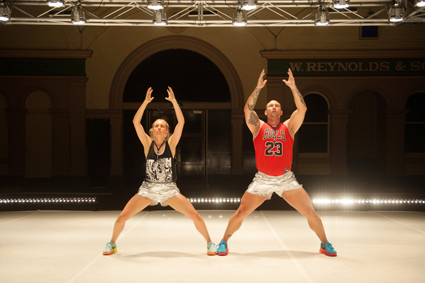
Natalie Abbott, Donny Henderson-Smith, MAXIMUM
photo Sarah Walker
Natalie Abbott, Donny Henderson-Smith, MAXIMUM
MAXIMUM
Natalie Abbott’s MAXIMUM exemplifies this shift most thoroughly. It starts off as a unison dance of two bodies: Abbott’s young and dancerly and Donny Henderson-Smith’s that of a bodybuilder. There is running: circular, across corners; the performers are already visibly exhausted by the time they move onto squats, which expand into lunges, push-ups, twerking, and a whole series of other actions not found in classical ballet. MAXIMUM is conceptually extremely simple: an endurance work stretching two dissimilar bodies to their limits. Halfway through the 60 minutes, the audience is already uncomfortable. In the last section Henderson-Smith lifts Abbott, who assumes the dignified, supplicant pose of a Greek statue; yet both of them keep falling. It is almost unbearable to watch. (The person sitting next to me started shaking uncontrollably.) However, the concept is executed so thoroughly that its meaning comes from a formalist contemplation of how the material (body) is reacting to form (physical stress). At the start, it appears to be a confrontation between an artist and a sportsman. As little signs of fatigue add up (millisecond delays, beads of sweat), it becomes increasingly clear that Abbott, while smaller, is the stronger of the two, foregrounding the invisible labour inherent in art-making. However, as both bodies reach their limits, confrontation becomes camaraderie, and the central question not so much which one will win, but can they push through. A ballsy, yet humble work, which will soon be performed at the Avignon Festival in France
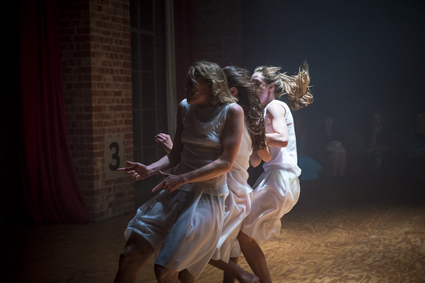
OVERWORLD, Sarah Aiken and Rebecca Jensen
photo Gregory Lorenzutti
OVERWORLD, Sarah Aiken and Rebecca Jensen
OVERWORLD
Sarah Aiken and Rebecca Jensen, young choreographers associated with Abbott, presented the other dance highlight: OVERWORLD. It is an extension of their work Deep Soulful Sweats (which I missed): a participatory, audience-centred combination of dance, yoga and ritual. It brings together movement vocabulary, visual and thematic references and performance practices spanning Kundalini yoga, neo-pagan rituals, contemporary witchcraft practices (à la Buffy the Vampire Slayer), elements of the Zodiac, bush doofs, creation myths and unabashed silliness. OVERWORLD has a gleefully sprawling structure like the beginnings of multi-cellular life: the four performers dividing the audience into elemental groups based on the horoscope; dressing-up and tearing each other’s clothes off in a beautiful, intelligent reference to creation myths across the globe; guiding a meditation session; and finally, as traces, disappearing into a screen, singing and dancing in preparation for a night out.
In the central sequence, once the performers have torn each other’s clothes off while shrieking and wielding their smartphones, one of them remains, totally naked. The lights dim, she lies on the floor and the smartphones are put into glass jars. It turns out they were used to record the action, which is now replayed. The girls’ shrieks now sound eerie, resonating with associations of rape and other violence. Amid it all, the naked performer slowly and sexily eats an ice-cream. One does not necessarily have to know that the central moment in most creation myths is the rape of an Earth goddess to fertilise and create life in order to appreciate how masterfully the point is made about the cultural milieu in which we live.
I admired enormously how unafraid OVERWORLD was to claim supposedly trivial, ‘girly’ concerns and aesthetics. The puzzlement with which it was greeted reminded me of the dismissal of Eleanor Catton’s The Luminaries (youngest-ever recipient of Man Booker Prize in 2013) because of its low status genre (Victorian thriller) and its structural basis in something as ‘unserious’ as the Zodiac. Like The Luminaries, OVERWORLD heralds a new aesthetic in high art: maximalist, freely mixing high and low references, unapologetically feminine, silly rather than stern, but thoughtful.
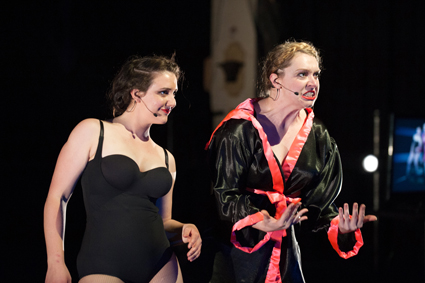
Madonna Arms
photo Sarah Walker
Madonna Arms
Madonna Arms
The only text-based work among those by women at Next Wave was Madonna Arms by I’m Trying To Kiss You. Critics were extremely confused, calling it unclear, but I thought it was the most exciting staging of new writing I have seen in Melbourne in a long time. Madonna Arms is a postdramatic text. The first half builds a cacophony of overlapping voices, freely blending media messages, small talk, and the subconscious—reminiscent of Elfriede Jelinek’s plays in which language becomes disembodied material with its own, depersonalised force (“Sprachflächen” or “planes of language”). Madonna Arms overlaps the sex-and-violence of popular culture with the vicious sublimated misogyny of ‘female interest’ magazines and celebrity gossip. At one point, we hear the voice of someone fleeing her house to escape danger: “I am running in a/ Bright white nightgown that clings to my/ Firm breasts/ I glow against the burning sky /Flying /A bullet!” The staging goes against the grain of the text, creating its own demented reality: women in bathing suits and boxing robes stand in front of a greenscreen, eschewing character, realistic setting, or dialogue, in favour of an abstracted work of pure theatre.
The second half, however, is a parody of naturalism: an ultra-macho fantasy of world rescue by three bureaucrats all named Martin, performed in drag. Here, again, an initially dark lament against sexism turns into an irreverent, gleeful counter-attack on patriarchal nonsense. It shifts from anger to a very Australian kind of ridicule. Theatrically interesting while clearly text-focused, I thought Madonna Arms signalled a major new force in Australian playwriting, picking up the kinds of inquiry that Black Lung championed in Melbourne a few years ago. Indeed, I am curious as to why Black Lung never met with the misunderstanding that greeted I’m Trying to Kiss you—their aesthetic is very similar.
Smell You Later
One small, humble work deserves a mention. Katie Lenanton’s curated installation Smell You Later became, unexpectedly, one of the great joys of the festival as well as one of the strongest devices binding the whole experience. Grace Gamage and Olivia O’Donnell’s scent sculptures were pure sensuous joy: sweet-smelling, melting mounds shaped like candy, cakes, sea shells or just pastel-coloured lumps made out of oils, soap, scrub, glitter and occasional edible stuff (glace cherries, for example). These were installed near washbasins in bathrooms of participating venues, which meant that a regular Next Wave audience member constantly ran into them when least planning to encounter art. There was something extremely satisfying in being able to freely touch, mould, scrub and scrape, taste, rub on oneself and wash off, and then offer oneself to other people’s noses in the foyer. This repeating solitary game became one of the experiences echoing through the festival, bringing together inner-city galleries, town halls, a suburban substation and other varied venues under the coherent experiential umbrella of Next Wave.
Next Wave 2014, director Emily Sexton, Melbourne, 16 April–11 May
RealTime issue #121 June-July 2014 pg. 34-35
© Jana Perkovic; for permission to reproduce apply to realtime@realtimearts.net
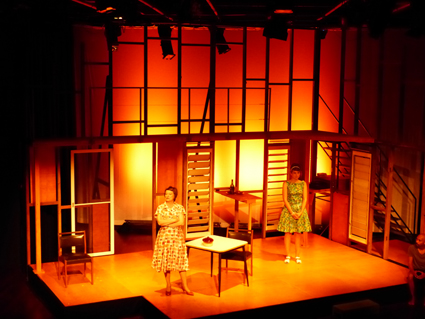
Bastard Territory
photo Kerrin Schallmeiner
Bastard Territory
Colonialism, sexual politics, the beginnings of Papua New Guinea’s independence and family and identity are all in the mix in Stephen Carleton’s new play Bastard Territory. It is an engaging three-act drama that moves between three time zones and two countries as it explores the life of Russell who is searching for the truth about his parentage and in so doing reveals the culture and politics of life in PNG in 1967 and Darwin in 1975 and 2001.
The play opens with Russell (Benhur Helwend) addressing the audience directly—introducing and watching his memories come to life—and then becoming part of the action. As narrator, he poses questions to the audience as he tries to find out who his biological father is. Russell is a direct link between audience and storyline, passing wry comments on the action throughout. Helwend’s pleasure and easy engagement as narrator led to some audience members responding verbally on opening night.
The playwright’s dry humour underpins the action across all time zones, exposing political corruption, homophobia and racism while revealing the circumstances and vulnerabilities of their perpetrators, who are never excused. In Darwin in 2001 we see characters repeating some of the mistakes of the older generation and grappling with the same issues but the outcomes are different. Some issues are re-cycled through the generations revealing how little times have changed.
Kris Bird’s set, beautifully lit by Sean Pardy, is a skeletal framework of a typical elevated tropical house offering director Ian Lawson multiple playing spaces. The framework has a door but no walls, giving weight to the idea that ‘truth will out’ and adding to the sense of claustrophobia as members of the colonial community watch each other closely. The unfinished house echoes the notion of PNG in 1967 as a place in transition and the set transforms easily from PNG 1967 to Darwin 1975 until finally in Darwin 2001 it becomes a “hip urban café and art gallery by day, queer cabaret dive by night” (Carleton, program note). Now dressed in a tight-fitting sparkly black frock and dancing to Shirley Bassey, Russell parades on the upper level as the drag queen his father cannot accept.
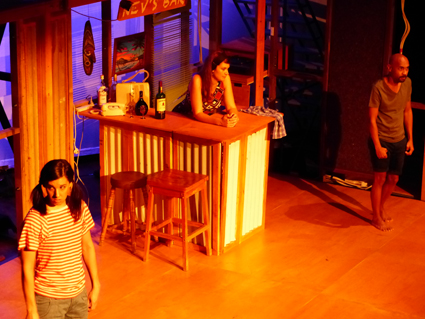
Bastard Territory
photo Kerrin Schallmeiner
Bastard Territory
Kirsten Faucett’s costumes are a gorgeous celebration of colour and playfulness as she reflects the various eras. Ian Lawson’s direction is tight with smooth transitions between time zones and styles melding narration and action with brief choreographed dance routines. The sound design by Guy Webster is a strong element of this production with the three eras delineated by the popular music of the time.
Audiences have become less used to three-act plays but Bastard Territory holds us with its combination of good writing, comedy, diverse theatrical elements and strong performances from all the cast. Kathryn Marquet as Lois transforms from the young hopeful newlywed to a bored wife desperate for diversion to an embittered woman trapped in her own life. She is powerful in the role and handles well the playing of different ages. I was disappointed to have her story end with a sudden disappearance—I wanted to know more about her departure and subsequent brief return.
Peter Norton gave depth to Neville junior, Russell’s adoptive father, and later transformed into the role of Russell’s boyfriend and unwitting father of a child. Veteran actor Steven Tandy played Neville senior, the elderly father who finally comes clean about past acts committed in PNG and who comes to some form of acceptance of his adoptive son’s sexuality.
Suellen Maunder’s heightened comic character Nanette is played with great craft and obvious relish. The audience were too afraid not to answer her school mistress “Good morning!” Although the role is a deliberate caricature, Maunder brought veracity to it, allowing the audience to connect with Nanette’s vulnerable side. Benhur Helwend played multiple roles—all the Papua New Guineans and, as he pointed out, the three possible fathers as well as the son.
I believe it is difficult and rarely successful when adult actors are required to play children and the heightened style chosen for the young Russell and his friend Aspasia was stereotyped. I was relieved when they grew up and resumed their friendship as adults in Darwin 2001.
Bastard Territory is a well-crafted, intelligent and entertaining new Australian play. As Stephen Carleton says in the program notes it’s not only a play about searching for roots and identity but it also asks larger questions about Northern identity: “are the NT and the former Australian ‘territory’ of Papua New Guinea the illegitimate offspring of the larger host nation? Are we as Northerners the bastard children of a perceived national nuclear family or norm? I hope so.”
Knock-Em-Down, Brown’s Mart Productions and Jute Theatre: Bastard Territory, writer Stephen Carleton, director Ian Lawson, performers Ella Watson-Russell, Suellen Maunder, Benhur Helwend, Kathryn Marquet, Steven Tandy, Peter Norton, designer Kris Bird, lighting Sean Pardy, sound design Guy Webster, choreography David McMicken; Browns Mart Theatre, Darwin, 7-18 May; Jute Theatre, Cairns, 6-21 June
RealTime issue #121 June-July 2014 pg. 36
© Nicola Fearn; for permission to reproduce apply to realtime@realtimearts.net
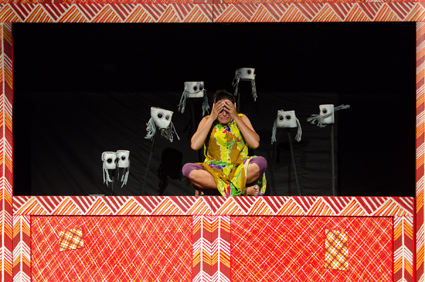
Dalara Williams, Wulamanayuwi and the Seven Pamanui
photo Lucy Parakhina
Dalara Williams, Wulamanayuwi and the Seven Pamanui
Wulamanayuwi and the Seven Pamanui is a delightfully bonkers theatrical fusion of Tiwi Island Dreamtime stories and characters, pantomime, fairytale, drag, song, puppetry and visual projections.
The narrator, Jarparra the Moon Man (Jason De Santis), introduces us to Wulamanayuwi (Dalara Williams), a young girl and daughter of the Rainbow Serpent totem, who is having trouble at home—her warrior father Jipmarpuwajuwa (Kamahi King) plans to marry her off to a stranger and her evil stepmother, Jirrikalala (performed with gusto and lots of evil cackles by Natasha Wanganeen), is plotting against her.
When Jipmarpuwajuwa goes away he leaves Wulamanayuwi as ‘boss.’ She sets off hunting but instead of arriving at her usual lush hunting grounds she is surprised to find a black and burnt land. Luckily a white cockatoo guides her to bush apples and she returns from the hunt laden with food. Jirrikalala, jealous of the clever daughter, decides to kill Wulamanayuwi and her seven brothers (embodied by seven Tiwi designed puppets) and so seeks counsel from an Evil Spirit of the Water (played with drag queen theatrics by Jason De Santis). The two come up with outrageous and murderous plans. Most don’t work out but one hot day, when the brothers go swimming with their sister, the Water Spirit drowns them. Wulamanayuwi is blamed for their deaths and is exiled from her family and country. Bereft, she journeys to a magical land where she meets the Seven Pamanui spirits (not unlike her drowned little brothers), beings out to seek revenge. Later, she eats food from an old woman (Jirrikalala in disguise) and seemingly dies. Her promised husband Awarrajimi (Jaxon De Santis) turns up, tries to revive her, but can’t. The white cockatoo, however, materialises in time to save Wulamanayuwi.
By the end of the play order is restored to the family and the land. Deftly written by Jason De Santis, ebulliently directed by Eamon Flack, quirkily designed by Bryan Woltjen, with AV by Sam Routledge (who was also the puppetry director), Wulamanayuwi and the Seven Pamanui was performed with zest, a whole lot of cheek and a gleeful sense of anything goes. This is a creative team unafraid of mixing Tiwi Island traditional story with European fairytale convention and pop culture tropes. Tiwi language is mingled with English, colloquial speech with rhyme, ballad singing with traditional Indigenous songs, Mozart and Beethoven. The production is staged around a set of portable proscenium arch frames decorated with crosshatched Tiwi designs. Set painter, Raelene Kerinauia, and painters of the brother puppets, Pedro Wonaeamirri, John Peter Pilakui and Linus Warlapinni, all artists from the Jilmara Arts and Crafts Association in Milikapiti on Melville Island, worked with Bryan Woltjen to realise the design.
The production was commissioned by the Darwin Festival and premiered at Adelaide’s COME OUT Festival in March 2011. It continues to tour Australia. The performance I saw was opened with a welcome to country by local elder Richard Davis and the audience ranged from the very young to the very old. This was a noisy, happy, slightly lunatic theatrical event, an enchanting and cheeky tale—testament to the potential for levity in storytelling and the importance of laughter and song in negotiating life.
Wulamanayuwi and the Seven Pamanui, a Darwin Festival commission, toured by Performing Lines, IPAC, Wollongong, 19-22 March; Cairns 19-20 June, Mackay 24 June, Brisbane 26-29 June
RealTime issue #121 June-July 2014 pg. 36
© Catherine McKinnon; for permission to reproduce apply to realtime@realtimearts.net
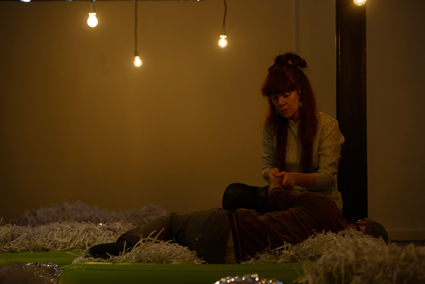
Julie Vulcan, Drift
photo Michael Myers
Julie Vulcan, Drift
The animal inside us, the wild and the civil, and the sea-shifting currents of journey were each explored by three new performance works in Brisbane: Circa’s Beyond, which premiered in Berlin before landing at the Brisbane Powerhouse; Sally Lewry’s powerful physical theatre work Cimmarón; and Julie Vulcan’s new live art work, Drift, the two latter works commissioned by Metro Arts.
I have to admit that I am a shameless fangirl of Julie Vulcan’s work. I say this as a caveat for those readers who are perhaps less engaged with the fragile experience of live art, or who are not as attracted as I am to the indubitably feminine aesthetic explored in Vulcan’s arresting body of work. Drift is a follow-up to I Stand In, an intimate piece where spectators witnessed Vulcan massaging volunteers, a private act in a warm, communal space (RT116). She brings that same quality of shamanic intensity to Drift, where the audience can watch or participate. You are invited to lie on a lime-green, inflatable lilo with a nest of shredded paper atop, which looks inviting but has a disconcerting texture and an unpredictable waterbed motion. Vulcan attends to each of the lilo-layers with precise dignity, providing a face-mask and an ear-bud for the sound-scape. She then massages your hand with a firm and sensual stroke until you relax. Your interaction ends with her photographing you, wrapping you in a metallic blanket and then folding the massaged hand around a delicate, palm-sized origami boat. Participants stay for as long as they want within the confines of the two hourly sessions.
The work’s gentle thematic is a commentary on passage and the precarious nature of boats as refuges, which has such a charged history for Australian immigration, not just in the latest brutal incarnation of White Australia in our refugee policies, but for the waves of immigrants who have come to our shores in vessels of all shapes and sizes. I could see many a traditional theatre patron at Metro struggle with an anxiety about time: when should I leave the lilo? This is partly the thematic of the work, but also a clue that some aspect of the timing isn’t quite fully formed. Perhaps this is a result of programming two short sessions daily that re-set, rather than a longer durational work that accretes over days. Paradoxically, in her artist’s talk Vulcan noted she had attracted a number of repeat, city-commuter walk-in spectators, who were coming back in their lunch hours. I think this is testament to how Vulcan as a performer and artist can hold a space, elevating and deepening it into a profound experience: sensorially, politically and, dare I say, spiritually.
In contrast to the delicacy of Vulcan’s live art practice was the earthy and engulfing experience of Sally Lewry’s new work Cimmarón. Lewry is a familiar face to Melbourne audiences but this was her debut in Brisbane. The intense, almost wordless piece played out on dirt, lit by the delicate shadow-play of lighting designer Paula Van Beek.
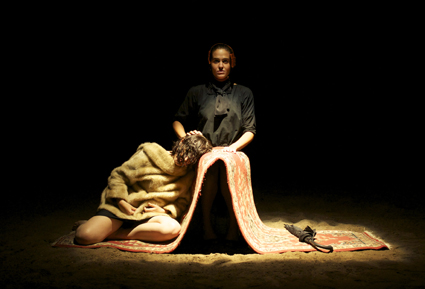
Sally Lewry, Tamara Natt, Cimmarón
photo Miklos Janek
Sally Lewry, Tamara Natt, Cimmarón
The trajectory of the work follows two bodies. The first is Lewry, dirt-strewn in a shapeless hessian sack: a grunting, pawing, howling wild beast but in no way aggressive or out of control, simply wild, tender and vulnerable, like a brumby or a new-born bird. She encounters Tamara Natt, a statuesque dominator, hair pulled back tightly into a plait at the top of her head, clad in dark, narrow clothes, with echoes of the military and dressage. The moment of first contact includes a full range of emotion: curiosity, distrust, potential seduction, but in what seems like an inevitability given the history of these binaries of centre and margin, dominant and abject, the wild is brutalised in what was for me the most powerful sequence in the whole show, bleeding in and out of Patti Smith’s “Wild Horses,” as Lewry’s figure was whipped and broken, made to dance in circles, to learn to obey and be remade in the image of her dominator.
The work reads beautifully across a range of political, feminist and historical contexts as well as conjuring a detailed immersive world. My only hesitation was around the journey of the dominator. This wasn’t about the quality of Natt’s performance, but a sense that the trajectory had been less interrogated and was less specific in movement vocabulary, in design choices, even in the objects allowed her in the space which were clichéd (whips/red carpets/sunglasses) compared to the genuinely surprising and satisfying nature of Lewry’s initial hessian attire, her naked torso revealed under pressure and her wild ram skull. When Lewry unburies this in the final third of the show it pulls the whole thematic of the piece together: the wild that is now dead, fossilised and curated and what was once pulsing and irresistible is lost but still encodes for us an involuntary and simultaneous attraction and repulsion.
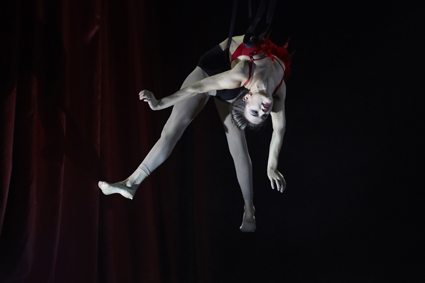
Bridie Hooper, Circa, Beyond
photo Andy Phillipson Photography
Bridie Hooper, Circa, Beyond
Ironically, the piece with the most dialogue and literary pedigree was CIRCA’s new show Beyond. This Brisbane company is an absolute international juggernaut, perpetually on-tour and cycling through stages of formal experimentation—from digital technology to text-based collaboration. Beyond signals a back-to-basics circus form with a simple stage, traditional skills and a delightful, show-stopping premise: the animal inside us all. Drawing from a range of cultural references as varied as Alice in Wonderland, Donnie Darko and Cats the show is a smile-a-minute experience. You could take your most belligerently anti-theatre friend to see Beyond and they would thank you. That isn’t to say that the work is lightweight, quite the contrary, its magic lies in the way the death-defying skills of the tightly bonded ensemble skim across sophisticated cultural references to a charming soundtrack of Broadway standards and classic songs. The image of the supple bodies of the circus performers under their enlarged fluffy bunny heads says it all: the surreal and secret pleasures to be found in releasing our inner beasts.
Drift, concept, performance Julie Vulcan, sound design Ashley Scott, The Basement, Metro Arts, 1-5 April; Cimmarón, creator, director, performer Sally Lewry, co-devisor Xanthe Beesley, performer Tamara Natt, Sue Benner Theatre, Metro Arts, 4-22 March; CIRCA, Beyond, director Yaron Lifschitz, Brisbane Powerhouse, 30 April-11 May
RealTime issue #121 June-July 2014 pg. 37
© Kathryn Kelly; for permission to reproduce apply to realtime@realtimearts.net
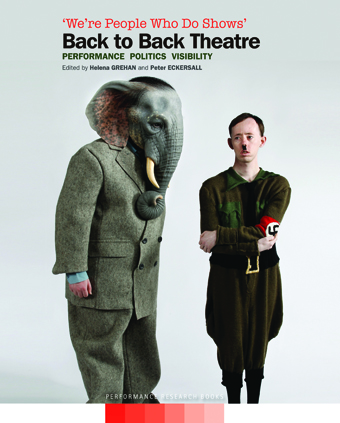 Here is a true rarity, an Australian book celebrating the long life and distinctive vision of a theatre company—Geelong’s internationally successful Back to Back Theatre ensemble. Rather than its works being playwright-driven, the company is an exemplar of contemporary performance, teaming an intensely collaborative director, designers and composers with performer-devisors with perceived intellectual disabilities to collaborate over very long periods on creations that unsettle our sense of time, space, identity and, not least, ability.
Here is a true rarity, an Australian book celebrating the long life and distinctive vision of a theatre company—Geelong’s internationally successful Back to Back Theatre ensemble. Rather than its works being playwright-driven, the company is an exemplar of contemporary performance, teaming an intensely collaborative director, designers and composers with performer-devisors with perceived intellectual disabilities to collaborate over very long periods on creations that unsettle our sense of time, space, identity and, not least, ability.
Published in the UK by the Centre for Performance Research in Wales, ‘We’re People Who Do Shows,’ Back to Back Theatre, has been ingeniously edited by Helena Grehan (writer, lecturer, School of Social Sciences and Humanities, Murdoch University) and Peter Eckersall (writer, dramaturg, Associate Professor, School of Culture and Communication, University of Melbourne). It’s a one-stop shop for scripts, interviews, artist statements, personal recollections, documentary history and complex academic analyses, an excellent collection of images, many by the great Melbourne photographer Jeff Busby, and admirably spacious design (Lin Tobias of La Bella Design, Melbourne) along with some fun touches like two brief flicker picture book series. I was surprised that ensemble performers are not always identified in photo credits, although the reader can sometimes make guesses based on discussions about roles in the essays.
The editors’ aim was to “create an archive” that is “multilayered and sensory or what Walter Benjamin calls ‘the mosaic’: ‘an immersion in the most minute details of the material content.’” They also saw the book as “dramaturgical,” “presenting a range of speaking positions juxtaposing image and text, creative and critical modes of response as well as….insights into the production process.” Further, the works would be “analysed through the lens of new media dramaturgy because it explores theatre’s compositional elements in relation to mediatisation and visuality.” These are frameworks within which Back to Back’s performances are so powerfully realised, conjuring associations with performance makers Romeo Castelluci, Robert Wilson, Hotel Pro Forma and light artist James Turrell, a key influence in recent works says Back to Back artistic director Bruce Gladwin in a long, wide-ranging interview with Performance Research director Richard Gough.
The editors certainly fulfil their ambitions in a book that views the company from numerous angles, inside and out. There is no literal account of the company’s history from 1987 save for a handy list of productions, each with an image and credits for the creative team, but in “In conversation,” previous directors meet with Gladwin and talk through Back to Back’s emergence and struggles for recognition. They recount how some support for the work came from a period of “normalisation,” which aimed to get people with disabilities out of institutions (“and save money”); a time when performers were allowed to move on stage but not speak; the discovery that one of the performers, Rita Halabarec, was a gifted writer (her piece Assembly is reproduced a few pages later); and the push to move from being “a sort of disability organisation” to getting support from the Theatre Board of the Australia Council as a company in its own right, which it became in 1997. The company developed as it engaged with Deakin University’s Woolly Jumpers Theatre-in-Education company, Handspan, Arena Theatre and Circus Oz, always developing skills, maintaining continuity and, as Gladwin puts it, “finding those mechanisms to get the best from people…the best framework to support them on stage and in the process of creating something.” The emphasis on democratic processes is emphatic: Gladwin talks about the importance of “hanging out,” sitting, chatting and “then we’d get up and try something.” Barry Kay recalls learning to focus on the “level playing field” of play. Ian Pidd remembers “always trying to push [performers] beyond their comfort zone,” a goal that Gladwin iterates elsewhere in the book.
The academic essays in the book engage passionately with the works that have emerged from Bruce Gladwin’s artistic directorship—these are the focus of the book. ‘Passionately’ because it is evident that they are moved by these works, disturbed by their capacity to deal directly with big issues and with a deeply unsettling ambiguity. Lalita McHenry, writing about SOFT (2002), approaches the work in terms of empathy, specifically Emmanuel Levinas’ notion of “Substitution—putting oneself in place of another.” At the end of SOFT we are left “face to face with the last man with Down Syndrome”—the rest of his kind have been eliminated in a massive eugenics campaign—but in the work’s first half a couple with Down Syndrome baulk at having a child despite the fact that the doctor they meet has the condition too. We are being tested, even more so, says McHenry, by the design, a vast bubble in which we sit each with headphones: “We see and hear from the inside out, as if we, the audience, are not yet formed, not yet human…[in] a womb-like sculpture.” It’s a striking observation that explains the sheer strangeness of experiencing SOFT.
Eddie Paterson’s “Script after script: Back to Back and dramaturgy of becoming” observes that “in recent works the process of writing for performance comes increasingly to the fore…highlighting the connection with performance art and the collapsing distinctions between author, director, maker, performer and spectator.” Citing scholar John Freeman, Paterson sees this as “a textual playground, where nothing is sacrosanct.” More than that, he writes, the works resonate with Deleuze and Guattari’s notion of ‘becoming,’ in which “minoritorian subjects strategically rupture dominant notions of language and power.” He focuses on the banality of the dialogue in small metal objects (2005), noting reviewer Alison Croggon’s initial feeling that the show needed a strong writer but later realising that “the script they have serves their purpose adequately.” Equally the notion of sole authorship is dispensed with by Back to Back, reflecting the collaborative creation of the work. Besides, the dialogue “becomes poetic” with the punctuating rhythms of the sound score. In Food Court (2009) the spare, brutal deployment of language (spoken, projected, “unstable”) makes radical demands on the audience. In a step further, if with transparent dialogue (and in various languages), Ganesh Versus the Third Reich (2011) becomes a “meta-theatrical commentary” on the work’s creation and issues of ability, casting, power (political, directorial), race and exploitation. Paterson’s account very aptly describes Back to Back in terms of its own dramaturgical becoming.
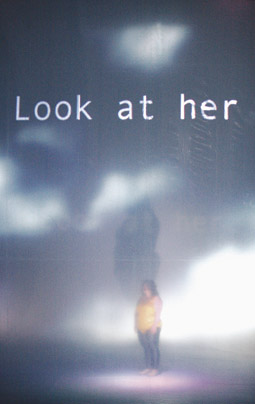
Food Court, Back to Back Theatre
photo Jeff Busby
Food Court, Back to Back Theatre
Helena Grehan in “Responding to the unspoken in Food Court” like McHenry leads from Levinas: “we have no option but to respond to the call of the other” without any expectation of reciprocity. She writes, “While [the performers’] bodies and voices act as markers reminding spectators that they are disabled, the content and searing or (awful) power of their exchange compels us to think and feel beyond a focus (solely) on questions of dis/ability.” She adds, “this is not the other after all, this is a group of performers performing the ‘majority.’” She finds this “shattering,” “it disallows any bystanding,” and there is no “panacea for spectators.” Agreed, but the performance is surely also, in the dialectical manner so true to Back to Back, about people with disabilities maltreating others with disabilities—there is no escaping that. In the same essay, Grehan quotes Gladwin as saying he feels ‘“an incredible responsibility to present [artists with disabilities] in a positive light’ but that for this work the decision was ‘to let it be as dark as it was.’”
Caroline Wake and Bryoni Trezise, in their essay, the one most acutely focused on form, “Disabling Spectacle: Curiosity, contempt and collapse in performance theatre,” also attend to Food Court, in which, as in all of Back to Back’s work, “perception is all.” Spectators are asked “to consider perceptions of disability through performances of disability,” the resulting tension “startl[ing] them into a moment of self-conscious insight.” The work achieves this, they argue, because it is “a hybrid form of ‘performance theatre’” [presumably contemporary performance + theatre, in a work calculatedly staged in a theatre ] “unsettl[ing] the historical alignment between spectacle and spectatorship…keep[ing] spectators in a zone of deferred perception such that a fixed vision of either self or performer can never fully arrive.”
To this end Back to Back’s work has “avoided the framework of disability theatre,” a form in which the nature and sociology of disability is delineated. Instead the company has realised, write Wake and Trezise, “disability performance in which performance is called upon to denaturalise the naturalisation of disability as performed spectacle” in which actors “perform only their [disabled] selves.” The writers add depth to Paterson’s approach to language, focusing on the unexpected, reversals and inversions, the creating and undoing of perceptions. They detect in the production’s impressionistic scenology “the same liminal Zone that Bill Henson’s images occupy, what has been called in the context of Romeo Castellucci’s work the human/dis-human.” Here they argue that the “visuality of spectacle” is “forestalled” by projected text “both explaining and obscuring the action,” along with extreme contrasts in lighting, at turns distancing and immersive. They point to the power of the final bare image of a human body after Food Court has “hurl[ed] every possible theatrical tradition onto the stage” as if “the medium of performance theatre [has seemed] to turn against itself.” In a relentlessly shifting dialectic “the audience perceives performance theatre as simultaneously staging the spectacle of disability and,” as the writers pointedly if drolly express it, “the disabling of spectacle.”
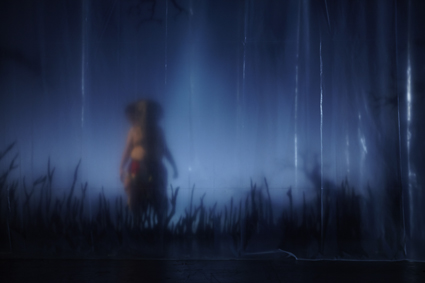
Ganesh Versus the Third Reich, Back to Back Theatre
photo Zan Wimnberley
Ganesh Versus the Third Reich, Back to Back Theatre
Adding breadth to the editors’ appreciation of Back to Back’s collaborative approach is “Lighting Design: Between theatre and architecture, An interview with Andrew Livingston and Paul Jackson.” Helena Grehan couples an interview with Bruce Gladwin and an essay about the participatory video work The Democratic Set (2009), applauding it “as some small space of resistance to the troubled and bleak mainstream” critiqued by Henry Giroux. She captures well the sense of inclusiveness, shared responsibility and the “space of wonder” that the Democratic Set represents and the question it poses to all who make or watch it, “What is art?” Barry Laing reports on the “arrests” he suffered teaching a Back to Back Summer School, having to “change gear, slow down and somehow accommodate this voice: a voice that emerged as witty and irreverent and rich in imagination. This changed the way I was working.” As well, in their introductory essay, the editors condemn the unjust pressure (and lack of support from some key arts organisations) applied to Back to Back by a US-based fundamentalist Hindu organisation over the representation of Ganesh in the Melbourne Festival premiere of Ganesh Versus the Third Reich. Such crude opposition stood in the way of appreciating the work’s much needed insights.
Grehan in “Irony, Parody and Satire in Ganesh Versus the Third Reich” addresses audience complicity in a postmodern work which “positions its audiences in such a space of undecidability that it is difficult to know what ‘good’ spectatorship (in ethical terms) may entail. Fear of laughing at the wrong moment, wondering if the performers are behaving as they actually did in rehearsal or is this work parody, concern about your motives for seeing “a bit of freak porn” (as one of the ensemble, Scott Price, puts it), “feel[ing] empathy, at times a sense of embarrassment,” or sensing that “Scott’s frustration” with the dictatorial director is “very real” (despite the fictional frame)—are cumulatively unsettling. “We don’t want to be bad spectators; instead we want some idea of what it is we should be doing. There is no resolution.” Grehan sees Ganesh Versus the Third Reich as placing us ethically in a position of profoundly questioning the act of spectatorship, just as Wake and Trezise do in respect of perception and the play with forms.
In “Scott’s Aired a Couple of Things: Back to Back rehearse Ganesh Versus the Third Reich, ” Yoni Prior documents her experience of observing the development and rehearsal of the production, focusing on “the ways in which the company positions members of the ensemble as entirely legitimate professional artists, whilst claiming the authority of outsider artists to challenge the perceptions and representations of disability.” She details “an improvisation in which a serendipitous misinterpretation opened up unmarked territory between ‘what is fiction and what is not.’’’ And she adds another layer to the list of ambiguities perceptual and moral addressed in previous essays, writing “[to] borrow Richard Schechner’s distinction, Scott [in what is to become the scene mentioned above] is acting and not-not-acting in this moment as he performs a version of himself.”
In her conclusion, “Playing the reality line,” Prior writes, “The fact that the actors bear the unmistakable marks of disability generates both anxiety and excitement. They appear vulnerable and we who watch them are not always sure if they are safe [onstage]. We are not sure if they are in control, if they know what they are doing…we may be watching authentic distress rather than ‘good acting.’” However, “Ganesh Versus the Third Reich plays masterfully with ambiguities of ethics, meaning, control, intention and authenticity by confronting the audience with multiple challenges to their own ability to identify ‘the reality line.’” This means our stare is turned on us, she says: “the work glares back, remorselessly demanding an apologia from its audience, asking, ‘What are you looking at.’” Or, as in Grehan’s essay on Food Court, the question is presumably “Who are you?”
Tessa Scheer’s “The Impossible Fairytale, or Resistance to the Real” directly addresses the bodies of the performers in Ganesh Versus the Third Reich specifically in terms of their challenge to “the hegemony of the well-trained, socially approved ‘body beautiful’’’ and in the context of a well-established ‘Hollywood’ desire for the disabled to become the “honorary disable-bodied,” more ‘normal’ than different. Disturbed by audience members who preferred the work’s non-meta-theatrical scenes with their visible disabilities, Scheer thought she detected a desire to “favour the fairytale.”
Ensemble members, former and current (Rita Halabarec, Sonia Teuben, Nicki Holland, Simon Laherty, Brian Tilley, Sarah Mainwaring, Scott Price and Mark Deans) figure strongly in the book—in photographs, in essays and interviews where the power of their performances and their willingness to meet challenges are acknowledged— and in their ensemble statements—“We’re people who do shows/ We’re all quite short/ a little bit taller than the one before/ We’re agile and we work/ professionally in a theatre company” and “We’re not afraid to step into the cold, dark side./ At first we’re scared, but/ afterwards we feel good. We are witty, We are emotional. We go deep into the work./ We go to places you can’t go/ in real life.” Of course, many of the words in the scripts are theirs too, borne of exchanges or improvisation, or found, as they were for Food Court.
In New York, at the Under the Radar Festival in 2013, Scott Price and other ensemble members wrote and presented From Where I Stand which included the lines: “I can see the end of ultra-conservatism/ We will stand up in defiance, even though standing is difficult/ for some of us…And I can also see a post-disability world where there is an/ important place for everyone to occupy…”
‘We’re People Who Do Shows,’ Back to Back Theatre is a book for many people, at once accessible and erudite, intimate and esoteric, illuminatingly edited, illustrated and designed—a tribute to a great and enduring company, whose presence onstage we welcome again and again, greeting their difference as part of our lives, admiring their performances as we would any professional ensemble of high calibre and acknowledging the genius of Bruce Gladwin who shares his creative life with his talented ensemble, “providing the best framework to support them on stage and in the process of creating…” I thank Back to Back for taking me, as they write, “to places you can’t go / in real life.”
‘We’re People Who Do Shows,’ Back to Back Theatre, Performance, Politics, Visibility, editors Helena Grehan, Peter Eckersall, Performance Research Books, UK, 2013
RealTime issue #121 June-July 2014 pg. 38-39
© Keith Gallasch; for permission to reproduce apply to realtime@realtimearts.net
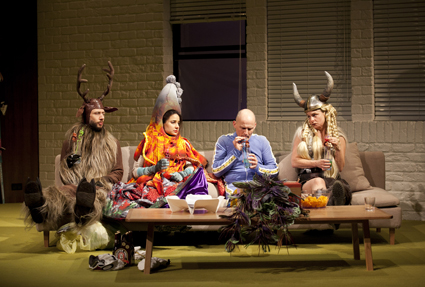
Tim Walter, Andrea Demetriades, Glenn Hazeldine, Rebecca Massey, Perplex, Sydney Theatre Company
photo Lisa Tomasetti
Tim Walter, Andrea Demetriades, Glenn Hazeldine, Rebecca Massey, Perplex, Sydney Theatre Company
Step back from the comedy of German playwright Marius von Mayenburg’s Perplex and you see it for what it is: a nightmare of the age of identity theft. But it’s one where you don’t have to have your cards stolen or your phone or computer hacked. It just happens. And you have another identity foisted on you.
STC, Perplex
In Perplex you come home from a holiday to the friends who have been looking after your apartment, they treat you like intruders and force you out. There are subsequent displacements, increasingly bizarre: unwelcome new roles assumed, sins inherited, sudden adulteries and big ideas (in the shower a man comes up with the Theory of Evolution, only to be disabused of his too late discovery by his erstwhile wife). There’s a child who grows quickly into a Nazi; man-on-man sex (to the surprise of both parties) at a wild Viking dress-up party with a woman who has turned into a volcano.
And so it goes until the work’s larger mutation into a meta-theatrical and metaphysical confection when one character demands to know, “Who cast me?” The subsequent postmodern game playing (the director has abandoned the show and the set is pulled down around the actors) is a tad too familiar (“Are you doing a monologue? We said we wouldn’t do any more monologues”), although it has its moments, including the sudden appearance of a nutty (God is dead) Nietzsche at the window. He is inadvertently shoved and falls: “We have killed him!” one of the characters cries and the knowing audience laughs as the certainties—social, sexual, political, metaphysical and theatrical—of middle class life fall away.
Perplex is fun if not metaphysically particularly convincing or consistently funny. On opening night the performance was initially strained, over-emphatic instead of convincing us of the realism that would soon be ruptured. However, once underway performers Andrea Demetriades, Glenn Hazeldine, Rebecca Massey and Tim Walter excelled in their comic dexterity in Sarah Giles’ brisk, quick-witted production. Perplex doesn’t match the depth and reach of Marius von Mayenburg’s Fireface, Moving Target, The Ugly One and Eldorado, although the number of productions of Perplex across Europe suggest he’s hit a nerve with a work that evokes the instability of dreams and the terrors of erased and imposed identities. It’s good to have seen it here.
STC, Fight Night
ABC TV’s Q&A angers me. I can rarely sit through it. It’s raison d’etre, giving citizens the opportunity to have “your say” is a nonsense. Questions remain partly or not answered at all or are deflected to an inappropriate panellist by a mediator who cannot stop himself from repeating and interpreting the question and editorialising. Rarely is any argument sustained. Outrageously, in subsequent advertising Q&A exploited the recent onstage student protest it failed to respond to. Jones’ retort, before subsiding into bewildered silence on the night, was that old standby: “You’re not doing your cause any good.”
Fight Night (a collaboration between Adelaide’s The Border Project and Belgium’s Ontroerend Goed for the Adelaide Festival and STC) irritates me too, as soon as “your voice,” the audience’s, is invoked by another smug host (at least he’s being ironic, if tiresomely so). Shortly, he has us on the path to choosing a winner from a group of candidates in a protracted, shallow process that barely justifies itself by being thinly satirical and occasionally funny—or very funny for pockets of the audience. The ‘choices’ are all too quickly revealed not to be choices at all—the point being that we vote for mere appearances and with rapidly diminishing information with which to judge. What’s new?
It’s presumed our voting will tell us something about ourselves. We have in our hands iPod-like devices that record our votes, which will determine who leaves the contest, as in reality TV shows. When the show veers into the surreal or the obscene its potential is revealed, but even here choice is a joke—there are only obscenities to choose from. Cynical fun, but not revealing. Predictably the candidates manipulate each other and us, compromise, shift ground, change the rules and in a coup, depose our host, causing a revolt where we are asked to vote as one for a winner to be our leader or to leave the theatre. Some 20 of us do. The process is rigged. The show’s a fiction but we can’t conscionably stay. If the message is that we voted shallowly, well of course we did, the options were far too thin to provoke self-awareness, of any sense of our identity in a democracy.
The actors do a fine job, constantly adjusting to audience whims with a mix of scripted declarations and quick-witted improvisation, and the two vote-counters at computers keep the stats rolling. Certainly in their conservatism the audience on this night remained true to the sad state of our nation. As for the work’s title, the boxing ring set and capes worn by the five performers at the outset, the mike hanging from above and the bow-tied MC give limited life to the boxing match metaphor which was neither adequately sustained nor at all revelatory.
Parramatta Girls
A reunion of former inmates of the Parramatta Girls Home (1887-1973) provides a straightforward formula for recollection, denial, power play and revelation, simple and complex, in a new production at Riverside Theatre of Alana Valentine’s Parramatta Girls (2007). Despite passages of blunt exposition, awkward scene transitions and episodes of laboured dialogue the play delineates the lives of some intriguing individuals, victims of an antiquated and often physically and sexually abusive system of punishment—in some cases simply for being an Aboriginal child.
Long after their incarceration is over, the women are still haunted by its legacy—some ashamedly admit to hitting their own children, others recall nightmarish incidents—and by the ghost of the young Maree who died in custody. She is the link between the reunion and re-lived moments from the past. Other wounds are psychosomatic; Valentine uses the condition to suggest the potential for social and psychological healing. At the beginning of the play, Judi (Anni Byron) hides an elbow wound that hasn’t healed in decades—initially the result of endless floor scrubbing in the Girls Home. At the conclusion, after much denial in the face of accusations, she admits she had sexual relations with the institution’s director and thus enjoyed certain privileges. Now she finds her wound has healed; she can apologise to her fellow inmates and also acknowledge the existence of the ‘Dungeon’ and the institution’s other dark punishments she had refuted.
Other prisoners had first been wounded by their families, by class, race or psychological problems, their suffering cruelly exacerbated by incarceration and their sense of difference making for uncomfortable lives in prison—the middle class Lynette (Vanessa Dowling) sits to the side for much of the first of the two acts, sadly probing a life split-in-half. Valentine’s characters are sharply delineated if to varying degrees, each expressing pain, anger and joy vividly conveyed by Byron, Downing, Anni Finsterer, Sandy Gore, Sharni McDermott, Christine Anu, Tessa Rose and Holly Austin (as the ghost of Maree, who, pregnant to a guard was kicked in the stomach by him; she then suicided).
The horrors visited on these women (based in part on those Valentine met while researching for the play) were many: beatings, the removal from their mothers of babies born in prison and humiliations—Maree forced to wear a bedpan as punishment for bedwetting. More complex was the pain they inflicted on each other and the mutilations of their own bodies. Although the ending of Parramatta Girls is briefly upbeat, some of the women have pride in their subsequent achievements (including helping shut down the Home), some are still recovering, some forgiving, but the play makes it clear that to develop and sustain a sense of identity in such circumstances of constraint, humiliation and enduring self-doubt is a near impossible task: “We didn’t get out with our dignity intact,” says one. (For more on the Parramatta Female Factory Precinct Memory Project see http://www.pffpmemoryproject.org/)
EMD (exposed to moral danger)
Projected onto the stage floor of Parramatta Girls, below designer Tobiyah Stone Feller’s evocation of the semi-ruined Girls Home, are the letters ILWA, standing for “I Love, Worship and Adore.” These affirmations addressed by the inmates to each other can be found carved into the walls and doors in the actual building, 20 minutes walk from the Riverside Theatres.
The site exhibition EMD (exposed to moral danger) evokes the lives of the inmates by means documentary and impressionist with video interview (Lily Hibberd speaking with former inmate and writer Christina Green), sound, painting, installation and sculpture throughout the building. Among works by Bonney Djuric the projected eyes of an abusive director of the institution greet you at the top of the stairs; opposite is a decaying room in which long paper dresses sway like ghosts; and further along two perspex screens conjure now disappeared ‘segregation rooms’—or solitary confinement cells. In a small room downstairs, in three Broken Spirit linocuts by Jeannie Gypsie Hayes, small ghosts dance behind bars and nearby Elizabeth Day’s I Love Worship and Adore fills a large room with the letters ILWA. She has worked outside casting ILWA writ large in plaster on hessian and brought the sculpture inside complete with earth and freshly growing grass. The work dramatically turns a small, ambiguous act of defiance into a memorial of growth and hope. Along with archival photographs, these works evoke something of the lives and identities lost to cruel institutionalisation.
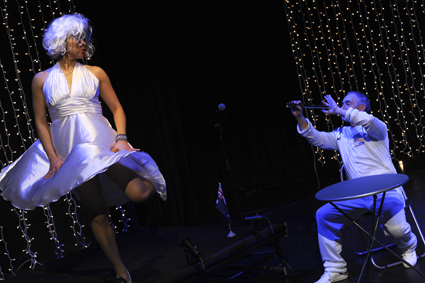
Valerie Berry, Phillip Mills, ClubSingularity, Theatre Kantanka
photo Heidrun Löhr
Valerie Berry, Phillip Mills, ClubSingularity, Theatre Kantanka
Theatre Kantanka, ClubSingularity
Members of a social club dedicated to matters cosmological gather for a final meeting in which they keep their distance from each other, bicker over scientific ideas to do with the Big Bang and Singularity theories and execute an agenda of performance routines for their mutual entertainment—or, more likely, egotistic self-expression. Each has a guise—one is a ‘star,’ a Marilyn Monroe imitator (Valerie Berry) who precisely reproduces the scene from The Seven Year Itch (1955) in which the character’s dress is forced up by ventilation from the New York underground rail system. Another would-be star is the club’s dictatorial Chairman (Arky Michael) who is prone to breaking into impassioned song with a bad Italian accent. Another star of a kind is a pretend Astronaut (Phillip Mills), aglow in his bubble helmet, while the fourth member has cast herself as a sexy brunette Alien (Kym Vercoe) and, as such aptly unpredictable, begrudgingly performs dramatically with that staple of sci-fi movie music, a theremin. The final member presents herself as catwalk star—a fashion Model (Katia Molino) with very firm scientific ideas, an array of sparkling outfits and a bouquet of songs. A barman-cum-musician (Paul Prestipino) serves drinks and a soundtrack of quakes, cosmological soundscapes and live electric guitar and other accompaniments.
The design, like the members’ performances, is calculatedly ‘amateur,’ capturing the DIY naivety of the club—paper lanterns hang like planets about a high wall of golden glowing fairy lights—but hints at something more profound.
The Chairman speaks of his fascination with the heavens as a child, “I grabbed a star—it tasted so sweet.” Moments of whimsy and spacey dreaminess alternate with jokiness and home grown spectacle. As the astronaut gently swings a lamp, like a planet, around the head of an increasingly panicky Monroe (“160 heart beats per minute”), the Model’s gentle lyrics about loneliness reflect on “thinking of your private parts.” These are lonely people, the Chair longs for “another world to find love in,” the Astronaut seeks someone to “boost my rocket.” These desires escalate into a near orgasmic eruption of explosions and all-encompassing vibrations. Little micro-dramas play out as well. The Alien pops on an ET-type mask and dances erotically before the Astronaut but attraction-repulsion forces play out—drawing him repeatedly to and from Monroe; the Alien tears off her mask and weeps. Her ‘routine’ has not succeeded. The Model explains that Dark Matter is holding the cosmos together but that “repulsion is everywhere.”
The meeting progresses: a competition offers the winner an Armageddon survival suit or a bottle of tequila, the Model sings that “the Earth is round but the universe is flat” and hosts a quiz. The Alien gets all the answers wrong but defiantly defends String Theory and the right to speculate. She withdraws, weaving cats’ cradles before erupting into an immolating rant wreathed in smoke.
A huge quake preludes the meeting’s “last dance”—not that they take to the floor. Instead they lean into their little bar tables, hands circling the tops, then reaching up and out and vibrating into a near lift-off into space. In the following calm, comforting words are spoken about our lives as “sharing a common ancestor [carbon],” as “just a spark or an incident,” or “a prelude to a new adventure.” Slowly, the club members exit through the wall of light: “We have loved the stars too much to be afraid of them.”
We now know why this meeting has been announced as the club’s last. But this death wish provokes as many questions as it answers. Is their final act, like their other performances, just a routine, or simply metaphorical—they would if they could defeat their loneliness by merging with the stars. Not recommended for serious sci-fi fans but for those who enjoy contemplating the big questions at a safely whimsical distance it’s fun. If these humans can’t identify with each other they at least can with the stars. ClubSingularity is diverting, if not hilarious, structurally somewhat flat, if lifted by moments of enjoyably tacky spectacle and cartoony characterisations performed with verve by the cast. ClubSingularity is a reminder of how in everyday life—and not just in poetry and drama—we employ metaphor and analogy to help explain our lives, reducing big ideas to fit simple emotional needs, accruing a sense of identity—of oneness with oneself, possibly others and, yes please, the cosmos,
Sydney Theatre Company, Perplex, writer Marius von Mayenburg, director Sarah Giles, Wharf 1, STC, 20 March-13 April; STC, The Border Project and Ontroerend Goed, Fight Night, Wharf 2, 22 March-13 April; Riverside Productions, Parramatta Girls, writer Alana Valentine, director Tanya Goldberg, Parramatta Riverside, 3-17 May; Parramatta Female Factory Precinct Memory Project, EMD, curators Alana Valentine, Lily Hibberd, Michael K Chin, 12-18 May; Theatre Kantanka, ClubSingularity, director Carlos Gomes, lighting Mirabelle Wouters, presenters Performance Space, National Art School; Cell Block Theatre, Sydney, 21-24 May
RealTime issue #121 June-July 2014 pg. 40-41
© Keith Gallasch; for permission to reproduce apply to realtime@realtimearts.net
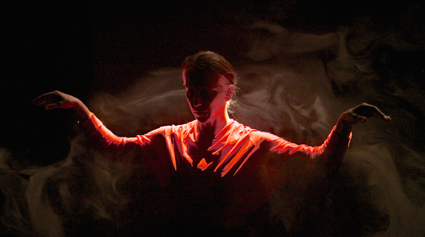
Kate Hunter, Memorandum
photo Leo Dale
Kate Hunter, Memorandum
Some themes are so universal that they approach redundancy. When the author of a work states that its intended subject is identity or the body or place or consciousness there’s a very real risk of tautology, because there are so few works that don’t address every one of those broad notions in some sense. Navigating your way to the bathroom in the middle of the night does too. Doing something interesting with such grand notions is obviously a grand challenge itself, but sometimes the most effective method of painting big pictures is with a very fine brush.
Kate Hunter, Memorandum
Kate Hunter’s Memorandum concerns itself with one of the hoariest of topics, at least since mid-90s academia wrung every last drop from its cadaver. ‘Memory’ is the face that launched a thousand theses, perhaps second only to ‘desire’ in the empty signifier stakes, and there have been oceans of ink sacrificed by students justifying how (insert favourite text) is an exploration of memory’s vicissitudes. Proust did that, but someone has probably made a decent argument that Seinfeld did as well.
Hunter’s own performance history is one rich with promise. She’s a regular with physical theatre ensemble Born in a Taxi, has trained with Anne Bogart and Tadashi Suzuki’s SITI and her solo outings over various Melbourne Fringes have been engaging and well-received. She has a keen sense of the theatre as an embodied space and there’s a liveness to each of her performances that is likely a result of her work in improvised contexts.
But there’s a distinction between a work about memory and a work about a bunch of stuff that the artist remembers. Where once there was frequent lament over cultural amnesia, it now seems as if most lives are worthy of a memoir and any gaps in historical consciousness can simply be spackled over with the grey paste of a few childhood recollections.
Hunter’s narrative doesn’t rise above the memoir mode, but does trouble it in a way that ultimately bears fruit. Amid billowing clouds of smoke or overlaid with projected mirror images of her own form, or bouncing between layers of live and pre-recorded audio, she begins to lay out a narrative that commences in her own childhood but quickly dissolves into false memory, blatant fiction, recollection rendered in the second person, dream, speculation and commentary.
She names names, too: those of the youthful classmate who flashed his penis or the kid whose obvious poverty was made a laughing point, or the one who was chased down the street by a father brandishing a woodsplitter and threatening murder. Her adult self abruptly rounds a corner to face a man administering euthanasia with an axe head to a cow that has tumbled from a cliff. She has that awkward nocturnal encounter you have with a parent you’ve already buried in the ground and who is now asking for an explanation as to what the hell that was all about.
Perhaps the reason artists so often return to memory as a subject is that it is a thing of such stupid artifice. How dare we think that time can be arrested! The ego of it, the unfettered individualism, to think that those things we’ve lived through can be removed from the passage of natural decay and preserved by some private magic. From the inside, the memory of one person is close to all that there is of this world. Viewed from space, or even from the vantage point of a theatre seat in comfortable darkness—same thing, really— the same memory is as inconsequential as a breath.
But there’s not much life without breath. Hunter’s performance might not reveal a great deal about ‘memory’ and there’s an irony in the way that works about memory are themselves rarely memorable. But her words have that trained liveness, complemented by Richard Vabre’s sterling and deeply responsive lighting design, to allow each recollection a moment’s return. Hunter’s memories aren’t our own, and often may not even be hers, but rather than validating ‘memory’ there’s the possibility here that she’s paying respect to the dull and tiny inevitable death of everyone. Hunter doesn’t attempt to glorify her own recalled moments but treats them as subjects of curiosity, humour and sport.
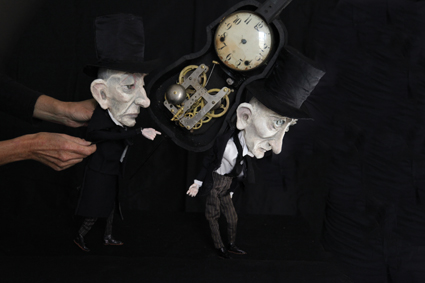
Death at Intervals
photo Anna Malin
Death at Intervals
Colleen Burke, Death at Intervals
Death: that’s another one of those big and tiny subjects. Colleen Burke’s Death at Intervals balances its major and minor chords in unexpected ways. Liberally adapted from Jose Saramago’s As Intermitências da Morte, this puppetry work’s narrative delivers an unnamed nation in which death has inexplicably ceased—murders, accidents and even plane crashes leave their mutilated results still counted among the living, though not without resultant agony.
A lot depends on death, it turns out. Puncture the cycle and religion, politics, the economy and much more will suffer. Death at Intervals is less about the metaphysical implications of its premise and more about the socio-economic. At first we have only the moaning of funeral directors to put up with, but in time the wheezing almost-dead build up enough presence to force any audience member to wonder what would happen should cessation really cease. The zombie narrative is omnipresent today, but cauterise it of its violence and things actually get far more unsettling.
Burke’s adaptation bears obvious resonance with today’s Australia; the rising tide of the not-dead is used by a Prime Minister to justify a cruel and demanding new budget, while the fact that the bizarre situation is restricted to one nation establishes a xenophobic obsession with borders that is all too familiar.
Burke and fellow veteran puppeteer Frank Italiano incarnate a range of puppet styles in full audience view, themselves occasionally performing alongside, or instead of, their tiny charges. A character may be embodied by a long and lovingly detailed carving, or by the expert manipulation of little more than a hat. Some of the success here is due to director Rod Primrose of Handspan and Black Hole Theatre. Primrose’s eye for visual nuance and the changing character of the lit puppet are in full effect, but Burke’s puppet designs and performance are the most notable stars.
When Death returns, she is a wonder. A silver-grey skull atop a twisted spine and skeletal hand, she is a puppet of rare ingenuity, straddling the mimetic and abstract, functional and ornate. She happens upon a cellist and becomes variously fascinated and repulsed by him, and the strange conclusion, in which death attains a kind of love, is as mysterious and ephemeral as the exhalation that accompanies its final image. A sigh, a gasp, a death rattle? But this is not a work that looks to answer questions big or small, and is all the more satisfying for it.
Memorandum, creation, audio design, performance, Kate Hunter, Theatre Works, 20 May-1 June; Death at Intervals, creation Colleen Burke, performers Colleen Burke, Frank Italiano, director Dave Evans, La Mama Courthouse, Melbourne, May 14-25
RealTime issue #121 June-July 2014 pg. 42
© John Bailey; for permission to reproduce apply to realtime@realtimearts.net
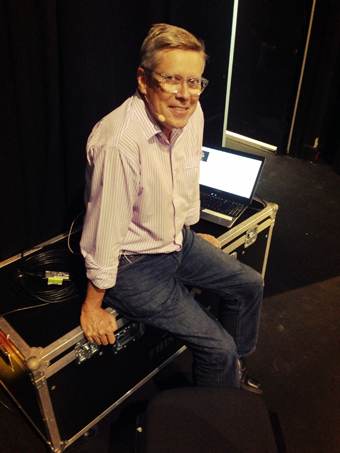
Lewis Jones, courtesy of Judith Wright Centre
“Meet you at the Judy” is part of the vernacular of performance-making in Brisbane, a refrain heard as artists and audiences rendezvous at the Judith Wright Centre of Contemporary Arts on 420 Brunswick Street, Fortitude Valley. The four-storey (plus Bell-Tower studio) heritage building is an old biscuit factory, converted in the halcyon era of cultural infrastructure investment in Queensland in the late 90s.
The thing about the Judy is that it sits in the sweetest spot in the arterial that is the edgy live music and entertainment precinct of Fortitude Valley: the young, the hip and the crazy all walk by seeking kebabs and the pleasures of the night. Like the Powerhouse before it, the Judy has taken a good decade to cement itself into an owned public space, despite such an incredible location and the fact that the building is home to our flagship circus and dance companies: Circa and Expressions Dance Company. But in some mysterious alchemy that seems part good programming and part natural justice, the Judy is well and truly open for business, jammed with gossiping patrons and artists wandering upstairs to use its two intimate studios: the Theatre rehearsal space and the Music rehearsal space.
This change is not only because of the post-industrial elegance of the Judy as a public space, but also a push from the Judy management to invest in ways to open up the space. The Judy was the first to trial licensed cabaret seating. They refurbished the Shopfront venue, formerly an intractable space with concrete floors and intriguing open windows, laying down wooden floors and improving the facilities to make it a functional space for contemporary dance and physical theatre, as well as installation. Consequently, the 300-seat theatre—the Performance Space—and the Shopfront are the most responsive and versatile spaces for experimentation with non-traditional audience reception in the city. Both are regularly transformed into new configurations that surprise, delight and perplex audiences. The Danger Ensemble’s Sons of Sin in an empty Performance Space with a five-storey scaffold is a personal highlight for me (RT 116, p39).
I spoke with Programming Manager, Lewis Jones, a canny and longstanding Brisbane theatre director about the upcoming Judy program and I’m excited to say we have a scoop about a change to their Residency program: Fresh Ground. Fresh Ground has a proud history of supporting local performance-makers, circus and contemporary dance. This ranges from high profile independents such as the Danger Ensemble, the circus collective Casus and contemporary dance company Lisa Wilson Projects. The current Fresh Ground slate includes circus royalty Chelsea McGuffin’s Company 2; Head Office (a Brisbane theatre supergroup with members of The Escapists, The Brides of Frank and Polytoxic); Phluxos2 with choreographers of the moment Neridah Matthaei and Leisel Zink; and energetic, post-gothic contemporary dance-makers Prying Eye.
Traditionally, the Judy’s overall public program is a blend of contemporary music, circus, contemporary dance and theatre, with a strong emphasis on bringing in high-calibre works from interstate and overseas. Historically, there has been a strong correlation between the programming at the Powerhouse and at the Judy and a great deal of the program resource was spent on bringing in shows from outside of Brisbane.
With the currents of Brisbane theatre shifting and a cast of new faces (Artistic Director Kris Stewart at the Powerhouse, incoming Artistic Director Chris Kohn at La Boite), the Judy is responding to the new landscape with an emphasis on local work. Jones wants to make Fresh Ground a platform that supports and “validates” local artists to develop and produce new work at the Judy and to move it on for sustainable touring. This bodes well for a local industry hungry to connect to venues and to find a stable platform to develop new work. On a personal note, I have always found the very short seasons of work at the Judy difficult. Shows are often over before you find them. Perhaps this new approach will settle this restlessness into a more distinctive Judy house style.
The curatorial change is clearest in the upcoming program in the second half of 2014 with new shows from Fresh Grounders old and new: Caligula by the Danger Ensemble, White Porcelain Doll by Prying Eye and Casus’ new work Finding the Silence as well as the perennial Women in Voice. I think the future for the Judy is best summed up by Lewis Jones himself when he says that the mantra at the Judy is “to try and always say, ‘Yes.’”
Judith Wright Centre of Contemporary Arts, Fortitude Valley, Brisbane
RealTime issue #121 June-July 2014 pg. 43
© Kathryn Kelly; for permission to reproduce apply to realtime@realtimearts.net
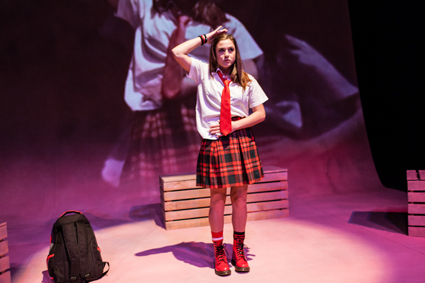
Kate Cheel, Jesikah
photo Sia Duff
Kate Cheel, Jesikah
Depending on which study you read, social media networking may or may not have an improving effect on the mental health of adolescents. Outside of the academy we hear a lot about the web’s risks for young people—cyber bullying, sexual predation, ‘Facebook depression,’ exposure to inappropriate advertising and content—and not much about why so many young people are drawn to it in the first place.
Jesikah, the titular (anti-)heroine of Phillip Kavanagh’s play, performed in this production with persuasively youthful élan by Kate Cheel, is a digital native, a permanently restless member of the iGeneration. Like many of her peers, she has probably already deserted Facebook for mobile messaging apps like Snapchat, which at least she knows her mum (Elizabeth Hay) won’t have figured out how to use yet.
But most of Jesikah’s engagement with social media revolves around the uploading of videos in which, unimpeded by notions of privacy or propriety, she sounds off about her teachers, her friends, her hobbies and, most of all, her endlessly shifting template for personal fame: rock star, actor, whiskey-soaked writer. Online users with names like DemonToaster and OpenSeeSaw variously applaud and troll Jesikah’s posts, her sense of self-worth suspended like a Damoclean Sword between the two extremes.
Her real-world BFF is the seemingly squeaky-clean Denise (also Hay), whose relationship with Jesikah’s internal world—riddled with anxiety and fear of rejection and failure—remains murkily ambiguous throughout. Olivia Zanchetta’s design unobtrusively supports the idea that Jesikah’s headspace is insistently inner-directed, the teenager standing out in punkish red and black while Denise, Jesikah’s mum and her drama teacher Miss H (Hay again) blend into the set’s pinkish-grey wash.
Kavanagh’s script is busy and the dialogue noisy in just the right ways, effervescent with teenage buzzwords and alert to the heightened dynamics and emotional stakes of close high school friendships. The play’s pivot points—heavily accentuated by director Nescha Jelk through an almost dizzying telescoping of the action of the final, increasingly shorter scenes—lie in what in Jesikah’s head are betrayals of her friendship and the passing over of her talents. Fixated like Narcissus on her own (social media) reflection, Jesikah resorts to self-harm as her personality begins to break down, the play taking an altogether darker turn. Her ever more desperate attempts to attract online hits have both a comic and tragic dimension.
But what exactly is Jesikah’s problem? An undistinguished teenager has transformed into an enfant terrible by the play’s end, a trajectory with powerful dramatic motion but that leaves too little explicated. I wanted a clearer sense of the source of anguish in Jesikah’s life, to know how much Kavanagh thinks social media has to answer for in terms of its hold on still-developing minds, and how much of Jesikah’s profound disquiet stems, by contrast, from elsewhere. Given social networking’s relative infancy, the jury remains out on many aspects of its cognitive impact but I can’t help but feel an opportunity may have been missed with Jesikah, rewarding though it is, to mount a stronger case either way.
–
State Theatre Company of South Australia, Jesikah, writer Phillip Kavanagh, director Nescha Jelk, performers Kate Cheel, Elizabeth Hay, designer Olivia Zanchetta, lighting Ben Flett, sound Will Spartalis; Hopgood Theatre, Noarlunga, 9 May; Space Theatre, Adelaide 27-31 May
RealTime issue #121 June-July 2014 pg. 44
© Ben Brooker; for permission to reproduce apply to realtime@realtimearts.net
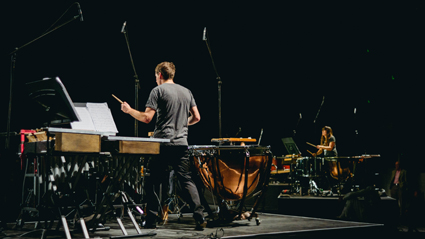
Synergy Percussion, Xenakis v Pateras
photo Michael K Chin
Synergy Percussion, Xenakis v Pateras
A decade after Greek composer Iannis Xenakis’ death, the rarely performed Pléïades remains uneclipsed in its ability to take audiences on a complex, imaginative journey. In Carriageworks’ Bay 19, Synergy reprised their 2011 performance, pairing it the following evening with Beauty will be amnesiac or not at all, a new work by Australian composer Anthony Pateras. Publicised as a ‘competition,’ Xenakis v Pateras, Synergy framed their consecutive-night shows as an attempt to settle who deserves the appellation of ‘world’s greatest composer for percussion.’
Pléïades
A four-movement composition for six percussionists, Pléïades delivers a galaxy of sound, at once tribal, elemental and kaleidoscopic, as showers of tonal colours ricochet between performers. Xenakis leaves movement sequencing open to performers’ interpretation. Synergy chose the order of metal, keyboards, skins and then the mixture, a choice less notorious than Les Percussions de Strasbourg’s decision at the 1979 premiere to play the piece during a ballet, interspersed with Giovanni Gabrieli’s Renaissance polyphony—at once combining Modernism, moving bodies and history in a constellation of artistic stardom. Synergy’s performance echos that original’s innovation, shaping history by incorporating the moving bodies of the audience into the event.
Six podiums formed a rough ring of about seven metres radius. Each platform overflowed with drums, marimbas, vibraphones and sixxens: microtonal metalophones commissioned in 2011 for the piece. The audience mingled and burbled in the darkened space between platforms and a mixing HQ like a Kugelhopf cake baking. Co-director and choreographer Zsuzsanna Soboslay worked with Synergy to design the simple performance space that melded Synergy’s high art technicalities with hipster lounge-room casualness. She helped Synergy find ways to express the music beyond the formal constraints of its composition and the demands of interpretation. And Synergy made it look easy.
Xenakis is famed for his approaches to form, texture and timbre. “Every single note is precisely calculated and notated, leaving little room for interpretation,” Synergy’s artistic director Timothy Constable said when I spoke with him after the concert. “It’s musically complete. There’s a mythological aspect but the music is fiercely abstract.”
Métaux (Metal) showed off Synergy’s sixxens, which clang, jar and beat in your ears if you’re in close proximity. Patterns emerged from seeming disorder; moments of clarity flickered, always briefly. Clavier (keyboards) featured ascending scalic passages and a notorious double-page spread in which the musicians each played 1,000 notes in hair-raising unison. In other parts they came together and split away, phase-beats in an intricate Mandelbrotian overlay.
Balinese associations often arise in relation to the keyboard movement. Xenakis toured Bali in 1972 with Toru Takemitsu and others, but the scale employed in the section is not, to Constable’s mind, lifted from our neighbours, but rather assumes similar interval relationships. “Xenakis uses an infinite mode that might never come back to zero,” Constable said, “but each octave is different. It can make really melodic cells and chaos. If he’d written ‘in a scale’ or ‘regular mode’ it wouldn’t have that dynamism or range of effects.”
Peaux (Skins) had flashes of mind-boggling synchronicity. Thuds on bass drums were reminiscent of a Law and Order scene-change, punctuating energetic passages. In Mélanges (Mix), the final movement, six other percussionists—Claire Edwardes, Eugene Ughetti, Louise Devenish, Rebecca Lagos, Leah Scholes and Yvonne Lam—ascended the podiums to take some heat off core Synergy members’ mallets for an all-in finale.
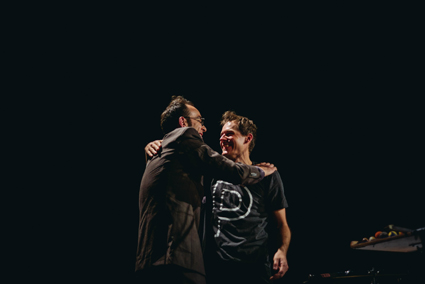
Synergy Percussion, Xenakis v Pateras,
photo Michael K Chin
Synergy Percussion, Xenakis v Pateras,
Beauty will be amnesiac or will not be at all
As part of their 40-year celebrations, Synergy commissioned Anthony Pateras to deploy the same instrumentation as in Pléïades. Its title comes from Sylvère Lotringer’s “The Dance Of Signs,” a neo-Marxist semiotic enquiry published in the Hatred of Capitalism anthology (Semiotext(e), 2002). But listening to the music itself, few references to its philosophical underpinnings were obvious.
The composer was present to diffuse electronic sounds and witness the execution of his invention, partially derived and edited from electro-acoustic improvisations with Jérôme Noetinger. Watching Pateras trigger sound cues while he sat amid the world he had created was telling. When he swayed, grimaced, mellowed and absorbed the manifestation of his creation, it looked like he couldn’t savour the moment enough.
On this second evening we, the rising bundt cake, were microwaved between loudspeakers as each podium radiated layers of six-channel electronic sounds through us. Meanwhile the acoustic score utilised woodblocks, crotales, keyboard percussion and drums. Polyrhythms emerged from fervent repetition, periodicity, duplication, recurrence and imperfect copying. Aeroplane sounds, repetitive metallic jitters, hissings, and whooshings proliferated—some plain to hear, others evasively encoded. Sometimes the electronics greased the pan and other times skewered us. It was a physical experience, either way, just as we were warned in a pre-concert announcement about the work’s aggressive dynamic range.
Synergy performers Timothy Constable, Joshua Hill, Bree van Reyk, William Jackson, Mark Robinson and Leah Scholes, a slightly different group from the first night, again encircled the audience. Some seats were provided on the periphery outside the ring, but most people stood or meandered. I noticed that the volume of sound appeared to increase as I moved—not only when shifting closer to sound sources, but even when I spun slowly on the spot. What an amazing discovery that could propel future audience etiquette from mere static reception into soma-sonic investigation!
Constable explained, “I could sense some key flocking motion. During the Xenakis I noticed people were forming into lovely constellations. A perfect semicircle formed facing me, bringing me into heavy duty focus. Here we go! It was quite serene when I realised everyone was there with me.” He confessed, “The social aspect for the audience was just a byproduct. If we’d sold out completely it would have been more of a mosh-pit. It was a gourmet experience then, with room to bust out handstands… I wanted someone to start running around screaming because that’s exactly what I was doing inside during fiendishly difficult passages.”
Like Xenakis, Pateras makes music using systems and models from other disciplines like mathematics. “Anthony doesn’t use musical notation software or anything, so he didn’t have a way to play back his composition and hadn’t heard it until he attended our rehearsals. There’s a 400-500 page long spreadsheet with all the permutations of every magic square in graphs that someone has copied into musical notation.”
Antony Pateras is a philosopher whose axiomatic medium is sound. Obsessed with autonomy, the new, independence and difference, he strives to challenge notions of what music is and can be. Durational play in Beauty… created something which worked not only with spatial metaphors such as -scape and the distances between entities, but also temporal relations. Pateras authors an aesthetic, but does not act like a composer (a trait that he sees as faulty transmission). “Refining an aesthetic can so easily become trapping and killing an aesthetic,” he said. “Names are for tombstones!” He suggests we “stay slippery” so our inquiries don’t become industrialised. Could this be a way to sabotage winning the contest for sovereign percussion lord?
“Seeking fearlessness in form.” “Creative Ethics.” “A relationship with time driven by materials.” These are Pateras mantras that I find beautifully challenging. In a world where everything is recordable, recorded and re-recorded, Pateras asks, “Are we too haunted to invent anything?” His interest in omnipresence of information and its ability to dull desires, fuels his attempts to produce “difficult or almost impossible [works] to imitate.”
Special effects
It was informative to experience this staging dynamic two nights running. At Pléïades it felt awkward, like walking through a long train tunnel in a big city, being unsure whether to smile at strangers or power on, head down. The type of crowd that attends challenging modernist percussion ensemble works is niche enough that familiar faces emerge. Would it be rude to ignore someone you know? This social tension added another layer of engagement. When this dimension quickened my heart rate, my awareness of the music changed: it heightened all my senses. I wanted to dance and move, but didn’t want to distract or divert attention from the musicians or the music. What a dilemma! To live or to let live?
“We’re not dancers. We’re not actors. We’re keenly aware of that. But some works get us thinking and feeling in a certain way.” A stickler for form’s immanent virtues, Timothy Constable revealed, “I have the sense that the more accurately we play these works over the coming years, they will reveal themselves in more beautiful depth. The devil really is in the details.”
Synergy Percussion, Xenakis v Pateras: Pléïades, composer Iannis Xenakis, performers Ian Cleworth, Timothy Constable, Joshua Hill, William Jackson, Mark Robinson, Bree van Reyk, co-director Zsuzsanna Soboslay, Bay 19 Carriageworks, 22 April; Beauty will be amnesiac or will not be at all, composer Anthony Pateras, performers Leah Scholes, Mark Robinson, Joshua Hill, William Jackson, Bree van Reyk, Timothy Constable, sound Byron Scullin, Bay 19 Carriageworks, Sydney, 23 April
RealTime issue #121 June-July 2014 pg. 46
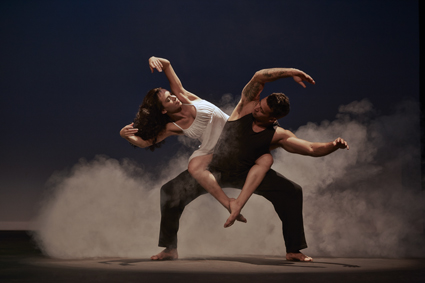
Mokuy (Spirit)
photo Glenn Campbell
Mokuy (Spirit)
Wailing fills the darkened theatre. These are the lamentations of a woman in grief. As a single spotlight cuts through the dark from left of stage our eyes make out the figure of a woman holding her dead daughter. “Oh my baby girl,” cries the mother, “Oh my baby.”
Mokuy is Gary Lang’s first major work since Goose Lagoon in 2010. ‘Mokuy’ is a Yolgnu word meaning ‘spirit.’ “Mokuy began three years ago after two young children suicided in Arnhem Land, where [Lang’s] family lives.” Initially an expression of grief, “over time the work has developed to become a dedication to all who have passed and my healing for all who feel the pain of loss. Mokuy follows the soul’s journey after death” (director’s program note).
Mokuy moves to and fro between Aboriginal and Western cultures, its music between traditional Aboriginal clapstick and singing and the uniform structures of classical strings and piano, clearly defining each chapter of the work. The choreography is a hybrid of ballet, contemporary dance and Aboriginal dance movements symbolic of animals and of daily life. I was particularly drawn to the women’s digging movements and their power as they slapped at the ground.
Initially the juxtaposition of Western and Aboriginal music was effective but as the format of moving from one to the other was repeated throughout I found myself wishing for more variation, or a contrast in musical style, something to nudge me out of the predictable rhythm I’d fallen into. Unfortunately this never arrived and I was left wondering at the sameness of each stage in this journey through the afterlife.
The dancers’ performances were strong and passionate, perhaps acknowledging the long-term commitment they have made to the development of this work. Gary Lang’s company features dancers with a diversity of cultural and dance backgrounds and this work brought together Aboriginal, Torres Strait Islander, Asian and Western members of the company. Catherine Young stood out as the young girl travelling from death through to the final chapter, Wonderment.
The lighting design is a highlight of Mokuy. Vanessa Hutchins has blended muted tones of purple and yellow to create an eerie world punctuated at times by brilliant white spotlight to dramatic effect. Four sharp white lights, beamed across each other from overhead, create a cathedral-like atmosphere and paint a dappled pattern on the floor, reminiscent of shadows cast by trees.
A screen flown in at the back of the stage featured projections of leaves, clouds, floating seaweed and water lapping at a sandy shore. While the images were engaging and brought the bushscapes of Arnhem Land directly to the stage, once again the repetitive format diluted their impact.
It is clear the thematic material of Mokuy has very personal significance for Lang, which his choreography shared through moments of tenderness. This is undeniably a work of grace, but I felt I was too quickly released from the challenges of death, pain and loss set up in the opening scene. Overall, Mokuy provides tantalising glimpses of an emotionally powerful work, all the while displaying the many strengths of its creative team.
Mokuy (Spirit), Gary Lang NT Dance Company, choreographer Gary Lang, performers Catherine Young, Darren Edwards, Hans Ahwang, Michele Dott, Kyle Ramboyong, Bryn Wackett; Artback NT, Arts Development & Touring; Garrmalang Festival, Darwin Entertainment Centre, 9-10 May
RealTime issue #121 June-July 2014 pg. 32
© Fiona Carter; for permission to reproduce apply to realtime@realtimearts.net
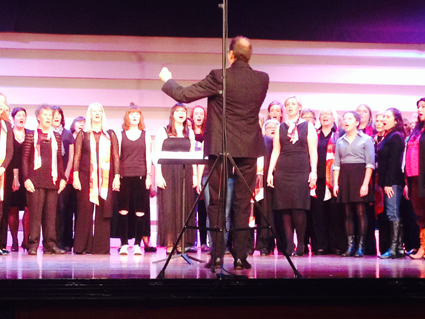
Aurora Chorealis, Song Company
photo Felicity Clark
Aurora Chorealis, Song Company
What’s more courageous: doing something wild where anything is permitted, or doing something vaguely contrary where conventions are still strictly adhered to? If scope and scale matter, then choristers are some of the most dauntless folk out there. As part of this year’s Aurora Festival, participants from the community joined in Aurora Chorealis, a day-long program of workshops and performances, with guidance from Song Company, Scandinavian calling expert Christine Strandli and vocal coach Rachelle Elliott at the Joan Sutherland Performing Arts Centre in Penrith.
These Western Sydney singers put on one hell of a show at the evening concert. But the program was far too long. Much of the repertoire explored diversity and obscurity with a little too much vigour. The exceptional Song Company held our interest with two sets. First their signature repertoire including 13th century chant and a Cantiga from the wise old Alfonso captivated, followed by spectacular contemporary songs of Elena Kats-Chernin and Pelle Gudmundsen-Holmgreen.
After a trip to Estonia with Kooskōlas, a local community choir about to embark on an international tour to sing at the UNESCO Heritage-listed Estonian Song Festival, Song Company returned with a light set of popular song from more recent centuries including an arrangement of Bon Iver’s “Skinny Love” made famous again in 2011 by starlet Birdy. Other recondite diversions came from Sonya Holowell who delivered a committed and expressive performance of Gyorgy Kurtag’s Jozsef Attila Fragments. This confronting modernism, starkly lit and traversing more octaves and emotional vignettes than Eurovision winner Conchita Wurst’s side-show, was followed by Strandli’s rendition of four Sami songs. These Norwegian ditties had subtly shifting tonal centres and were based on non-rhyming poetry without definite structures.
As is often the case at community choral events (this has been my experience as a chorister) there are seldom more in the crowd than on stage. It was a great idea of the festival to reach out to the public by making Aurora Chorealis inclusive, open to anyone to participate, regardless of previous singing experience.
Aurora New Music Festival commissioned two new works for this event’s massed choir. The first, Cooee Karjapasun by Paul Kadak, explored sonic calls common in Australia and Estonia. A cooee might be vocally sounded in the bush to echo-locate or signal to a companion, and a Karjapasun is a type of herding trumpet, nearly two metres long. Folk stories tell us that these instruments are not allowed to touch little boys who instead should play trumpets and horns, and that’s about the only fact available online about them. Needless to say, the Karjapasun entered this aural landscape in foghorny tones. The second premiere, Aurora by Paul Jarman, was sung twice by the massed choir as both finale and encore. Performers had learnt Jarman’s piece from scratch on the day under Roland Peelman’s animated direction. With whispering, stomping and clapping this was the show-stopper.
Unusual repertory. Daring non-uniformity in performance attire. Risqué back-row bop-alongers. Aurora Chorealis showcased the everyday gallantry of the community choir.
Aurora Festival & The Joan Sutherland Performing Arts Centre: Aurora Chorealis, Song Company, director Roland Peelman; Sonya Holowell; Kooskōlas, director Rachelle Elliott; Penrith Conservatorium Singers; Christine Strandli; massed choir Aurora Chorealis, Joan Sutherland Performing Arts Centre, Penrith, NSW, 3 May
RealTime issue #121 June-July 2014 pg. 47
© Felicity Clark; for permission to reproduce apply to realtime@realtimearts.net
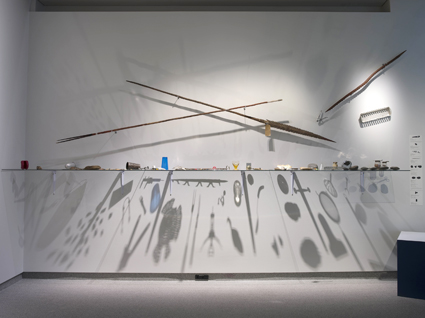
Written on the body, University of Queensland Anthropology Museum
photo Carl Warner
Written on the body, University of Queensland Anthropology Museum
Two exceptional exhibitions at the University of Queensland Anthropology Museum both involve relations between Aboriginal and Torres Strait Islander people and their artefacts and the artefacts associated with European Australia—mobile phones, kitchen tools, hunting tools, potato mashers, shields. Visit and visit again.
Gapuwiyak Calling is a fascinating presentation of Yolngu people (mainly Gapuwiyak community, Arnhem Land) talking about and showing how they’ve used mobile phones as media devices since 3G arrived there in 2008. The standout for me is where the Yolngu have taken ringtones, ditched the defaults, and made them their own as a signal of place and family relations.
“This is a song by my mother-in-law’s brother, especially beautiful as it is a clan funeral song,” says a woman speaking of her ringtone as a moment for deep feeling and sorrow. A young man listens to his favourite band “all the time to feel good,” another to the call of the Green Frog, another to a clan song from a circumcision ceremony, yet another to a ceremony with her father singing. He’s been dead 12 years, she misses him—the ringtone reminds her of him and fills her with sadness.
The oft expressed use of ringtones as triggers for sadness, concern and worry about family is perhaps the most surprising aspect of the show. Contrast with mainstream (Anglo/Euro) culture, where sorrow and worry are emotions to avoid, quasi-taboo, indications of failure in emotional control. For the Yolngu in this exhibition sorrow and worry about family are embraced directly and honestly.
Similarly for the old-style home-movie directness of the short phone videos of kids dancing, the grandpa and grandson going out fishing in the tinny, man and boy using in-camera edits to make a little magic show to send to friends and family. This relatively direct expression of lived experience is now almost impossible to achieve in places where mainstream media dominates the flow of information with non-local imagery and a hubris that can even stake a claim to reality as a genre.
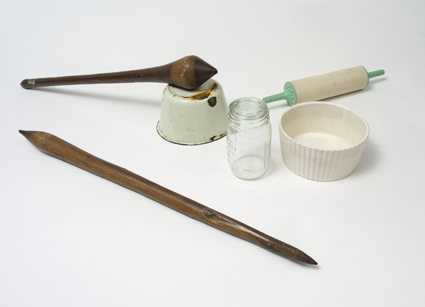
Written on the body, University of Queensland Anthropology Museum
photo Carl Warner
Written on the body, University of Queensland Anthropology Museum
The other exhibition entitled Written on the body, is a collaborative work from artist Judy Watson and the Director of the UQ Anthropology Museum, Diana Young. It is an astonishingly layered, gentle, subtle and visually sophisticated exhibition combining Aboriginal and Torres Strait Islander material culture with well used household kitchenware of the modern suburban era—the toolkits of everyday life spanning the last hundred years or more. Objects are beautifully arranged in small groupings on the wall, on plinths, in “museum quality” cabinets, or on a glass shelf, casting shadows below and along the gallery wall.
Relations within the groupings might be visual (a cylindrical grater next to a club garnished with old hand-forged nails), functional (a clear glass tumbler and a bailer shell) or both visual and functional—pink silicon ice cube tray next to a flat tray-like rock, both having hemispherical depressions for holding whatever the person wants held.
Collected in the early part of the 20th century, almost all the Aboriginal and Torres Strait Islander objects were stripped of their particulars and written on during the collection process. While the show has an underlying critique of this colonial naming and claiming, stripping objects of their social relations not only dehumanises them, but also transforms the objects into signifiers of universal embodiment and through this universality colonial practice speaks against itself.
We see two shields and an aluminium teapot clumped together on the wall—they have handles: the handles are the same in size, the same in shape, the same in ‘graspability.’ A potato masher is placed next to a smooth, graspable rock, both are objects through which the body acts upon the world to pound and soften starchy foods. Such is the underlying humanity of the show, that all bodies across all time are the same body with the same functionality. Stripped of their particulars, of the relation between maker, owner and user, the objects end up not as ‘your’ object but as ‘our’ object, part of the common human heritage of building a toolkit that is fit for purpose, part of the transformation of the world into graspable, scrapable, heftable tools. Needs and goals acting into the world through a world made into tools. By us. For us. Always and everywhere.
Gapuwiyak Calling, curator Miyarrka Media in association with the UQ Anthropology Museum; Written on the body, curators Judy Watson, Diana Young; University of Queensland Anthropology Museum, Brisbane, 15 March-15 Aug
RealTime issue #121 June-July 2014 pg. 48
© Greg Hooper; for permission to reproduce apply to realtime@realtimearts.net
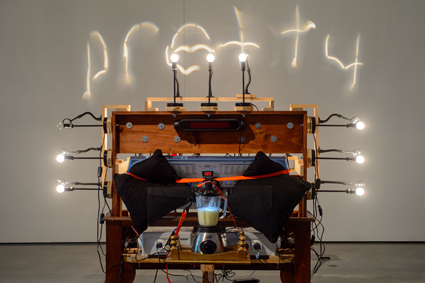
Ian Burns, Blender (2014)
photo David Lawrey
Ian Burns, Blender (2014)
My favourite work in Dark Heart, the Adelaide Biennial, was by Ian Burns—a fantastically large, ramshackle wooden construction, which through seemingly primitive analogue magic, projects images and texts while playing little ditties to itself. Thus, a few weeks later I was very happy to discover that the assorted materials that had been piling up in the UTS Gallery had transformed into an Ian Burns solo exhibition, Too Much is Real.
The pieces in Too Much is Real use similar methodologies to the Dark Heart sculpture but are displayed as smaller, single units. One construction, Blender (2014), presents just that—a domestic blender that sporadically activates, along with a keyboard that plays fragments from the Sex Pistols’ “Pretty Vacant” and ABBA’s “SOS.” A signature technique of Burns is the use of magnifying glasses and light bulbs to project squiggly lines and texts; here he alternates between lyrical fragments from both songs—but timed with the alternated tune. It’s a kind of analogue mash-up. (The exhibition title is also taken from the same Sex Pistols’ anthem.)
Another assemblage, Martha’s Shadow (2010), is an earlier work that uses old household lamps and magnifying glasses to create a static light projection illustrating the primitive outline of a ship—a homage to the one that ran aground while discovering Lake Macquarie, the area from which Burns hails. The third assemblage, Strange Cloud Above (2012), offers a fine example of Burns’ trompe l’oeil technique. A monitor on the front of the assemblage shows a simple landscape scene with drifting clouds, but as you move to the back you see that the image is being created in real time from analogue materials—a strip of carpet, a fan and light refracted through a dimpled salad bowl. The combination of process and product in these assemblages makes them enclosed systems, self-contained micro-universes that are conceptually satisfying yet imbued with poetic ambiguity.
The final work is Breath (AC) (2014), a video which depicts a monstrous corridor at Bunnings hardware store with a single fluorescent light gently swaying in the breeze of the air conditioning. While markedly different from the other assemblages it deftly summarises Burns’ preoccupations with light, simple actions, the found object or experience and a DIY ethic.
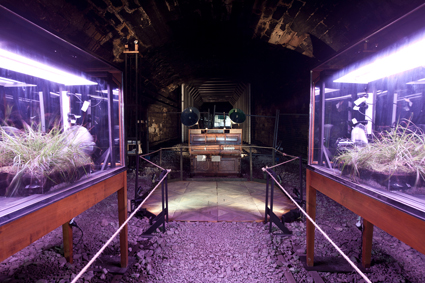
Ian Burns, Extended Stage (2014)
photo Alex Davies
Ian Burns, Extended Stage (2014)
But there is even more to the Burns experience. Delayed by red tape, Extended Stage, a site-specific installation in the rail tunnel behind UTS Gallery, was finally mounted just after the gallery instalment was over. Running down either side of the dark tunnel are four pairs of antique china cabinets. Those on the left contain medium-sized electric pianos which activate in sequence, playing single notes like slowed down Morse Code, amplified by large gramophone horns mounted on top. The cabinets on the right become tiny stages for a series of what Burns calls phenomenological actions: a vacuum cleaner on reverse suspends ping pong balls in the air; a cabinet begins to gush with water; another manifests puffs of smoke; the fourth quietly and patiently freezes. The elemental nature of these images is undercut by the mechanical means of their generation.
This corridor leads you to a final alcove, flanked by terrariums containing grasses blowing in the breeze from a fan. An old ship’s piano forms an altarpiece and as you step onto the scrap wood parquet floor you activate pistons and motors which depress keys rendering a wonky atonal tune. The entire installation is in fact driven by sensors and, rather than using cables, elements are activated by lights, with sequences flashing up and down the tunnel. While outwardly it appears purely mechanical there’s some significant digital programming involved here.
In Extended Stage, Burns’ affinity with objects and materials, his nostalgia for domestic furniture and appliances combined with his mechanical acumen create a wonderful wabi sabi world, one in which machines come with their own rituals. But there’s also a sense of melancholy surrounding these objects and their actions, as though they feel misunderstood, their poetry unheard in the bright daylight beyond the tunnel. I leave Extended Stage feeling for these machines, wondering if there might be something very important to learn from their curious communications.
Ian Burns, Too Much is Real, UTS Gallery 10 March-12 April; Extended Stage, The Goods Line Tunnel, 8-17 April; http://art.uts.edu.au/index.php/exhibitions/ian-burns-exhibition/
RealTime issue #121 June-July 2014 pg. 49
© Gail Priest; for permission to reproduce apply to realtime@realtimearts.net
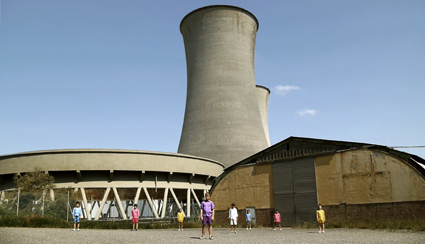
Mikhail Karikis, Children of the Unquiet 2013-14 (video still), courtesy the artist
The title of the 19th Biennale of Sydney, You Imagine What You Desire, may have been a nod to George Bernard Shaw but with its emphasis on psychological and sensory experiences its curatorial philosophy was unashamedly Surrealist. While the influence of Surrealism on contemporary culture is everywhere apparent, its legacy is more contested and as a curatorial strategy for such a heavily scrutinised event as the Biennale it represented a gamble. For while supporters of Surrealism passionately defend its attitude of psychic revolt as binding the world of dreams and desire to social transformation, detractors just as readily dismiss its infatuation with the unconscious as a mere flight from reality.
Like the polarities that separate the proponents and detractors of Surrealism, the 19th Biennale of Sydney has inevitably provoked both positive and negative reactions in equal measure. How much audiences got out of it appeared largely determined by the extent of one’s willingness to surrender to Artistic Director Juliana Engberg’s somewhat esoteric premise that art represents a form of “active desiring.” Given that I hold the first view of Surrealism, I was genuinely excited to encounter a Biennale that in most respects offered compelling evidence for the continued vitality of the movement’s politics of subversive re-enchantment. As expected, moving image works feature prominently across all five principal venues: the MCA, the AGNSW and Cockatoo Island as well as Artspace and Carriageworks. And while thematic concerns ranged from explorations of cognition, memory and psychoanalysis to more humanistic and ethnographic works, the thread of continuity among them was undoubtedly a sustained fascination with film as a medium of sensation.
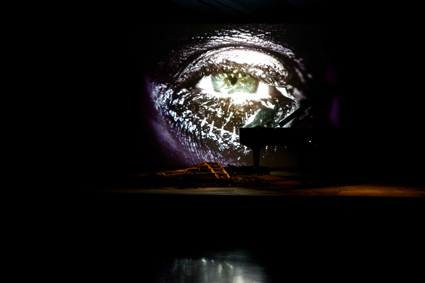
Douglas Gordon, Phantom, 2011
photo Ben Symons, 19th Biennale of Sydney
Douglas Gordon, Phantom, 2011
Douglas Gordon
Since he was one of the first artists to pioneer video art as a conduit to psychic disturbances and disruptions in perception, the invitation to Douglas Gordon to present the Biennale’s opening keynote lecture signalled Engberg’s interest in exploring these themes in Sydney. As the banners and bill posters went up in late March, the disembodied eye of Gordon’s epic video installation Phantom (2011), made in collaboration with musician Rufus Wainwright, cast its uncanny gaze across the city. At the MCA, where cognitive, Surrealist and psychoanalytically inflected works across mediums were arranged in what Engberg termed “proximities and itineraries of encounter,” Gordon’s Phantom engineered a spatially disorienting sensorium. Placed upon a stage was a Steinway and another piano burnt to the ground in a ruinous heap lying beside it, creating an atmosphere both funereal and theatrical. As Wainwright’s heavily made-up eye blinked eerily in slow motion on a luminous white screen the melodious lament of his vocals and piano resounded in the space and the viewer was absorbed in a moving yet impersonal performance of grief.
Pipilotti Rist
Where Gordon’s video work explores the darker undercurrents of the workings of film, memory and the psyche, there was a fascinating dialectical tension between the dystopic Surrealism of Phantom and the engrossing utopian sensuality of Pipilotti Rist’s six-channel high digital video installation, Mercy Garden Retour Skin (2014). Situated on the ground floor of the MCA, Rist’s immersive “video aquarium” enveloped the viewer in a liquid and ethereal space brimming with lush imagery of microscopic and macroscopic views of nature, seducing the viewer with the psychedelic cosmologies of the natural world. Sometimes critically overlooked thanks to their hedonism, Rist’s installations nevertheless reinterpret the Surrealist notion of libidinal excess as a subversive force from a feminist perspective. In overstimulating the senses Rist seeks to dissolve the boundaries of the ego upon which we base not only our identity but also the repressive and disciplinary structures that order the world at large.
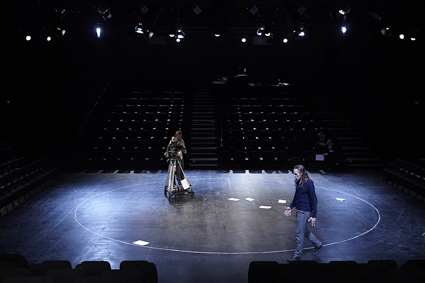
Tacita Dean, Event for a Stage, 2014, presented at Carriageworks in association with ABC RN, courtesy the artist, Fifth Street Gallery, London and Marian Goodman Gallery, New York and Paris, co-commissioned by the 19th Biennale of Sydney and Carriageworks
photo Zan Wimberley
Tacita Dean, Event for a Stage, 2014, presented at Carriageworks in association with ABC RN, courtesy the artist, Fifth Street Gallery, London and Marian Goodman Gallery, New York and Paris, co-commissioned by the 19th Biennale of Sydney and Carriageworks
Tacita Dean
Riffing further on the Surrealist associations, British artist Tacita Dean has remarked that “André Breton once explained ‘objective chance’ as external circumstance acting in response to unspoken desires and demands of the human psyche.” Highly regarded for the conceptual elegance of her rigorously edited 35mm and 16mm film installations, Dean is an artist for whom the workings of chance, or the “lucky find,” has played a determining role in her practice and as a highlight of the Biennale’s middle program the artist travelled to Sydney to undertake the risky venture of her first foray into live performance, Event for a Stage (2014). Dean insists that she never pre-plans or storyboards her films, preferring to work from a state of chaos in an indeterminate artistic process that threatened to unravel as she moved into the scripted, rehearsed and ritualised world of theatre.
The opportunity to present a performance work was prompted by the inclusion of Carriageworks as a Biennale venue partner and in response to Engberg’s invitation Dean devised the intriguing meta-theatrical scenario of casting an actor to play himself in the role of an actor. The experimental undertaking was accepted by British film, television and theatre actor Stephen Dillane though not without trepidation. Not only was the project lacking in the usual credentials that an actor relies upon to assess a role, like a script and a story; even a week out from the first programmed performance details of its content remained scant prompting speculation of tensions between the two collaborators. As it turns out, these tensions were productively utilised by Dean who turned the mismatched expectations between actor and artist into the ‘middle ground’ where the limits of what delineates visual art from theatre were bravely tested in a highly exposed fashion.
From the outset, Event for a Stage strategically blurred the lines between artifice and real life. At each performance audiences were seated in the round and the stage simply comprised a circle drawn on the ground with white chalk. Costumed in a periwig and white face powder (which varied slightly with each performance) and wearing a modern top and trousers, Dillane was immediately present on stage, stalking the perimeter of the circle as the audience entered the space. There was a tense atmosphere in the theatre as if we had stumbled into a dress rehearsal or trespassed onto a movie set as two cameras stationed on tripods and manned by crew filmed the performance in real time. As Dillane switched between a kaleidoscope of personas, veering from Shakespeare’s Prospero and a version of himself to readings from Heinrich Von Kleist’s On the Marionette Theatre, it became apparent that the central drama in fact lay in the antagonism between the actor and the artist who had cast him in this most unsatisfactory of roles.
Seated in the front row of the audience, Tacita Dean periodically slipped Dillane pieces of paper (which he sometimes snatched) with notes that probed the inner workings of the actor’s process and her own. In her recent film works Dean has largely worked with ambient sound, however Event for a Stage represented a return to narrative and the spoken word. Intertextual references abounded and the storm of The Tempest, which of course is not a natural phenomenon but a product of Prospero’s magic, particularly resonated with Dean’s concern to reveal the artistic process as artifice, an illusory surface that says more about the preoccupations, obsessions and desires of the conjurer than it does about any objective reality or subject portrayed. In one sense falling short (one suspects deliberately) of presenting a satisfying conclusion that resolved its disparate parts, Event for a Stage nevertheless succeeded in the most difficult task of absorbing the audience in the drama of its self-reflexive concerns. Its coup was to turn the precarious uncertainties of the artist’s encounter with the medium of theatre into a disquieting meditation upon the performative nature of art, identity and life itself.
At Carriageworks
Not only propelling Tacita Dean’s courtship of chance into the risky terrain of theatre, the inclusion of Carriageworks as a venue and partner also provided the Biennale with expanded space in the form of a newly opened Bay. Previously leased as a film studio, Engberg responded to the recent filmic origins of the space with screen-based works that charted surreal currents between the structures of the cinema and the psyche. In its dark nocturnal ambience there was a scenic reconstruction of a Disney children’s classic in Mastering Bambi (2011) by Dutch duo Broersen & Lukács; a trippy journey into the repressed artistic alter-ego of an architect in Henry Coombes’s I am the Architect (2012); and an uncanny remediation of the 1930s Hollywood musical in Mathias Poledna’s A Village by the Sea (2011), among other works. Particularly impressive was Brisbane artist Daniel McKewen’s Running Men (2008-14), a five-screen installation that composited footage of running scenes by Hollywood’s leading men, such as Harrison Ford and Tom Cruise, onto black backgrounds. Divorced from their original context and suspended in a repetitive motion the running scene was exposed as a mere special effect that nevertheless embodies a powerful ideal of masculinity shaped by, and reflected in, action film culture.
Where the video installations at Carriageworks sought to subvert the entertainment values of film to illuminate cinema as a psychic space of fantasy and desire, nearby the presentation of The Long Program was more subdued. A rolling two-day program of films by artists working with feature length or documentary style and screened in a dedicated theatrette, many of the films were drawn from Northern Europe and could be situated within the ethnographic turn in video art characterised by research-driven projects that use non-actors and involve extensive collaboration and low production values. In the selection of films that I caught not all projects transcended the ordinary but those that did, such as Renzo Marten’s confronting journey into the spectacle of poverty in the African Congo, Episode III (2008), were reminders that artist documentaries can make important interventions into the dominant perspectives circulated by mainstream media.
On other screens
While these ethnographic works provided a counterpoint to the more spectacular larger-scale moving image installations, there were also a number of humanistic gems scattered across other venues. Over on Cockatoo Island, the post-industrial site provided an evocative setting for the screening of Mikhail Karikis’ Children of Unquiet (2013), a stunning portrayal of a group of young Italian children occupying a recently abandoned workers village located in the vaporous terrain of an industrialised geothermal region in Tuscany. In a haunting collage of human, industrial and geothermal sonorities the children’s voices, movements and their uninhibited play reactivated the disused village, releasing a sense of potential amid its industrial ruins. At the AGNSW, Australian video artist Angelica Mesiti’s In the Ear of the Tyrant (2013-14) similarly sculpted space with sound. In the cathedral-like space of a 20-metre high limestone cave in Sicily, the artist engaged an Italian singer to perform a traditional lamentation. As the acoustic properties of the cave amplified the intensity of the vocalised mourning, Mesiti’s video offered a powerful connection to a lost tradition of catharsis rarely expressed in the modern world.
The Surrealists believed that in liberating the world of dreams, the unconscious, the irrational and those two key terms in the Biennale title, imagination and desire, they might prise open a more enchanted reality. World events extinguished their optimism, yet whether subliminally courted through objective chance or returning unbidden in moments of heightened affect and visual shock, the 19th Biennale of Sydney revealed to what extent sensation, rather than mere perception, continues to shape our encounters with contemporary art. In this respect You Imagine What You Desire was indeed a Biennale of “lucky finds.”
You Imagine What You Desire, 19th Biennale of Sydney, Artistic Director Juliana Engberg, Museum of Contemporary Art, Art Gallery of New South Wales, Carriageworks, Cockatoo Island, Artspace, Sydney, 21 March–9 June.
RealTime issue #121 June-July 2014 pg. 50-5
© Ella Mudie; for permission to reproduce apply to realtime@realtimearts.net
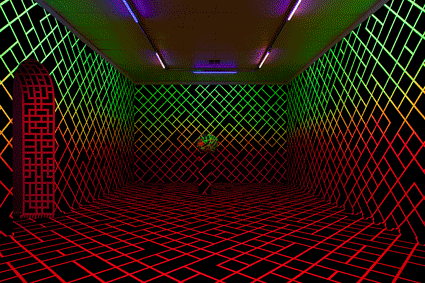
Sam Songailo, Digital Wasteland, CACSA
photos Emily Taylor
Sam Songailo, Digital Wasteland, CACSA
The gracious old stone house in the leafy inner Adelaide suburb of Parkside—the Contemporary Art Centre of SA’s home for around half a century—has been the subject of several exhibitions intended to address its architecture and its function as an exhibition space. For example, CACSA Contemporary 2013: Provisional State Part Two comprised works by James Dodd, KAB 101 and Johnnie Dady that deliberately filled the three main internal spaces so fully that viewers hardly had room to move, drawing attention to the limitations of the space for exhibition.
The latest occupation of the building is by the now Melbourne-based Adelaide graphic designer turned visual artist Sam Songailo whose oeuvre recalls 20th century abstraction, especially 1960s Op Art and Geometric Abstraction. Songailo’s Digital Wasteland is a painting of complex grid-like patterns that covers the entire inner walls and floor of the gallery, much of it in dayglo colours under UV lights. Vividly expressionistic colour contrasts create a shimmering, disorienting effect and there are many subtle nuances in the patterning. Here and there are coloured sticks leaning against the wall—strips of MDF cut from the temporary walls Songailo painted for CACSA’s New New survey exhibition (2010)—and there is a video of the painted walls and floor of his contemplative 2013 Zen Garden installation at Adelaide’s Fontanelle Gallery. By incorporating fragments of previous work, Digital Wasteland becomes a study of his work. Songailo also makes abstract paintings and some of these adorn CACSA’s walls, referencing the gallery’s exhibition format and subject matter of earlier years.
In eschewing narrative or direct political commentary, Songailo’s work offers a return to optical experience, extended here into spatial experience. In calling to mind the work of Bridget Riley and Victor Vasarely, it reconsiders Modernism and revitalises the technological sublime. But in contrast to his previous installations and extensive public art (at a train station, in a car park, on a road and under a bridge) there are discordant elements in Digital Wasteland, for example, the gestural blurring of some passages of paint, which disrupt its mathematical precision and restore, the human element. His addition of pictures on the wall, the sticks and the video, the smeared paint and the use of colours associated with street art distance Songailo’s work from the formal closure and perfection of high Modernist Geometric Abstraction, reminding us of the inevitability of imperfect reality. This isn’t a virtual world, nor the return of the Modern after all. Digital Wasteland contemplates a post-digital world.
Songailo’s installation is nicely complemented by Zoe Kirkwood’s installation in the CACSA Project Space adjacent to the main building. ENTER EXCESS: Space Invaders combines dazzlingly coloured painting with mechanical sculpture. The publicity states it’s intended to “…engage with notions of contemporary excess and superabundance…” and the transposition of “the visual extravagance and opulence of 17th century Baroque into a contemporary art format…” This is a very different theme from Songailo’s, but the juxtaposition of Kirkwood’s work with his creates a powerful resonance that generates great interest in formalist art. Among numerous other prizes, Kirkwood, from the University of South Australia, has recently been awarded the $35,000 Dr Harold Schenberg Art Prize at the 2014 Hatched: National Graduate Show in Perth.
Sam Songailo, Digital Wasteland, Zoe Kirkwood, ENTER EXCESS: Space Invaders, CACSA, Adelaide, 24 April-24 May
RealTime issue #121 June-July 2014 pg. 52
© Gail Priest; for permission to reproduce apply to realtime@realtimearts.net
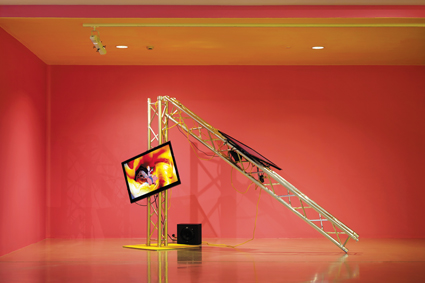
TV Moore, Pig GIF, 2014
photo Zan Wimberley
TV Moore, Pig GIF, 2014
Typically the task of a survey is to historicise and contextualise an artist’s practice with the aim of revealing how it has unfolded over time and where it is headed. There was a certain novelty then in the idea of one of the boundary riders of Australian media art, TV Moore, self-curating his recent mid-career survey, Rum Jungle, at Campbelltown Arts Centre. While expecting an exhibition that was a bit out of the ordinary, it was a surprise to discover to what extent Moore had engineered what was essentially an anti-survey, a kaleidoscopic romp designed to pervert the conventions of the survey in the most delirious and disorienting fashion possible.
Having transformed the gallery’s white walls into a lurid candy-coloured space, Rum Jungle was worlds apart from the pared back gothic spectrality of the video works for which Moore became renowned during the 2000s. With no catalogue or wall plaques the viewer was encouraged to explore the galleries intuitively rather than programmatically. Predominantly comprising Moore’s recent hyperactive cartoon animations, colour-saturated psychedelic painting-photographs and light box imagery, Rum Jungle’s presentation of mainly new work was lightly contextualised by a condensed presentation of Moore’s earlier body of work.
For all its claims to happy anarchy then, Rum Jungle actually appeared a brave refusal on the artist’s part to reify his own practice. The works were not chronologically arranged, however the inclusion of a handful of earlier pieces provided clues as to how to decode the exhibition’s logic. A key work in this respect was Moore’s 2009 video installation, What Say U Wii?, a single projection portrait of an adult video gamer in a blond wig and oversized nerd glasses who riffs into the camera on the merits of Wii vs Nintendo DS. Filmed against the distinctive green of the chroma key screen, a trigger for the gallery’s brightly-hued walls, the juxtaposition of an adult slacker persona with the soundtrack of a young boy’s voice projected a sense of dislocated identity that anchored Moore’s concern in Rum Jungle to explore the psychological implications of virtual immersion.
TV Moore has long exhibited a preoccupation with the subliminal elements of screen culture. His recent transition to animated video extends these concerns albeit in the more spatial medium of cartoons, in which moving figures exist in a state of a-temporal flux, rather than in the more temporally complex and richly allusive medium of film. For the presentation of two animated GIF works, Pig GIF (2014) and Bike GIF (2014), Moore installed the pair of animations on flat-screen monitors placed at crooked angles on a partially collapsed piece of metal scaffolding. In Pig GIF a man clutches a beer in one hand and rides cavalierly upon the back of a pig cantering horizontally across the screen while a visual collage of sexy consumer imagery pulsates in the background. Banal yet seductively hypnotic, the sped-up time of the GIF amplifies the alienation of the surface and signals the dystopia of psychological space constituted by repetition and depthlessness.
The trope of the outsider figure has underpinned some of Moore’s most memorable works such as his acclaimed video cycle The Neddy Project (2001-04). While not an explicit feature of Rum Jungle, the outsider was present in a few guises including in a pair of future primitive light box images featuring the artist inhabiting the identity of hermitic painter Ian Fairweather. One of the Fairweather images was sited near Moore’s suite of nine cibachrome print paintings, Rum Jungle Series (2014), deepening the allusions to outsider art in the works. In this suite of abstracted art brut-style portraiture, Moore melds recurring motifs like the free-floating eye with broad gestural brush strokes and thick drips and smears of paint. Yet in presenting the paintings in the smooth high-gloss finish of the cibachrome print the sensuality of the painted surface is negated and transformed into a more standardised photographic serialisation.
While Rum Jungle allocated generous space to the new works, the history of Moore’s video practice was largely confined to the darkened interior of a single room with the atmosphere of a time capsule. The effect of pulling together several multi-channel installations into an assemblage of videos screened on old analogue television sets was of a polyphonous quoting and sampling of past projects. The aural assault of the sound bleed between videos was not conducive to focused viewing, although one work presented fairly discretely was The Dead Zone (2003). More than a decade after its initial presentation the portrait of a possibly hunted man stumbling and tripping backwards through a deserted cityscape still conveys a palpable sense of post-millennial unease.
Rum Jungle presented itself as an intoxicated and chaotic ramble through a psychedelic fun parlour but ultimately its seductive surfaces were a ruse. Across a decade of video practice, TV Moore peered into the dark recesses of screen culture as a void into which we project our desires only to have their fulfilment endlessly deferred. Rum Jungle did not suggest an abandonment of these concerns but continuation in a new guise—the manic intensity of its trippy animated world was far from innocent whimsy but confronted the viewer, rather, with a discomforting harbinger of the inevitable alienations of a depthless future.
TV Moore’s Rum Jungle, Campbelltown Arts Centre Sydney, 22 March–25 May
RealTime issue #121 June-July 2014 pg. 53
© Ella Mudie; for permission to reproduce apply to realtime@realtimearts.net
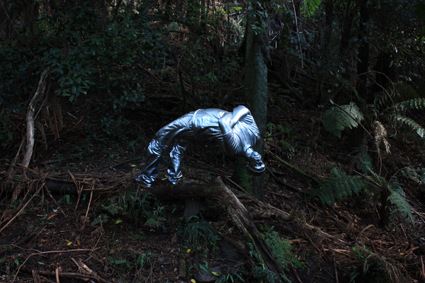
Louis Pratt, A Backwards Attitude
photo Katerina Sakkas
Louis Pratt, A Backwards Attitude
It begins with a dive 310 metres down into the lush Jurassic rainforest of the Jamison Valley. From here you disembark onto the Lilli Pilli Link, a winding boardwalk which takes you on a 30-minute stroll through the forest past the 30 sculptures comprising this year’s Sculpture at Scenic World.
The competition, now in its third year, faces considerable environmental and aesthetic challenges presented by the highly sensitive nature of its rainforest location. Even some of the mossy rocks, my guide tells me, harbour ecosystems which have taken millions of years to evolve. The weight of artworks must be taken into consideration to avoid soil compaction. The entire exhibition takes an intensive three weeks to install and remains in situ for another three.
Alongside these environmental concerns stands the aesthetic problem of how to make artwork resonate conceptually and visually in such imposing surroundings. To attempt to make a bold statement is almost futile; the forest tends to dwarf sculptures, to swallow them up. Most artworks selected by this year’s judges—Anthony Bond, Binghui Huangfu and Richard Goodwin—have been designed to emerge subtly from the brilliant tangle of vines, foliage and rocks. Encountering even the larger works among the abundance of natural forest detail is like stumbling across some small natural curiosity on a bushwalk: a nest or a cluster of berries.
A few of the most effective pieces are not immediately prepossessing but gain power the longer you look at them, raising questions about the relationship between man-made and natural. In Jacqueline Spedding’s winning entry Transcend, a large cluster of white flowerpots hangs in a state of discolouration and decay from the sinewy branches of a tree vine and spreads onto the ground below. At first glance the effect is slightly jarring: an impression of tacky intrusion. But pause a little longer to examine these distressed production-line objects—each actually an individual ceramic piece crafted by Spedding—and an uneasy meditation on the fragile barrier between the domestic and the wild arises.
A similar theme is apparent in Network Breakdown by DoGsWooD, a work which first assails the eye with an awkward collection of what appear to be steel aircon ducts, or perhaps filing cabinets, sprawling down a small slope. As with Spedding’s work, however, a closer look reveals the organic taking over in the form of an extensive root system joining box to box and blending into the environment, connecting the machine-made to the earth in a display of Cronenbergian mutation. In a further twist, while the boxes appear to be steely the entire work is sculpted wood.
This masquerading of the hand-made behind a deceptively machined appearance reaches its peak in Louis Pratt’s contorted life-size figure, A Backwards Attitude. Metallic, slick and out of place, yet strangely confident in its prehistoric forest surrounds, it’s a 3D print, the very definition of hands-off process—until you learn that Pratt himself built the printer that realised the sculpture.
While these three works occupy an interesting grey area between artificiality and nature, other sculptures fall on either side of the more straightforward divide between minimalist abstraction and idiosyncratic whimsy. CULKIN+GEYER’s Uh-uh! A forest! A big dark forest, cuts through the intricate curves of the landscape with hard-edged bars of colour, suspended yet heavy to the eye, while around the corner Ana Carter’s Dream Catchers, assembled from mattress frames and other found objects, demonstrates a more personal engagement with flora and fauna. Continuing the whimsical strain, Todd Fuller’s pastel ceramic bunny men enact a dark tableau, adding a note of subversive weirdness.
The feature sculpture in the exhibition, Ken Unsworth’s Harlequin’s Shuttle, isn’t easily categorised. Commissioned especially for Sculpture at Scenic World by curator Lizzy Marshall, the work’s title describes it aptly. In an elegant pattern of coloured perspex it rises, ever so slightly off kilter, in the manner of some exquisite stained glass sci-fi religious monument, alternately glowing and dulling with the changing light. The lyrebirds apparently love it.
The lone sound work in the exhibition, Three Phases of the Dark Moon, is located within the darkness of a reconstructed coal miner’s hut on the boardwalk. David Sudmalis has composed a sonorous melodic piece incorporating infrasonic sound; the sombre quality lends itself to meditation while simultaneously underlining the closeness and darkness of the hut. To enter is to escape the sheer scale of the forest for a more intimate space redolent of recent human history.
There’s a sense at Sculpture at Scenic World that spectacle isn’t the main game here; a welcome absence of brashness that can afflict other open-air sculpture competitions. Thanks as much to curator Lizzy Marshall and the considerable efforts of the installation team as to the artists involved, this year’s exhibition inevitably draws our attention, in contrasting ways, to the unique environment which houses it.
Sculpture at Scenic World: 2014 Exhibition, Katoomba, 24 April-18 May
RealTime issue #121 June-July 2014 pg. 54
© Katerina Sakkas; for permission to reproduce apply to realtime@realtimearts.net
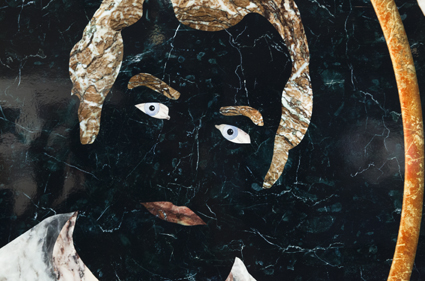
Gary Carsley, D.106 The Annunciation (Whitlam in China), detail, 2014, courtesy the artist and Thatcher Projects, New York and Torch Gallery, Amsterdam
photo Jennifer Leahy
Gary Carsley, D.106 The Annunciation (Whitlam in China), detail, 2014, courtesy the artist and Thatcher Projects, New York and Torch Gallery, Amsterdam
“It’s Time.” With this slogan Gough Whitlam swept to power as Labor Prime Minister in 1972, ousting a stale and stagnating Liberal government that had ruled for 23 years. Whitlam delivered his “It’s Time” speech at Blacktown, home of this exhibition in Blacktown Arts Centre. The exhibition title, It’s Timely, suggests the need for another leader with Whitlam’s vision. He was our last visionary politician (some say our first) and his legacy looms large over the deep shadowland into which the damaging shenanigans and budget carve-ups of the Abbott-Hockey leadership are currently casting Australia.
Just as Whitlam prophetically stated, his government was going to change the country so definitively, and so rapidly, that any incoming Liberal government would never be able to change it back again, so Abbott and Hockey seem hell-bent on a copy-cat approach—the dark inverse of Whitlam policy.
Whitlam ended the lottery of conscription and our participation in the Vietnam War, gave us a multicultural policy, promoted feminism, championed the rights of Indigenous Australians, introduced universal health care through Medicare and a multitude of other access and equity reforms. His abolition of university fees replaced a system in which only the rich, or those winning the prestigious Commonwealth government scholarships, could attend (if you missed out you signed a bond and attended through a teachers’ college). He scandalously approved the purchase by the National Gallery of Australia of Jackson Pollock’s Blue Poles for a million dollars (an investment now worth infinitely more). He bought art—astounding given that during the long Menzies years money for the arts was so tight that the government could refuse credit for any sums over 10,000 pounds, crippling the Australian film industry. The Liberals attacked Whitlam, calling him Father Xmas. Now, as fast as they can, the Abbott-Hockey team is ripping through the social fabric, tearing apart as much of the Whitlam legacy as they can.
It is therefore fitting that, in the current political darkness, this exhibition pays tribute to Whitlam and to kinder, more egalitarian times. Deborah Kelly’s devastatingly cynical banner, THE BILLIONAIRES UNITED WILL NEVER BE DEFEATED, lies on the floor, a direct hit at the likes of mining magnate Clive Palmer, now in parliament, and Gina Rinehart who infamously paid her workers to faux protest Kevin Rudd’s super-tax on big mining—respectable first world countries like Norway tax big mining at 70% to compensate for environmental damage. Hockey-Abbott just abolished the mining tax. It’s open slather now to destroy the Great Barrier Reef—only falling coal prices can save it from the ravages of shipping.
Kelly’s banner lies on the floor, ambivalently a thin ray of hope. The billionaire rulers have been defeated and don’t need their banner any more, or, more cynically, more reflective of the contemporary times, it’s discarded because they have won. Kelly’s work symbolically holds the ground of defeat, an abject centrepiece that eclipses its own hope, and tilts in the direction of rule by magnates. It lets us know we are living in politically dangerous times—when much is being taken away, even though thousands of citizens, including the Knitting Nannas (KNAG, Knitting Nannas against Gas in the Northern Rivers region, NSW), war veterans and even members of the priesthood are on the barricades, getting arrested in far away places out of sight of the media, in rural backwaters like the Pilliga and the Liverpool Plains as they try to protect our precious farmland and water from the predations of big mining and coal seam gas fracking companies. The people might have had a recent minor win at Bentley in NSW, but the tide is hardly turning.
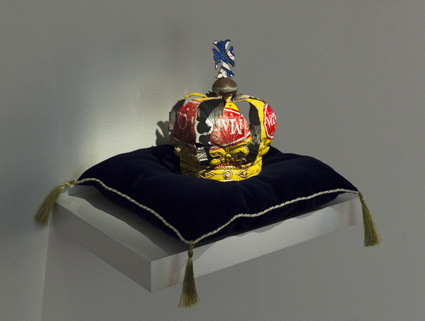
Isabel and Alfredo Aquilizan
Common-wealth: Project Another Country #130010FFS, 2014, courtesy the artists and The Drawing Room Gallery, Manila
photo Jennifer Leahy
Isabel and Alfredo Aquilizan
Common-wealth: Project Another Country #130010FFS, 2014, courtesy the artists and The Drawing Room Gallery, Manila
Common-wealth (Project: Another Country) by Isabel and Alfredo Aquilizan, arranges a series of tin crowns of state—one from a recycled sign for Vegemite—in mock reference to a tourist visit to see the Crown Jewels in the Tower of London (a rite of passage for Australian royalists). In respect of curbing our evolution towards a Republic, one of Abbott’s first acts was to re-instate knight and dame honours. This work’s nod to the English Crown reminds us that its Australian representative, the Governor-General, John Kerr, infamously sacked the Whitlam government during an unprecedented double dissolution of Parliament when the Liberals blocked supply. Ironically, the Abbott-Hockey team are now potentially facing the same fate.
As political commentary the exhibition is subtle and spot-on, not overtly laboured or burdened with metaphor. A room dedicated to memorabilia from the It’s Time event includes a poster signed by Whitlam, a video and copies of his original 1972 speech. Local wedding photographer Anthony Berbari has produced a series of portraits and images of Blacktown locals who were present for the historic event, revealing shocking details that as late as 1973, under a state Liberal government, much of ‘westie’ Blacktown did not have basics such as sewerage. Whitlam fast-tracked a National Sewerage Program.
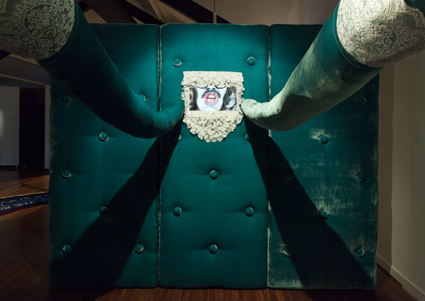
Aunty, 2014, courtesy the artists and Neon Parc
photo Jennifer Leahy
Aunty, 2014, courtesy the artists and Neon Parc
Perhaps in oblique reference to the sewerage situation circa 1972, the King Pins’ Aunty with its giant boxing gloved hands reaching out from the wall to ‘rip your bloody arms off,’ has a mouth, or an anus (say the room notes), speaking onscreen through a giant pair of lacy underpants. The message is scatological—politics is crap—as a moustached mouth, recalling Grahame Bond in bad drag in the ABC TV cult comedy The Aunty Jack Show (1972-3), slurs its way through snatches of pop songs which circulate in the media in much the same way as political promises or threats: “Your time is gonna come,” “This could be the last time,” “If you fall, I will catch you, I’ll be waiting, time after time”—and in respect of being politically done over—“Do it to me one more time.”
Countering the cynicism, Gary Carsley’s D.106 The Annunciation (Whitlam in China) sets into stone in ‘pietre dure’ inlay technique the historic meeting between Whitlam and Mao in the Chairman’s Bejing library in 1973. Asked by Mao whether he would dare a revolution, Whitlam replied he believed in evolution. Consisting of banknote-proportioned twin panels, in one the faces of both leaders are blacked out, the work simultaneously glorifying but also erasing these men. Who remembers or even knows the personages portrayed on our currency? The work wryly suggests that perhaps it’s time for a Whitlam bank note, but more importantly for re-evaluation of our political history and future.
It’s Timely co-curators Gary Carsley, Paul Howard, Blacktown Arts Centre, 29 April-28 June
RealTime issue #121 June-July 2014 pg. 55
© Ann Finnegan; for permission to reproduce apply to realtime@realtimearts.net
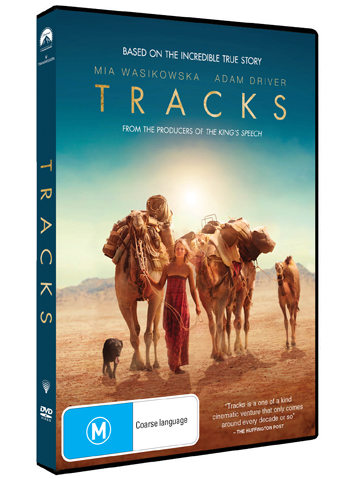
DVD: Tracks
Director John Curran and screenwriter Marian Nelson’s adaptation of Robyn Davidson’s book Tracks recounts the young writer’s epic solo trek from Alice Springs to the Indian Ocean with her four camels and dog Diggity. Australia’s Mia Wasikowska (Alice in Wonderland, Jane Eyre, Stoker) plays Davidson and American actor Adam Driver (Girls, Frances Ha) appears as the New Yorker and National Geographic photographer Rick Smolan who flew in from time to time to document Anderson’s achievement. The film conveys the power of a challenging landscape few of us will ever experience.
5 copies courtesy of Transmission Films
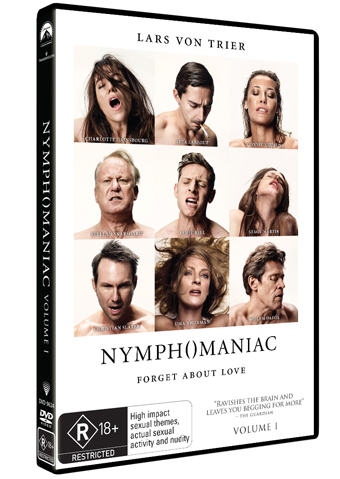
DVD: Nymphomaniac, 2 DVDs
Some people love the films of Lars von Trier, others hate them. Some like certain of his films and loathe others. I couldn’t engage with Dogville but I took to Melancholia. Reactions around the world to Nymphomaniac are similar, some critics rejecting one of its two parts in favour of the other. The film is the third part of von Trier’s ‘Depression Trilogy’ after Antichrist and Melancholia. Supporters love the filmmaker’s ambition (the unfolding of life from birth to 57 years), his obsessiveness and willingness to go into very dark places, even where they find the violence and sex scenes too extreme. The film’s full running time, as shown at the Berlin Film Festival, was five and half hours; the “international version,” comprises two volumes and totals four hours on two DVDs. KG
5 copies courtesy of Transmission Films
Please note you can nominate for ONLY ONE GIVEAWAY.
Email us at giveaways@realtimearts.net with your name, postal address and phone number.
Include ‘Giveaway’ and the name of the item in the subject line.
RealTime issue #121 June-July 2014 pg. 56
© RealTime ; for permission to reproduce apply to realtime@realtimearts.net
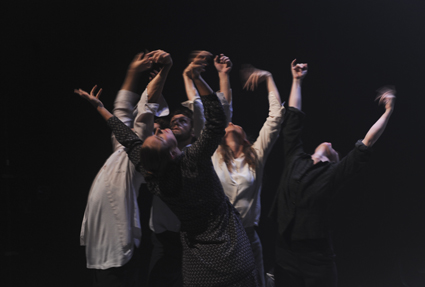
Safety in Numbers, Samantha Chester
photo Heidrun Löhr
Safety in Numbers, Samantha Chester
Samantha Chester’s Safety in Numbers is as much about trauma as it is about hope. The dance recalled for me a fragment from Voltaire’s response to the Lisbon earthquake of 1755: “Man in the field with wounds all covered o’er, Midst heaps of dead lies weltering in his gore…Yet in this direful chaos you’d compose. A general bliss from individuals’ woes?” Voltaire questions God’s existence in his poetic proof for the problem of evil while Chester explores with physical acuity the paradoxical presence of bliss, beauty and human resilience in the aftermath of disaster.
We see and feel turbulent bodies rocking and bobbing in ones, twos and as five catapulted into a world no longer concordant with perceived balance. Among the strewn chairs and floating debris, the figures hold up their world with lengthy stillnesses—corporeal fortresses which then tilt at slight angles, splintering off their vertical axes and either falling to relocate weight or being caught in the embrace of another. Clutching, pulling, resisting, yielding, couples intimately press fear and hope in their skin-to-skin pas de deux to resuscitate each other. A contrast is felt between frenetic floor sequences that crash and roll out erupting forces and the measured, crisp folds of straightened limbs that tip and reach beyond the rubble: poised, silent, serene. Elbows carried at right angles to the body form a unique gestural language that supports hands blunted at wrists, not cleanly, but with a twisting atrophy. From intermittent trembling, arms softly wave above the head while torsos torque in individual and group collapses with a gnarled root-like quality. All movements absorb and show the shock.
Rumbling earth sounds are ripped in foley-like fashion by a deafening urban materiality, cracking and splitting through. Composer Ekrem Mülayim (see p46) sustains this sonic tension throughout, seeming to mirror our fragile inner scramble beneath a ‘sky that is falling.’ We hear the voices of actual survivors of disasters telling their stories. They sound remote, steady, but safe. Danielle Micich recites her nightly activities over and over, struggling to remember at first, then finding flow in repeated utterance. It is a reminder of how we seek stability in clinging to our everyday routines: surviving the disaster of being.
The dance smoulders in a grey-green haze. This McCubbinesque light—like one might see in a mid-Western bush setting in Southern NSW—provides an atmosphere that distorts time and place: we are everywhere and nowhere. Chester and her collaborators create an impression of catastrophe, rather than narrating an event. Movement, voice, colour and sound are finely balanced to form images that resonate in the mind days later. The final scene sees Micich exhaust a joyful, whimsical jig centre stage. She whips up the flotsam with the aid of fans which encircle her. Plastic bags undulate like jellyfish in a column of air. The image is mesmerising and we are left feeling lighter—blissful even. Trauma curls toward hope in the aftermath.
FORM Dance Projects, Dance Bites: Safety in Numbers, director, choreographer Samantha Chester, performers-makers Danielle Micich, Gavin Clark, Ryuichi Fujiruma, Anya Mckee, Simon Corfield, designer David Fleisher, sound Ekrem Mülayim, Lennox Theatre, Riverside Theatres, Parramatta, 9-12 April; http://form.org.au
RealTime issue #121 June-July 2014 pg. 32
© Jodie McNeilly; for permission to reproduce apply to realtime@realtimearts.net
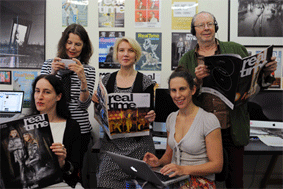
The RealTime team, 2014: standing, Virginia Baxter, Gail Priest, Keith Gallasch, seated Katerina Sakkas, Felicity Clark
photos Heidrun Löhr
The RealTime team, 2014: standing, Virginia Baxter, Gail Priest, Keith Gallasch, seated Katerina Sakkas, Felicity Clark
We celebrate our 20th birthday with reports on our first and second decades, messages of support from well-wishers and a RealTime cover decrying the Howard Government Budget cuts of 1996 alongside a 2014 Budget update.
Prominent choreographer Paul Selwyn Norton, the new Director of STRUT—now refurbished as The National Choreographic Centre of Western Australia—reveals his program for 2014 and into the future, building on his international connections
Deborah Ely, CEO of Bundanon, outlines her vision for the former Arthur Boyd estate which offers artists creative inspiration while she and her staff work closely with local communities and agencies to benefit the region with distinctive workshops and very special events that draw on the local environment and Aboriginal heritage.
Gail Priest ventures to Muttama in regional NSW for The Wired Lab’s Wired Open Day to experience projects by artists, ham radio operators and the Harmonic Overtone Community Choir.
Keith Gallasch applauds ‘We’re People Who Do Shows,’ Back to Back Theatre, a very special new book which combines informal history, interviews, scripts, academic essays, personal statements, excellent photographs and fine design. It’s a tribute to a great company, an excellent resource for audiences and students and the kind of book that is all too rare in its documentation of Australian performance.
RealTime issue #121 June-July 2014 pg. 3
© RealTime ; for permission to reproduce apply to realtime@realtimearts.net
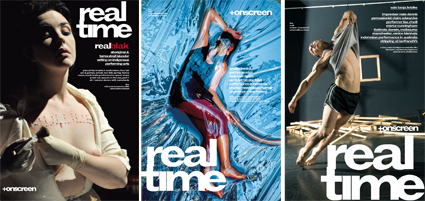 We’re exhilarated. We’re dispirited. Here we are celebrating 20 years of RealTime’s support for adventurous Australian art. “Exhilarated” at the thought of artists’ prodigious output, ceaseless inventiveness, resourcefulness and increasing connectedness across the nation. “Dispirited” because the previous Labor Government’s promised increase of mostly new cultural funding, $263m over four years, will not be realised by the new Coalition Government.
We’re exhilarated. We’re dispirited. Here we are celebrating 20 years of RealTime’s support for adventurous Australian art. “Exhilarated” at the thought of artists’ prodigious output, ceaseless inventiveness, resourcefulness and increasing connectedness across the nation. “Dispirited” because the previous Labor Government’s promised increase of mostly new cultural funding, $263m over four years, will not be realised by the new Coalition Government.
Instead, current funding levels for the Australia Council, Screen Australia, ABC and SBS will be radically cut. Worse, the hard-fought Creative Australia National Cultural Policy, the first new vision for the arts in 20 years, will doubtless be disappeared from public view. Worst of all, the independent artists who have been the principal subjects of our coverage will be the most disadvantaged by the cuts—the budget papers dictate that only forward-committed grants (eg for triennially-funded organisations) be maintained (see p15), guaranteeing that artists join the poor, the Indigenous, people with disabilities, the un-well, single parents, the unemployed and many others as the targets of Prime Minister Tony Abbott’s cold-blooded ideological assault. His nostalgia for Knights and Dames, his implementation of Sovereign Borders (headed by a General), his commitment to John Howard’s Intervention (realised first by the Army) and his passion to have “a hands-on, practical, grassroots environmental action” Green Army ($525m) of the unemployed fill out a self-portrait of Abbott as the great Culture Warrior.
One thing of which we are absolutely certain from 20 years of observation, and something we ourselves experienced making performance and creating the magazine, is that culture is not created top-down. Yes, artists are patronised, rewarded, funded and appropriated by those in power, but they make new art, new forms and new ideas that regenerate and challenge the status quo, mostly quietly, sometimes loudly. Without them, major arts organisations stagnate. Look no further than the last decade in which artists from small theatre ensembles and contemporary performance groups around Australia have worked their way into major theatre programs abetted by a few artistic directors who recognised real creativity or aided more recently by those who in acts of apparent beneficence, like MTC’s NEON seasons of independent works, fanfare their belated embrace of the new. This is not to say that major organisations cannot be innovative: we certainly review works and events where we think they’re pushing at boundaries, but we know where that creativity has come from.
For over two decades we have witnessed the emergence into prominence of many young artists who often received their first media attention on the pages of RealTime. But the path to success has not been easy: grants are often smaller than they were in the 1980s and 90s and certainly worth less in real terms. For example, with rising venue and production costs performance seasons for small companies have become almost ridiculously short providing few opportunities for works to mature. Advertising costs have soared if compensated for somewhat by the rise of social media, and not a few artists have turned to rapidly multiplying, intensely competitive crowd-funding schemes. On the other hand, development programs and co-productions with arts centres and touring possibilities are greater than ever before.
As artists poured out of the tertiary education sector annually in their thousands, the Labor Government channelled many millions into small Artstart grants, up to $10,000 each for university or TAFE graduate artists. But where were they to go once they’d benefited from travelling, researching, forming partnerships and creating an ‘arts business’? Apply for diminishing funding? Fight for space in inadequate arts infrastructure? At least the shortage of arts funding was acknowledged by Labor Arts Minister Simon Crean in 2013 promising new cultural funding of $263m over four years including $75m to the Australia Council.
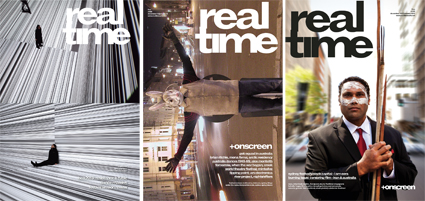
There have been valuable infrastructure developments across the decade: for example the Mobile States touring program operated by Performing Lines for a consortium of enlightened arts centres and organisations. There’s the MAPS program developed between the states and the Australia Council for arts agencies to work with small groups of artists and companies to facilitate touring and to relieve management pressures. The Australia Council funded emerging producers for several years. On the international front, the linking of Australia with IETM, a European organisation committed to the exchange of ideas and the sharing of visions rather than simply marketing works, has been developing steadily over recent years, culminating in the Asian Satellite meeting recently in Sydney and Melbourne with attendees from across the country and overseas. In line with these developments, something we have noted is a greater entrepreneurial spirit in young artists, doubtless born of necessity but also putting to good use the networks they have built or which are offered them. We marvel at their survival and successes.
State government cultural policies and budgets are large determiners of the state of the arts in Australia (they provide at least 60% of all funding). The horrendous slashing of the arts budget in Queensland, cutting adrift youth arts organisations and MAAP (Media Art Australia Pacific) among others creates a nasty precedent for other states to follow suit, especially now that the Prime Minister has made clear his intentions. We suspect however that most states have learnt that their own voters are not inclined to see the arts punished. We live in hope.
From contemporary performance to live art
Hybridity, the impetus for our creation of RealTime, is evident these days across the arts from mainstream to marginal. Dominant artforms remain intact but are no longer the same having more or less effectively absorbed other forms, new technologies, engaged more directly with live audiences as active participants, expanded their scope for collaboration and responded in myriad creative ways to their habitats.
Successful intercultural collaborations between white and black artists in theatre and performance have created some fascinating hybrids—too many to mention—in which conventional formulae are discarded. (Equally, as revealed in our RealBlak edition in October 2012, Indigenous artists wish to create and write about works in the performing arts that are their own, not subject to appropriation and respectful of their cultural protocols.)
In the 2000s European and UK arts festival directors like Maria Magdalena Schwaegermann (formerly of the Hebbel Theatre and Zürcher Theater Spektakel) and Helen Cole (In Between Time, Bristol) were some of the first to fully recognise the unique capacity of Australian artists to cross artform borders in ways only slowly acknowledged here and often resisted in Europe. Where are we now that contemporary performance (version 1.0, My Darling Patricia, post, Branch Nebula and others) and independent theatre (The Hayloft Project, Black Lung et al) have found increasing mainstream attention? Contemporary Performance continues to be a force with new companies emerging and doing things in new ways. But a significant change is embodied in the slow but sure rise of live art in Australia.
Our RealTime residency at In Between Time in 2006 alerted us to just how extensive the development of Live Art was in the UK. We had known about it through LADA (Live Art Development Agency, London), Glasgow’s National Review of Live Art and New Moves International; Brisbane Powerhouse Artistic Director Zane Trow’s 2002 National Review of Live Art event in partnership with New Moves International; and The National Review of Live Art, Midland, Perth, 2005. These early efforts to engender the form in Australia simmered away until various artists began to come together through a range of events. We came home from Bristol forecasting live art’s emergence in Australia. It was often low budget (invaluable with ever shrinking funding) and highly portable, a wild mix of forms and a DIY mentality and opening performance to all kinds of practitioners—artists or not.
We were about to witness a new wave of hybrid practices and inventiveness. Enlightened Australian arts centres and organisations saw live art coming and ran with it. Stephen Richardson at Melbourne’s Arts House programmed it (with visiting UK artists) and made it part of Culture Lab. At Performance Space, Fiona Winning produced the Liveworks festival. Daniel Brine, a former staffer at LADA, followed her as director and pushed it further, encouraging site work. Jeff Khan’s two Next Wave Festivals demonstrated a multitude of the form’s unpredictable possibilities. Jude Anderson’s PUNCTUM in Bendigo, The Castlemaine Festival and the Regional Arts National Conference Kumuwuki/Big Wave, in Goolwa (SA) in 2012 all revealed that live art was not the exclusive province of urban artists. Exist-ence in Brisbane and other cities brought together performance art and live art while in Sydney PACT’s Tiny Stadiums and Underbelly increased live art’s visibility. Performance Space has taken it outdoors in Micro-Parks, Emily Sexton’s Next Wave embraces live art, and Perth’s PROXIMITY Festival is a feast of one-on-one live art engagement. The high point has come with Angharad Wynne Jones at Arts House instigating a biennial Festival of Live Art (FOLA).
Just how far live art will reach in terms of sustainability and influence is hard to predict. It has infinitely less box office earning capacity than contemporary performance which for the most part has hybridized the theatrical experience. It certainly has the potential to be widely experienced and to provide creative models for a new generation of artists and not just those from the performing arts. There are physical games where the artist does not appear, but simply provides instructions. The audience is increasingly becoming direct participant, collaborator, maker and performer, indeed the subject of many works where their senses, perception and judgment are tested. The sensory and physical dimensions of these experiences provide a welcome antidote to the principally visual world of the screen—something that the most innovative of digital artists likewise challenge.

The RealTime team, 2014: standing, Virginia Baxter, Gail Priest, Keith Gallasch, seated Katerina Sakkas, Felicity Clark
photos Heidrun Löhr
The RealTime team, 2014: standing, Virginia Baxter, Gail Priest, Keith Gallasch, seated Katerina Sakkas, Felicity Clark
What about us?
RealTime has grown substantially in its second decade, rolling another 60 bi-monthly editions off the presses and mining our considerable cultural capital to produce additional print publications and freely accessible online archives rich in the history of two decades of innovative practices. We produce more and more content with the same two full-time staff and three part-timers across the decade. Madness. But all of us are artists, quite un-alienated from our labours in art, writing, editing and producing RealTime. Constantly engaging with art that plays with perception, intensifies sensation and sidetracks judgment makes it all worthwhile. As do invitations to arts festivals to conduct writing workshops around the country and overseas from Bristol to Vancouver to Jakarta to Darwin (see p16).
It’s been our great pleasure to witness the growth of inner city, suburban and regional arts centres with their often inspiring programs, supporting and cutting across artform practices. Regional artists can no longer be regarded as the poor relations of city practitioners, as our coverage of the Riverina continues to reveal. We’re inspired by the creations of artists with disabilities. We admire those artists who are turning their media art-science works into interactive tools for palliative care and pain relief. We are impressed by artworkers like Kim Machan in her continued efforts to keep Australian media arts in the loop in Asia. We are excited by the growth of national touring and networking, barely evident a decade ago, allowing us to see more works once at a great distance from us—except on the pages of RealTime. We pay tribute to ADT, Lucy Guerin Inc, Circa and many others who represent the inventiveness of our culture overseas.
We worry about diminishing studio hours for artist students in our universities and the threat to their careers by a new government so wary of art. We lament the limited engagement in the arts between Australia and Asia. Much goes on, often quietly as with Asialink and 4a, or in the shape of the Asia Pacific Triennial and the Adelaide Festival Centre’s OzAsia (defunded in the Abbott-Hockey budget) and a variety of funded programs and in the ongoing work of Rosemary Hinde. But for the greater public, Asian art is still something you might encounter in an art gallery or occasionally in an arts festival.
Doubtless we’re in for tough times, but artists will fight to keep our heads above the rising sea levels denied by the Abbott Government.
Our thanks go above all to Gail Priest, our Online Producer and, for many years, Associate Editor, a great collaborator and friend. Thanks too to Felicity Clark, our administrative assistant, Katerina Sakkas in advertising sales, previous online producers Josephine Skinner and Caroline Wake, assistant editors across the decade Michelle Moo and Mireille Juchau, and Graeme Smith who created the first design for RealTime and continues to re-invent our look.
Particular thanks go to our Board of Management: Tony MacGregor, John Davis, Julie Robb, Philippa McGuiness and Urszula Dawkins and former member David Young. We always look forward to our meetings with them and appreciate their encouragement, not least in these challenging times for publishing. Special thanks to our many wonderful writers across Australia (some have been with us 20 years, some this edition), advertising clients, the Australia Council, Arts NSW, our sponsor, Vertel, and above all our readers.
For the next 20 years, whatever it takes!
Keith and Virginia
RealTime issue #121 June-July 2014 pg. 4-5
© Keith Gallasch & Virginia Baxter; for permission to reproduce apply to realtime@realtimearts.net
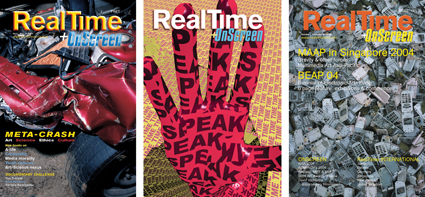 RealTime has its origins in discussions around a dining table in inner city Sydney in the early 1990s. These were long conversations (often well lubricated with a bottle of red) about the need for the performance community to develop a forum where work could be properly documented, connections made, lineages understood and the achievements of artists acknowledged through supportive and informed criticism.
RealTime has its origins in discussions around a dining table in inner city Sydney in the early 1990s. These were long conversations (often well lubricated with a bottle of red) about the need for the performance community to develop a forum where work could be properly documented, connections made, lineages understood and the achievements of artists acknowledged through supportive and informed criticism.
There were a lot of people involved in those early conversations, many of whom remain close to the magazine, as writers and supporters. But RealTime is above all the realisation of the vision of two extraordinary people, the owners of that dining table. Twenty years ago Virginia Baxter and Keith Gallasch were acknowledged by their peers as intellectual and creative leaders in the world of contemporary performance. Twenty years down the track RealTime is a well oiled machine, and it’s hard to imagine the intellectual and physical energy, the courage and the commitment it took for two artists best known as writers and performers of ambiguously autobiographical ‘real’ stories to reinvent themselves as publishers and editors, responsible not just for filling the magazine with words and pictures, but also for selling ads and chivvying late running writers, and the myriad tasks that go to getting out a regular magazine on a shoestring budget with a small team. Twenty years down the track Keith and Virginia—along with Gail Priest, also an artist and editor who joined the core RT team in 1998—remain at the helm, seemingly indefatigable.
To Keith, Virginia and Gail, the contemporary performance (theatre, dance, live art, music theatre, physical theatre) and media arts communities in Australia owe an enormous debt.
On behalf of the Board of Open City, I want to acknowledge the generosity, commitment, imagination and hard work of these three wonderful individuals without whom…. Thank you.
Tony MacGregor, Chair
Open City Inc, Publisher of RealTime, Board of Management: Tony MacGregor, John Davis, Julie Robb, Philippa McGuiness and Urszula Dawkins
RealTime issue #121 June-July 2014 pg. 6
© Tony MacGregor; for permission to reproduce apply to realtime@realtimearts.net
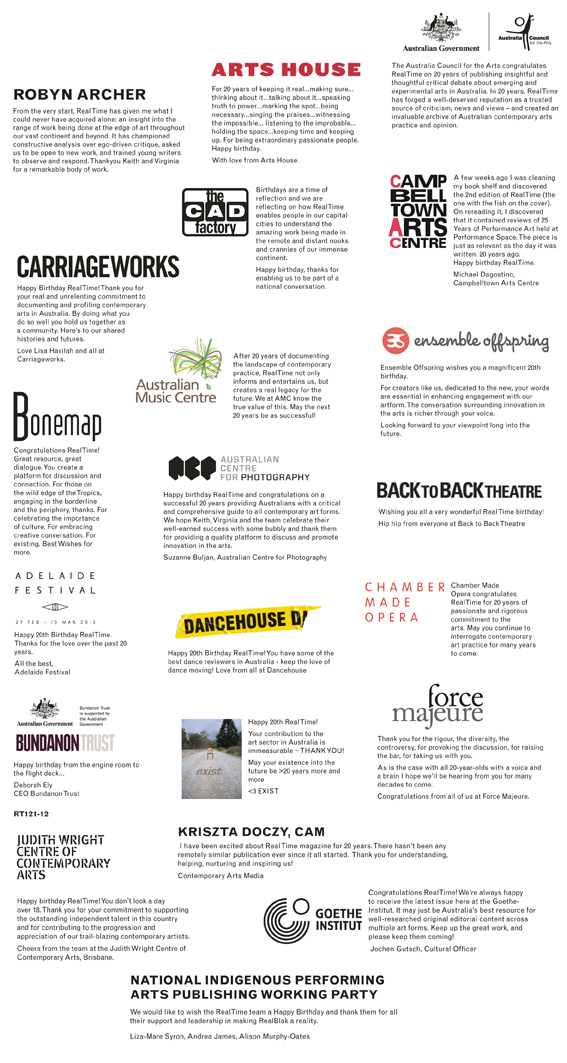
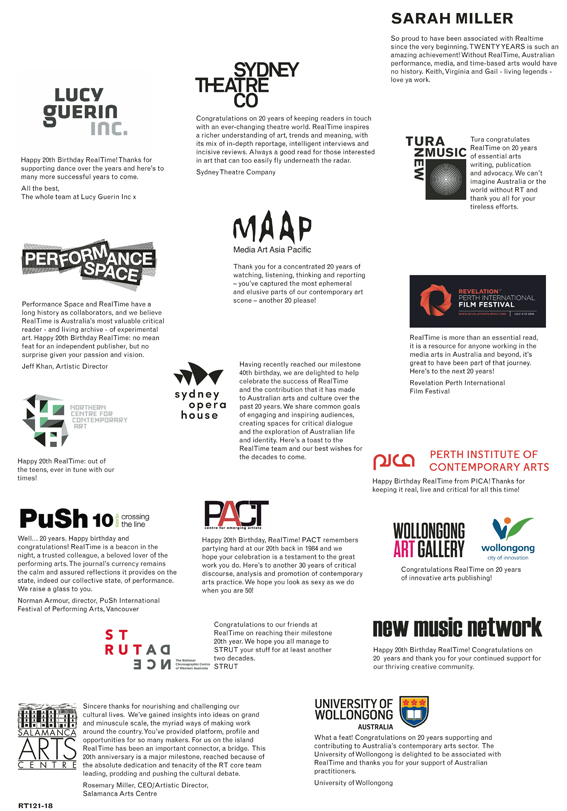
RealTime issue #121 June-July 2014 pg. 12-13,18
© RealTime ; for permission to reproduce apply to realtime@realtimearts.net
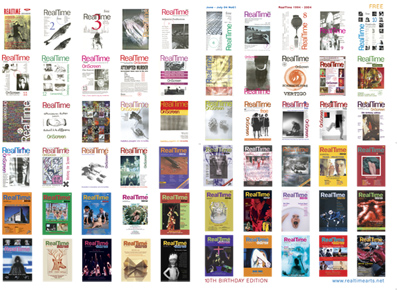 The early years of RealTime now seem like a distant dream, a fuzzy recollection of a fury of creation, learning on the job, reaching out across the country to engage writers and distributors, connecting with artists, knocking out grant applications, labelling bundles and loading trucks, covered in ink, wracked with endless financial trepidation, exhilarated every time an edition rolled off the presses and partying every time (we’re no longer up to that). Final layout happened variously in an old flourmill in Newtown (now home to the Omeo Dance Studio), graphic design studios in Surry Hills and, for years, the crowded city office of Art Almanac with artist Paul Saint patiently at the computer through the long nights.
The early years of RealTime now seem like a distant dream, a fuzzy recollection of a fury of creation, learning on the job, reaching out across the country to engage writers and distributors, connecting with artists, knocking out grant applications, labelling bundles and loading trucks, covered in ink, wracked with endless financial trepidation, exhilarated every time an edition rolled off the presses and partying every time (we’re no longer up to that). Final layout happened variously in an old flourmill in Newtown (now home to the Omeo Dance Studio), graphic design studios in Surry Hills and, for years, the crowded city office of Art Almanac with artist Paul Saint patiently at the computer through the long nights.
Home work
Our home was our editorial office for several years. A remarkable team would gather in the kitchen on a Saturday every two months to edit a new edition: John Potts, Annemarie Jonson, Jacqueline Millner, Catharine Lumby, Gregory Harvey, Linda Wallace and Michael Smith, with contributions from Colin Hood (a dab hand at droll headlines) and Richard Harris. Our first assistant editor (thanks to the enlightened Jobstart scheme) was David Varga. Judy Annear was our first manager, followed by Susan Charlton and then Lynne Mitchell. When RealTime became full-time we divvied up the management among ourselves. Gail Priest, an integral member of the RealTime triumvirate, started out proof-reading for us and moved into layout and design and advertising sales and web management! Having our own office and computers in the city made everything a lot easier. David Varga moved on, replaced by Kirsten Krauth who also took over and developed OnScreen from the pioneering work done by Annemarie Jonson and Alessio Cavallaro. Novelist Mireille Juchau followed Kirsten who went to work for the AFC. Before Gail, the hard yards of advertising sales had been valiantly run over the years by Michelle Telfer-Smith, Sally Thompson and then Sari Jarvenpää. Nowadays Gail and Virginia make an affable sales team.
Consultative editorial teams were set up in all states and some members have been with us for many years: Sarah Miller, Chris Reid, Josephine Wilson, Darren Tofts, Richard Murphet, Philippa Rothfield, Anna Dzenis, Diana Klaosen, Eleanor Brickhill, Linda Marie Walker, Barbara Bolt and Erin Brannigan. Others have come and gone, too many to name here, and, like the current contributing editors, have all been invaluable.
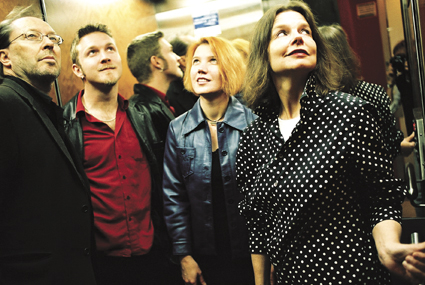
The RealTime team, 2004: Keith Gallasch, Dan Edwards, Gail Priest, Virginia Baxter
photo Heidrun Löhr
The RealTime team, 2004: Keith Gallasch, Dan Edwards, Gail Priest, Virginia Baxter
Motivation
In 1993 we were lamenting the diminishing coverage of the arts in the mass media and, specifically, the lack of engagement with performance, hybrid practices and what we then called techno-arts. It was the absence of a national perspective that irked us in particular. We watched performing arts and then film magazines struggle and collapse over the years. We wanted to know what was happening across Australia, what was innovative and who was making this work. The Performing Arts Board of the Australia Council was offering seeding grants for arts magazines, we got one and away we went. A trial edition in February 1994 was followed by an unbroken string of bi-monthly RealTimes from August that year, once funding was secured. We had argued in our grant application that we wanted to produce a magazine that looked across the arts because we thought that was the only way to survive and, more importantly, that reflected growing cross-artform practice. We were right on both counts. We encouraged readers to look for innovation and to go beyond their particular artform interests. We provided a broader context for artists’ work and the writing about it. At any time almost half of RealTime’s writers are practising artists.
The Big Picture
Over the years we critiqued reports by Gonski (bad news for screen culture) and Mansfield (worse for the ABC), tore into Creative Nation and the restructuring of the Australia Council (quite a stoush), screamed arts murder in the wake of the Howard election (see the cover for RT14), and looked at the cultural ramifications of Mabo and Wik. We’ve addressed issues of censorship, globalisation and Free Trade and countless funding issues. We’ve monitored the growth of the international marketing of the Australian arts, the changing nature of arts festivals, the rise of the improvisation movement, issues and successes in the arts and disability field, and surveyed Aboriginal film and new media. Through Philip Brophy’s inspirational Cinesonic column we all learned to listen to films while Hunter Cordaiy’s Writestuff put us in touch with the complex screenwriting side of our film industry. Kirsten Krauth edited WriteSites, an important record of the literary aspect of new media art. We’ve also surveyed the integration of digital media in performance and dance and extensively reviewed new media artworks and the festivals and conferences that constellate around them here and overseas. Experimental, contemporary classical and improvisational music have always had a place in RealTime. As has sound art, right from the beginning, with a number of the editorial team and some of our key writers in the 90s committed to the field, sometimes as creators for the ABC’s The Listening Room. Associate Editor Gail Priest has maintained our commitment to sound culture with its growing number of young adherents. Recently we’ve addressed the burgeoning video art scene and Mireille Juchau has focused our attention on photography’s return to centrestage.
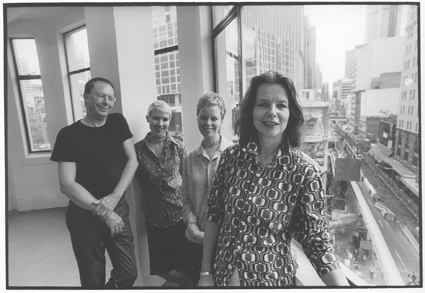
The RealTime team, 1999: Keith Gallasch, Gail Priest, Kirsten Krauth, Virginia Baxter
photo Sandy Edwards
The RealTime team, 1999: Keith Gallasch, Gail Priest, Kirsten Krauth, Virginia Baxter
Diversification
The years of knowledge and data that RealTime had accrued in its files and in the hearts and minds of its editors and writers allowed us to expand our publishing.
We’re particularly proud of editing and producing the In Repertoire series for the Australia Council in collaboration with designer Peter Thorn. These books on contemporary performance, dance, new media, music theatre, performance for young people and Indigenous art are a logical extension of RealTime’s commitment to promoting the work of hundreds of Australian artists, the majority of them innovators and working solo or in small companies. The praise from overseas producers and presenters for the series and the gratitude of artists has been a great reward as has the satisfaction in being a partner with AMD in its vital work. Nor is it just a matter of marketing Australian work to the world: exchange is critical. We have been impressed by the international collaborations initiated by the likes of Elision, Aphids and the PICA-Performance Space Breathing Space program with Bristol’s Arnolfini contemporary art space.
There are never enough festivals and reporting them on the ground, in print and online is a RealTime pleasure, another way to diversify our presence and to meet the artists we write about. We’ve had writing teams at the 1996, 1998 and 2000 Adelaide Festivals, LIFT 97 (London International Festival of Theatre), Asia Pacific Triennial 3-MAAP99, the 2001 and 2003 Queensland Biennial Festivals of Music and Next Wave 2002. This year we’ll also be at BEAP (Biennial of Electronic Art, Perth). We also welcome individual festival reports which come in regularly from Australian artists on their travels.
Bad Signs
The odds have been against artists over the decade. Arts funding has remained static or decreased in frequency for many artists. The positive outcome of the Myer Report is essentially a catch-up for visual artists. Federal government initiative funding for the youth and regional arts has been small scale and held out at election time. Censorship has been on the increase. The threat of Free Trade looms. The film industry struggles on with limited funding and little room for experimentation or vision. Sessional teaching by artists in universities has severely diminished. The commissioning of artists by the ABC has seriously declined across the decade. The managerial model increasingly dominates art at the expense of vision.
Certainly there has been acknowledgment of problems, with funding bodies seeking increased funding and commissioning reports. The Small to Medium Sector Report and Resourcing Dance: An Analysis of the Subsidised Australian Dance Sector, however, proved to be impoverished documents. The recent Theatre Board Report on triennially funded companies, on the other hand, focuses on one strand of organisational practice, clearly defines its problems, proposes what needs to be done and puts a price on it.
However, and this is one of the great ironies, Australian artists have still managed to create an embarrassment of riches, gathering increasing international accolades. This proliferation of art and its successes has so far let governments off the funding hook, but how long before the supply side cannot meet the demand because it is so diminished and so tired? Over the decade, we’ve also sadly watched many talented artists leave the field—quite unnatural attrition.
Good Signs
On the positive side, while federal arts funding in real terms has declined dramatically, state governments over the decade have steadily invested more in cultural funding—though not always reliably—as in South Australia’s funding redistributions and the travails of Melbourne’s ACMI. The Department of Foreign Affairs and Trade’s collaborations with the Australia Council have improved opportunities for the international marketing of Australian arts. Australia’s international arts festivals have featured more Australian work since the Kosky and Archer Adelaide Festivals of the 90s. Idiosyncratic festivals like Next Wave, Artrage, This is not art, Noise and others consistently nurture young talent. 10 Days on the Island and The Queensland Festival of Music (with its wonderful regional commissioning model) have shown how festivals don’t have to be city-centred. They are mirrored by the growing arts strength of Darwin and centres like Launceston, Mildura, Cairns, Newcastle, Lismore and others from which our arts future is emerging. The advent of Artshub, the Quarterly Essay and the forthcoming arts equivalent, Platform Papers, from Currency House provide us with a growing opportunity to build a picture of Australian culture that we can discuss and debate.
The New
In 1994 and again in 1999 we reported the suspicion with which hybrid and new media arts were greeted in certain quarters, not a little because limited existing funding had to be shared with new forms. Much has changed since, in attitude if not funding. Australian works are consistently acclaimed in Europe and elsewhere for their multimedia and cross-cultural innovations. New media might not be that ‘new’ any more but what is remarkable is the constant inventiveness and relative ease with which Australian artists explore the relationship between the physical and the virtual, the potentials of interactivity and computer gaming, and the art-science nexus. It is an increasingly rich site for new ideas and tough-minded social critique and it is happening across all art fields, much of it documented in our pages over the decade. Dance, for all its financial difficulties, has excited with its commitment to new media explorations and a burgeoning dance screen culture. In film the assuredness of Aboriginal film directors (and actors and cinematographers) reveals not only great talent but the success of its nurturing through carefully tailored training and funding schemes, let alone a strong sense of community. And across the board there has been, in the last few years, a real intensification of political and ethical concern evident in the arts, finding its way quickly into theatres and galleries and, through documentary (but rarely feature) films, onto screens.
Virginia Baxter, Keith Gallasch, Managing Editors, RealTime 61 June-July 2004
You can download a full PDF of the 10 year liftout, or you can download specific years.
1994, 1995, 1996, 1997, 1998, 1999, 2000, 2001, 2002, 2003, 2004
RealTime issue #121 June-July 2014 pg. 14
© Keith Gallasch & Virginia Baxter; for permission to reproduce apply to realtime@realtimearts.net
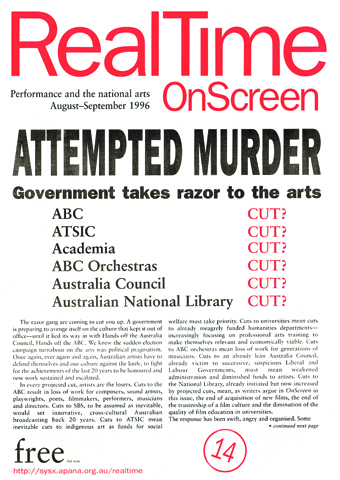
Cover for RT14 – click for larger version
Our RealTime 14 cover anticipated the worst from then Prime Minister John Howard’s Liberal-National Coalition Government Budget of August 1996. It was a shocker, from the closure of the Commonwealth Dental Program (resulting in a consequent decline in the nation’s dental health) to a cut of $470 million from the Aboriginal and Torres Strait Islander Commission (ATSIC) budget, forcing it to close community, cultural ($40m) and youth support programs as well as women’s centres.
Ultimately the Howard Government’s treatment of the arts wasn’t as destructive as anticipated, but for most artists funding levels remained stagnant. The Government was censorious and an Arts Minister side-stepped the Australia Council’s peer assessment requirements to directly fund the Melba Foundation at $1m per annum—this was withdrawn by the Gillard Labor Government in 2012. Worse, there was no vision for the future of the arts in Australia, not until Labor Arts Minister Simon Crean led with Creative Australia—The National Cultural Policy in 2013 with funding promises of $236m over four years including $75m to the Australia Council.
Over four years the Abbott-Hockey budget will cut $30m from the Australia Council, $25m from Screen Australia ($38m with other program losses) and $33.8m of Ministerial cultural programs. Prime Minister Tony Abbott declared, “[Arts Minister George Brandis] has very substantially protected arts funding generally—and literary funding in particular—from the stringencies of these times and in so doing has made himself deeply unpopular with all his colleagues.”
Australia Council CEO Tony Grybowsky told the ABC that this will mean “smaller and fewer” grants to individual artists and cuts to small companies, as directed in the budget [ie grants not forward-committed as in the case of triennial funding]. “[Grybowsky] was relieved that funding for the 28 major performing arts companies would be maintained” (abc.net.au). Already poor artists will now face the government’s stringent new welfare measures.
Howard was not unfavourable to the arts, but we can’t expect the same of Tony Abbott. His first budget signals a revival of the culture wars of the 90s but with a much more comprehensive agenda and much larger view of culture in which science (cuts to the CSIRO and a vengeful dismantling of environmental agencies) and the democratic right to education (the execution of a calculatedy elitist strategy) have been targeted for weakening.
The past has come back with added bite.
Keith Gallasch
RealTime issue #121 June-July 2014 pg. 15
© Keith Gallasch; for permission to reproduce apply to realtime@realtimearts.net
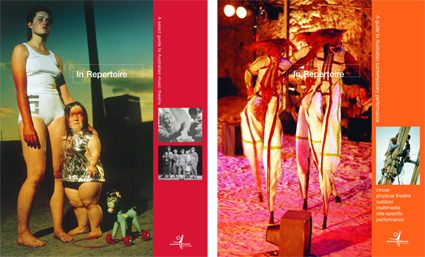
In Repertoire series
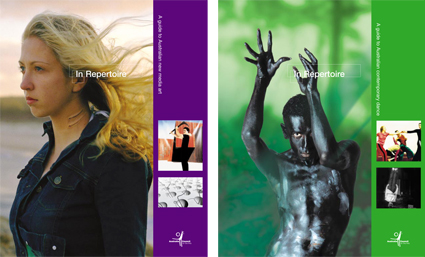
In Repertoire series
Print Publications
In Repertoire Series: Marketing Australian Performance & Media Arts Australia Council & RealTime, 7 booklets (1999-2004)
Explorations, Films D’Indigenes D’Australie, Foreign Affairs & Trade Australian Government, 2002
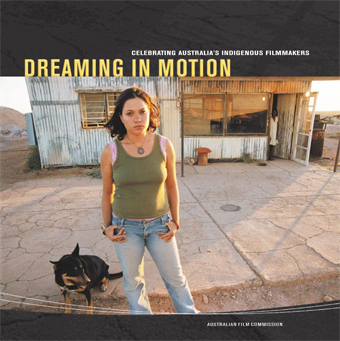
Dreaming In Motion
Dreaming in Motion, Celebrating Indigenous Australian Filmmakers, Australian Film Commission & RealTime, 2007
Bodies of Thought: 12 Australian Choreographers, RealTime & Wakefield Press, 2014
Online
RealTimeDance Archive, 1994-present
Media Arts Archive, 1994-present
RealTime Profiler, 7 editions annually, commenced 2014
Partial Durations, new music blog, Matthew Lorenzon & RealTime
All editions from 2001-present
RealTime Review Writing Teams & Workshops
Since 1996, RealTime has been commissioned to run writing teams and workshops at national and international arts festivals, producing reviews online and in print.
1996 Adelaide Festival
1997 LIFT [London International Festival of Theatre]
1998 Adelaide Festival
1999 Asia Pacific Triennial/MAAP, Brisbane
2000 Adelaide Festival
2004 BEAP [Biennial of Electronic Art], Perth
2004 MAAP [Media Arts Asia Pacific], Singapore
2006 In Between Time festival of live art, Bristol, UK
2007 Ten Days on the Island, Hobart
2007 Lyon Danse Biennale
2008 PuSh International Festival of Performance, Vancouver
2008 DanceWrite workshop, Critical Path, Sydney
2009 Dance Massive, Melbourne
2009 On Edge, Cairns, and Australia Council Induce Workshop
2009 Chuncheon International Mime Festival, Korea
2010 Goethe Institut Regional Critic Workshop, 10th International Indonesian Dance Festival, Jakarta
2010 In Between Time festival of live art, Bristol, UK
[UK team]
2011 Dance Massive, Melbourne
2011 Totally Huge New Music Festival, Perth
2012 Aurora Festival of new music, Western Sydney
2013 Dance Massive, Melbourne
2013 ISEA 203, Sydney
2013 Totally Huge New Music Festival, Perth
2013 Northern Territory Writers’ Centre, Darwin Festival
RealTime issue #121 June-July 2014 pg. 16
© RealTime ; for permission to reproduce apply to realtime@realtimearts.net
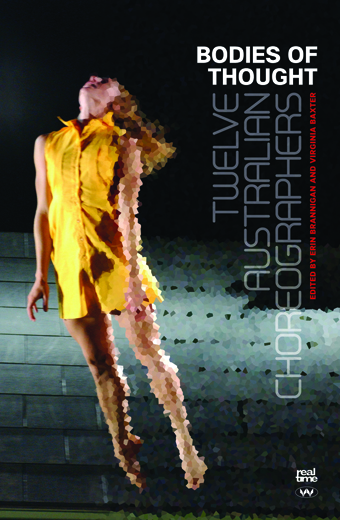 An important new book on Australian contemporary dance, Bodies of Thought: 12 Australian Choreographers features a generation of award-winning, innovative Australian choreographers with international reputations and legacies of influence:
An important new book on Australian contemporary dance, Bodies of Thought: 12 Australian Choreographers features a generation of award-winning, innovative Australian choreographers with international reputations and legacies of influence:
KATE CHAMPION, ROSALIND CRISP, TESS DE QUINCEY, RUSSELL DUMAS,
LUCY GUERIN, SUE HEALEY, HELEN HERBERTSON, GIDEON OBARZANEK, STEPHEN PAGE, GARRY STEWART, MERYL TANKARD, ROS WARBY
Focusing on a work by each artist—with an interview and an essay by a leading dance scholar—this groundbreaking book offers invaluable insights into the creation of remarkable works, at a time when Australian dance is enjoying international acclaim.
Launching in July 2014.
Published with the support of the Dance Board of the Australia Council and the University of New South Wales

As part of the preparation for the book we also created the realtimedance archive.
RealTime issue #121 June-July 2014 pg. 17
© RealTime ; for permission to reproduce apply to realtime@realtimearts.net
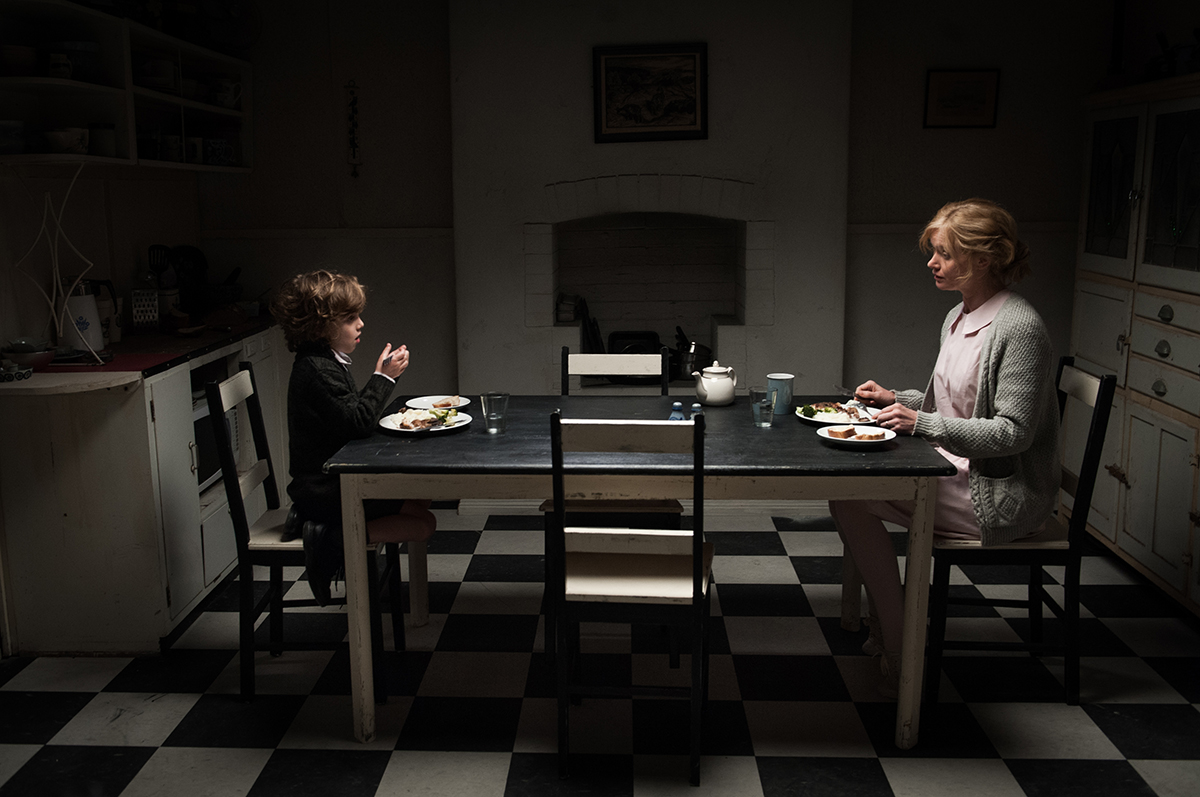
Noah Wiseman, Essie Davis, The Babadook (2014)
The most powerful horror films are underscored by reality, presenting recognisable fears and anxieties in magnified and fantastic form. Writer-director Jennifer Kent’s first feature The Babadook, the newest film to arrive on the Australian horror scene, encompasses within its monstrous narrative themes of loss, the fragility of motherhood and mental illness.
Kent, who has a background in acting and short filmmaking (she also worked for Lars Von Trier on Dogville (2003) to gain directing experience), developed the project for six months at Amsterdam’s Binger Filmlab. From this point it was barely three years before the film was in production. Kent says of the film’s development, “I’d made a short film called Monster, and I wouldn’t say that this film is the extension of that but there’s certainly the seed of Babadook in Monster, this idea of what happens if we suppress our darkness and our painful and difficult experiences. I guess when I was looking for a film that I could make on a modest budget and actually get to the finish line, The Babadook just kept coming back, this idea, this woman and this little boy in a house, so it just grew from there.”
The film’s eponymous monster, while convincingly folkloric—some audience members at the film’s premiere in Sundance thought it was an Australian creature—is Kent’s invention. “I wanted it to sound like something a child could have made up, so it comes in the form of a book called Mister Babadook, which sounds reasonably innocuous, and then develops into ‘The Babadook,’ which is a far more sinister entity.”
The film focuses unflinchingly on the relationship between Essie Davis’ Amelia, who lost her husband the night their child was born, and her young son Sam (Noah Wiseman), a ‘problem’ child assailed by nightmarish fancies which get him into trouble in everyday life. It’s a scenario demanding a great deal of emotional force from its leads, something particularly challenging when one of them is a young child. Drawing upon her professional acting experience and her history as an imaginative child who would write and act in her own plays, Kent was well positioned to support the fledgling actor. She is full of praise for Wiseman’s commitment, but doesn’t understate the difficulties: “It nearly killed me to get that performance on the screen, and I say that with absolute love for him, but anyone who’s directed a six-year-old will know what I’m talking about. They’re very little beings. But the genius in that performance really lies with Noah. He had it there to begin with.”
The transformative role of Amelia requires an actor of Essie Davis’ versatility to do it justice. While Kent didn’t write the role specifically for Davis, the two have been close friends since studying acting together at NIDA. “When you’re casting a role that has this much of a range, you don’t have a pool of actresses that are actually that suitable, so it was really a boon to have her on board,” says Kent.
“She’s very grounded as a person, very strong and full of heart…if the performance became too cerebral, people would disconnect from her; she brings a warmth to a very difficult character to find empathy for, I think, and it made her very human. My job largely lay in toning Essie’s strength down and making her more fragile in the beginning part of the film; then when we got to the end I just let her rip, because she has that power. And she’s not afraid to look less than perfect on the screen; she’s an extraordinarily beautiful woman but that performance is full of all sorts of horrors, and she went there and I owe the film to her and Noah, but her performance was extraordinary.”
Davis’ performance is instrumental in making The Babadook into that rare thing: a horror film exploring a nuanced female perspective; one dealing with motherhood to boot. Kent has been “tremendously moved” by mothers—friends and strangers—who identify with Amelia. “I thought that there would be perhaps a disapproval of her actions in this film from some women, but what I realise is that all mothers feel like that at some point and they all feel not good enough, so I think it taps into what it means to be a mother. Motherhood is a big taboo, isn’t it? It’s a thing we can’t really discuss in regards to not being good at it, or not wanting to do it sometimes, or not liking your child, sometimes even wanting to kill your child on certain days…that’s why I wanted to put it into the horror genre and not just a drama, and to take it further, and it’s worked in that it helps some women connect to it.”
The film’s stylistic approach mirrors the trajectory of its characters, with Kent describing a progression from balanced camera work using wide lenses into a slightly off-kilter world which becomes increasingly Expressionist. There’s a quiet intensity characterising the film which separates it from the manic bombast of much contemporary horror. Kent was inspired by John Carpenter’s The Thing (1982), which she describes as, “a very simple film, [with] a mythical quality to it. There’s no bells-and-whistles and so it gives an audience time to be genuinely terrified. A lot of, say, American studio pics are too crowded; visually, aurally we’re just assaulted and we’re not giving the audience credit for just taking things in on a very simple level.”
Homegrown horror is notoriously difficult to get funded, promoted and seen in Australia. Kent, who speaks positively about the support she received from Screen Australia, believes the fault lies with Australian exhibitors and distributors: “I feel that there is an unwarranted snobbery towards genre in general and particularly the horror genre, so although people can say, ‘Oh well, horror’s not popular in this country,’ it’s actually a fallacy, because it’s incredibly popular. It’s just that people are being forced to illegally download it in order to see it because it’s not on enough screens in our country.”
Of further concern to Kent is the Commission of Audit’s proposal to cut Screen Australia’s funding by 50% and merge it with the Australia Council, a move she believes would lead to the death of film here. “Then not only do we lose all of our independent films and most of our big films, we lose all of the talent being discovered that goes into those independent films. You look at Strictly Ballroom, you look at Chopper, you look at Snowtown—any of these kind of films have birthed some amazing directors, actors, technicians across the board, so we can’t let that happen.”
Kent’s next project is a tragedy set in Tasmania in the 1820s exploring “the true nature of violence and revenge.”
–
The Babadook, writer, director Jennifer Kent, cinematography Radoslaw Ladczuk, music Jed Kurzel; opening night film Sundance 2014; Umbrella Entertainment, Australian release 22 May
RealTime issue #121 June-July 2014 pg. 21
© Katerina Sakkas; for permission to reproduce apply to realtime@realtimearts.net
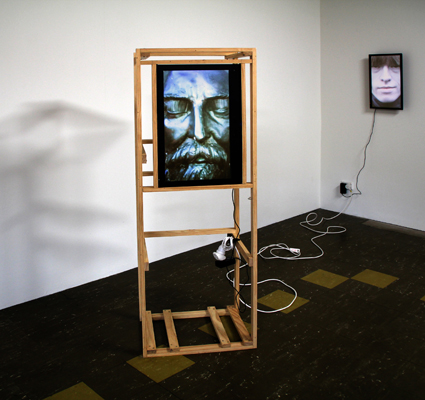
Sue Dodd, Significant Others, 2012
photo Sue Dodd, Anna Pappas Gallery
Sue Dodd, Significant Others, 2012
I missed Sue Dodd’s video Significant Others (2012; a portrait-oriented single screen video, it’s now on her Vimeo page) at the 2012 Melbourne Art Fair. But even when I first heard about the work it felt like a smart, snippy nipple-twist, commensurate with Dodd’s established work. The concept is clear, concise and simple: a parade of animated sculpted bronze busts of Australia’s prime ministers, who each in turn mouth the name of their wife. (It concludes with Julia Gillard mouthing “Tim.”)
A performer as much as an artist, and one with a keen ear for Pop musicality, Dodd has ceaselessly trawled tabloid effects which progressively embalm icons regardless of stature or merit. Their emptied significance is intensified by her artistic appropriation of their eventuated nothingness. I feel Dodd’s point is never judgemental or neo-Maoist in its orientation: for her, pop culture is accepted as fully formed and as unquestionable as those sitting with you on public transport. Lofty leftists often presume any engagement with pop culture is somehow automatically critical within the context of art—they probably don’t use public transport much.
Like all good sharp-and-simple art, Significant Others amounts to more than the type of quips one could find on any two-bit feminist blog—written by some home-dad freelance copywriter for NPOs. The bronzed busts are all filmed onsite at Prime Minister’s Avenue at the Ballarat Botanical Gardens. That place is a ground zero for the dumb meeting between art and politics. Presented to scale and installed at actual height, the busts have the gawky effect of bringing a PM down to the level of ‘the people.’ But it’s a meeting on shaky ground: their post-war workmanlike sculpting (slightly expressionistic, but ultimately bad caricatures) ensures that far from being inspiring figures communing with their public, they now live out a life most ordinary as bad art.
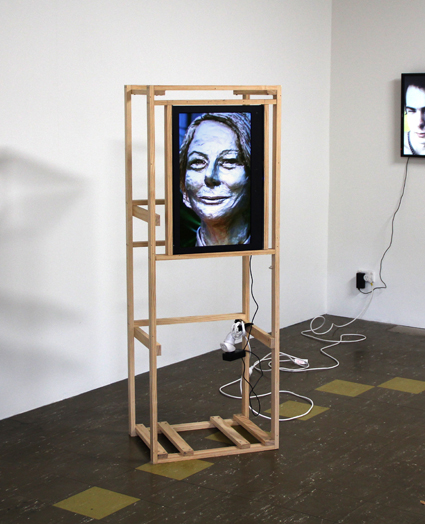
ue Dodd, Significant Others, 2012
photo Sue Dodd, Anna Pappas Gallery
Sue Dodd, Significant Others, 2012
Yet this numbing normalcy generates a perverse hyperreal effect founded on their audiovisual potential: they look like what politicians sound like. Confronting their visage face-to-face evokes hearing a politician talk. And could a PM’s voice —omnipresent in the mediasphere of its life span—be any more lacking in charisma, character, impact? What with their para-schizophrenic vowel-twisting that folds in rural xenophobia, grammar-school smarminess, concerned-parent ethical sighing and cheap filibuster theatricality, the voice of any PM is a choral overload of disingenuous and wasted earnestness. Always unconvincing, you can hear their shitty speech-writers cynically mouthing lame altruisms worthy of the most banal script-writers (without exception.) Looking at these bad bronze busts is like witnessing their collective vocalisation.
Significant Others utilises base-level digital animation (vector-warping zones of the filmed footage to simulate heads tilting and rotating, eyes opening and closing, and mouths parting) to have them enunciate a single name. It brings these dumb heads to life, ordinarily. This is the people (via Dodd the artist) speaking back through the PMs, just as they attempt to speak for the people while speaking through them. The animation is as dumb as the original busts: rather than impressing one with amazing effects and realism, it apes a technical cliché that crudely animates the busts to perform a completely unimpressive feat of magic (the opposite impulse of all current phantasmagoria). No, Toto—we’re still in Ballarat; they’re still a bunch of dead or near-dead PMs; and there is nothing of interest to be born of engaging with prime ministers as if they’re important in the first place.
Well, that’s how I read it when these pathetic heads spookily call their wives’ names, gasping an unfinished sentence on their domestic deathbed, as chirpy morning birds babble in the background. For me, the power of Significant Others is the opportunity it takes not in debunking or mocking the power of politicians, but in emptying them of all power, and rendering them as mere ineffectual partners. As any gender-split 30-something BBQ will prove, wives love laughing at their husbands (despite them marrying the jerks in the first place), and the moaning automatons of Significant Others undress the male PMs as self-important schmos dressed by their wives. But this work is only superficially about politicians and gender issues. The smug mockery which the intelligentsia love so much in critical culture might be attributed to Dodd’s puppeteering of the Ballarat PM busts, but it’s the voicing of the unspoken that emboldens the work. By rendering sonic the aural utterance of an invisible power source within these people (ie ‘the wife’), Significant Others incants solitary names which—like all fatal incantations—actualises the socio-political environment within which political performances are so unconvincingly staged. Under Dodd’s audiovisual palette knife, each name uttered is like their last political breath.
For many, something like the outré nude cartoons of naked PMs in Larry Pickering’s Playmates (instigated in 1978 and ongoing annually for 18 years) is an acceptable marriage between art and politics. But if there’s anything more boring than politicians, it has to be the parasitic media/theory/comedy industries which drip from their collective colon. Just the thought of making a smart-arse crack about a politician—or worse, some investigative exposé of a politician’s ethical infractions—marks your critical wit as deserving of as many Walkley Awards as you can fit up where it hurts. Contemporary Art—perhaps wisely, perhaps snidely—avoids such obviousness. It plays a cunning game of espousing (mostly soft-leftist) neo-global politics without veering too clearly into advocacy or militancy (though sideline supporting and petition-signing exonerate many artists’ political opacity). But both tendencies—the parodic in the former, the poetic in the latter—are so clearly pre-labelled one wonders why they state anything in the first place. Conversely, Significant Others is a precisely attenuated act of name-calling: it utilises an accusatory device to highlight a form of silencing, and does so by defacing the sanctioned monumentalism of honouring the legacy of a nation’s political leaders.
Artists being political is like politicians being artistic. One can only imagine what Sunday landscapes the Ballarat busts created over their combined lifetime. Significant Others sees Dodd reversing the Pygmalion impulse—a pathology founded equally in male artists reconstructing their female muses through breathing life into clay, and in politicised artists believing that their conscionable statements achieve a reality effect purely through them opening their didactic mouths in the mediasphere. In doing so, Sue Dodd breathes politics into Sound Art by refusing to mouth the pseudo-revolutionary self-address endemic to neo/retro-modernist strains of the form. Instead, she lets the art speak for itself.
–
Sue Dodd, Significant Others: Prime Ministers, http://vimeo.com/63632074. Source images were taken on location at the Prime Minister’s Avenue at the Ballarat Botanical Gardens. The exception is the bust of Julia Gillard which was created by the artist for the video.
RealTime issue #121 June-July 2014 pg. 22
© Philip Brophy; for permission to reproduce apply to realtime@realtimearts.net
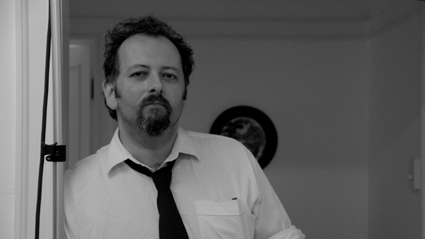
Jack Sargeant
photo Alex Munt
Jack Sargeant
The opening night of the 17th Revelation Perth International Film Festival is fast approaching. In recent years Rev, as it is affectionately known by its fans and audience, has become for me the most exciting and innovative film festival in the country.
Last year’s program was as challenging as ever, with a world premiere-screening of Ben Wheatley’s A Field in England, Italian prog-rock band Goblin playing their soundtrack to Dario Argento’s Suspiria live in front of a pristine new print of the movie, Shane Carruth’s almost impenetrable Upstream Color and a smorgasbord of experimental short films, documentaries and non-Pixar, non-Disney children’s films.
The festival website announces that in 2014, “We look forward to sharing our unique perspective on the world…” But what makes Rev unique? I strongly suspect that a big part of this difference lies in the person of its Program Director, Jack Sargeant. For example, Jack is responsible for at least one ‘first’ in Australian film festival programming. He tells me: “We focus on a lot of independent cinema and there’s always a handful of underground movies in there too. We have the academic conference which is now entering its third year, and that certainly marks us as different—I don’t believe any other Australian film festival does that.”
Unlike most academic film conferences, RevCon places no limits on possible topics for discussion. Last year papers ranged over Russian vampire movies, Iranian cinema, the contribution to film culture of Australian horror ‘zines and a deconstruction of the politics of The Lion King, as well as a special session run by Pozibles on crowdfunding for independent filmmakers. This year the call for papers seeks, among other topics, papers on new and emergent genres, neglected histories and alternative perspectives on any aspect of film and film theory. It is this explorative, experimental spirit that distinguishes Sargeant’s take on cinema. For him, “Cinema should seek to push people into a space in which they are unfamiliar. I don’t think art should be a predictable safety net for vacuous thinking. I enjoy the chaos of possibility.”
Sargeant has been the Program Director of Rev since 2007. There was a lot of excited talk among cinema aficionados when festival director Richard Sowada first announced that Sargeant was going to take on the role: high expectations of challenging cinema, of cinema with an edge. After all, Sargeant is the author of such cutting-edge books as Deathtripping: The Extreme Underground and Naked Lens: Beat Cinema. He has published essays on Richard Kern and Nick Zedd, pieces on J G Ballard and essays on topics ranging, he notes, from “obscure grindhouse movies through to theoretical pieces on body hair that have been published in various academic publications.” Our expectation was that Sargeant would show us films that would jolt us out of our seats, or at the very least cause our parietal lobes to vibrate at a significantly higher rate. Thankfully, these expectations have been well met. Perhaps this is because Sargeant sees his role as that of a curator rather than a program director. I asked him if this is what makes Rev different.
“I think that a program director programs films—choosing movies that reflect what’s going on in the industry and so on. But a curator has a wider conversation, it’s not just about a snapshot of the moment, but about the works and the events around the festival (whether they are talks or conference papers or whatever) and the ways these works are in conversation with each other or perhaps even with works from previous years. We eschew the red carpet culture and we really emphasise the idea of community and sharing ideas.”
This inter-media conversation at Rev is a reflection of Sargeant’s wide-ranging involvement in music, film and the visual arts, something that he has continued to pursue since settling in Australia after moving from the UK. In 2012 he co-curated a photography exhibition at Alaska Projects in Sydney with artist Linsey Gosper, with whom he is presently developing another collaborative performance/photographic work. The creative challenge of such collaborations ensures that Sargeant maintains his ‘edge’:
“As a writer…I feel that it is exceptionally liberating to think in a different medium, because it forces you to engage with practice differently, and it forces you to think differently, which is probably healthy. Over the years I’ve worked in photography and so on, but not in this way.”
He has also started writing a libretto for a ‘noise opera’ with music to be composed by Cat Hope. The libretto is “part of an ongoing process of forcing myself to think in a different manner and pushing myself in a new and challenging way. The process of writing a screenplay and libretto, and simultaneously thinking about cinema or staging, demands a visual imagination and a different application of language.”
And just to prove that too much is never enough for Sargeant, he has been developing a script for a ‘body horror’ movie, “but not like anything people have seen before.” Perhaps this should not come as a surprise; he admits, “when visiting a new town I search out medical museums and outsider art galleries before the established institutions.” Sargeant began this screenplay “to see if I could do it.” When the opportunity arose for him to pitch his horror movie to an audience, evidently “a lot of people felt it went too far. I took that as a positive sign,” he says.
With his latest book, Against Control, a collection of essays on William S Burroughs and related counterculture figures such as Brion Gysin, recently published, Sargeant clocks up more than two years of writing books, articles and essays. His curation of Revelation Perth International Film Festival reflects this intense involvement with cultural commentary and analysis and his championing of independent and underground film culture. At Rev this year we can expect challenging experiments in film such as Rodrigo Reyes’ Purgatorio and Toby Amies’ The Man Whose Mind Exploded, as well as the Adelaide-made feature, The Dead Speak Back. Let the conversation begin.
Revelation Perth International Film Festival, director Richard Sowada, program director Jack Sargeant, July 3-13
RealTime issue #121 June-July 2014 pg. 23
© Leon Marvel; for permission to reproduce apply to realtime@realtimearts.net
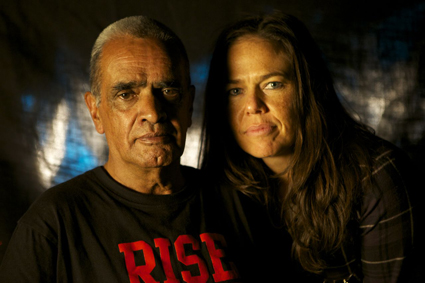
Gary Foley, Darlene Johnson, courtesy Sydney Film Festival
“I wanted to make a film, or a document, that really only presented the Aboriginal perspective on that whole issue. I wasn’t interested in the white perspective or the colonial point-of-view.” Director Darlene Johnson was talking about her documentary Stolen Generations (2000) when she made this statement, but her words could equally apply to her entire body of work.
This is Indigenous history and culture through Indigenous eyes—a celebration, a mourning, and a commemoration of self-empowerment against overwhelming odds. Her latest documentary The Redfern Story, unveiled at this year’s Sydney Film Festival, continues her project with an account of Australia’s largest urban Indigenous community and the cultural and political activism it has fostered.
One of the striking features of Sydney from the late 1960s onwards was the presence of a large Indigenous community that at its height reached 20,000. Aboriginal people, organisations and militancy, as well as an overwhelming police presence and intense poverty were all starkly displayed in Redfern, right on the city’s doorstep. It is this “impoverished community of landless refugees”—to quote one of the interviewees—that Johnson’s film commemorates. Relying on a combination of talking heads and a wealth of archival footage, The Redfern Story does a good job of tracing the rise of activism in the area.
Sydney, as the activist and actor Gary Foley reminds us, was an incredibly white town in the mid-1960s, when Aboriginal people began to drift into the city as the reserve system in rural areas was wound down. The formation of a black community in Sydney’s heart was not welcomed by police, and harassment was constant and brutal. “The beginning of my political education,” Foley recalls wryly, “was when I got a good kicking from a bunch of thug coppers in the Regent Street Police Station.” Indigenous academic Marcia Langton recalls the Regent Street cells on Redfern’s edge were known as the abattoirs : “The cells were covered with Aboriginal blood,” she tells us.
From this violence a Black Power movement arose that set about creating Indigenous organisations like the Aboriginal Legal Service in an attempt to provide a measure of protection for local people. An Aboriginal Medical Service soon followed. A little later, following a visit by actor and playwright Bob Maza to the Black Theatre in Harlem, New York, the National Black Theatre was formed. These organisations provided an incubator for many of the key figures in Indigenous cultural, political and intellectual life, from the aforementioned Langton and Foley, to cultural luminaries like Lester and Gerry Bostock and the Maza family.
Although The Redfern Story makes clear the enmeshment of culture and politics in the heady years of the 1970s, it’s the cultural activities that take centre stage here. The film opens with a skit from Basically Black, the 1973 television version of a highly politicised and satirical stage review that grew out of the Redfern community. There is also an extended discussion of the first Indigenous-written full length play, Robert Merritt’s The Cake Man, staged by the Black Theatre in 1975 and starring a young Bryan Brown alongside the Indigenous cast.
As Gary Foley says at one point, these activities and organisations transformed the world in which a generation of Aboriginal people had grown up. Those living in Redfern in the early 1970s had, after all, spent their childhoods in an Australia in which the reservation system was still in place and the White Australia Policy still very much in effect. Yet for all the sense of celebration in The Redfern Story, there is another tale behind the stunning archival footage, as the film looks back on this period from a contemporary Australia in which so much remains unchanged. Indigenous people as a whole continue to be treated as second-class citizens and poverty remains endemic. In many ways the aggressive drive for political and economic empowerment led by figures like Foley seems to have dissipated, while Redfern itself has been remade and pacified, with gentrification achieving what police brutality could not.
A more critical approach might have provided a fuller, more rounded picture about the lessons to be learnt from the Redfern experience. Why, for example, did the Indigenous organisations formed there have such a dramatic impact on the lives of individuals, while failing to improve the economic lot of the community as a whole? The archival footage also alludes to how many of the key figures in this story died before their time, including the great Charles Perkins and the charismatic actor Zac Martin, but the film itself makes no reference to this sobering fact. At 57 minutes, The Redfern Story simply feels too short to fully do justice to the rich, complex history of the area and the people who made it. Unfortunately the film’s account ends rather abruptly around 1975.
Then again, perhaps it is not yet time for more critical portraits—until a few years ago the only stories told about Redfern on our screens were hysterical reports of riots, poverty and substance abuse. The Redfern Story, like so many Indigenous documentaries of the past 25 years, looks at the other side of the coin. If it feels somewhat uncritical, it provides, as Johnson says, an unabashedly Indigenous take on a slice of Sydney’s history that for years was written in purely negative terms by Australia’s mainstream media. It’s a testament to the work of the Redfern trailblazers that filmmakers like Darlene Johnson are able to make films today in which we are, for once, spared a white perspective.
The Redfern Story, writer, director, producer Darlene Johnson, producer Sue Milliken; 2013 Sydney Film Festival, 4-15 June
RealTime issue #121 June-July 2014 pg. 24
© Dan Edwards; for permission to reproduce apply to realtime@realtimearts.net
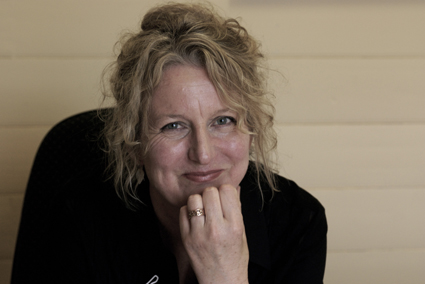
Deborah Ely
photo William Yang
Deborah Ely
Individual artists of all kinds, cross-artform collaborators, dance groups, theatre companies and orchestras: all have enjoyed the beneficence of Arthur and Yvonne Boyd’s legacy to the nation, their one-time property—1,100 hectares of bushland two and a half hours south of Sydney—on the Shoalhaven River. Artists can escape everyday pressures to concentrate solely on creation in incredibly beautiful and isolated surrounds. A composer friend once described sitting by the river that Boyd so often painted and feeling the joy of the emergence of a new composition.
The range of artists and their points of origin, from the local to the international, is astonishing and testimonials to the importance of the Bundanon experience for generating new work are uniformly inspired and deeply grateful.
Deborah Ely, the CEO of the Bundanon Trust is an artist and art historian. She was formerly the Visual Arts and Craft Program Manager for Arts NSW and has been Director of Australian Centre for Photography in Sydney, the Centre for Contemporary Photography in Melbourne, EXPERIMENTA and Watershed Media Centre in Bristol. Ely is an utterly dedicated CEO with an inspiring vision for the Trust, its relationship with the people of the Shoalhaven region and beyond and with Australian artists of the highest calibre, emerging and established, innovative and committed to hybrid art explorations.
The evolution of a vision
I spoke by phone with Ely and asked her about the evolution of her vision, which she saw as “enlarging the already significant cultural capital of the estate”—the Boyd studio, the art collection and the residency program. She says that she became aware of three key issues. “First we are 22km from the nearest town which is economically challenged. Secondly we have Arthur Boyd’s home, his studio and the collection, which is very attractive to a particular demographic and age group, but is not really a strong drawcard for young people or people with families. So we wanted to work out how to engage with different parts of the local population. Thirdly, I had noticed that the main component of cultural diversity in this region is Indigenous. These were the things that struck me and in many ways they have taken us on a very particular trajectory. We’ve done a lot to address these three things. It’s funny that where you start is often where you stay.”
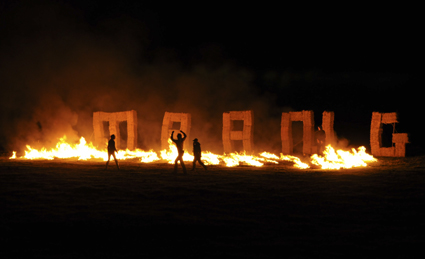
r e a, MAANG, SITEWORKS 2010
photo Heidrun Löhr
r e a, MAANG, SITEWORKS 2010
Attracting the locals
Underpinning the capacity to respond to these needs “was the incredible resource of artists coming here from all over the country and all over the world doing amazing things and finding different ways of sharing them with this regional community.” Initially Bundanon staged concerts and like events—and people came—and then, “we worked with some really great creative producers who analysed what we wanted, who was out there and who we wanted to reach. We produced a mini-festival format with lots of very surprising content for local audiences, pulling together artists as diverse as Kate Miller-Heidke and Jimmy Little—who had a very deep local connection—as well as circus and hip-hop which related strongly to young people and local Koori kids. They drew people out to the properties and we made the events mostly free or really low cost. That was critical because the extent to which people in the region are unable to pay is actually quite shocking to people who live in Sydney. But they do come in large numbers.”
Arts schooling
“Secondly, we decided to build on our own unique, all practice-based, residential schools program, whereby children come from all over the country for up to a week at a time to engage with creative arts activity. We thought why don’t we have more programs for children who actually live here, and that is now huge.
“The umbrella title for the program is ‘Bundanon Local.’ It’s enormously diverse. We’re delivering poetry programs with Sydney’s The Red Room Company and Transmit—with choreographers from NAISDA [National Aboriginal Islander Skills Development Association] and didjeridu artist William Barton, who’s been working with us for several years, [performance artist and poet] Candy Royale who does performance poetry with the kids, and local musicians. We’ve got Song Company working with East Nowra, which is one of the most disadvantaged schools imaginable and with a very substantial Indigenous population.
“We’re in the fifth year of a program with the Australian Ballet, which is a kinaesthetic, not a ballet program for young Primary School children. A really significant program for us is Touched by the Earth, a year-long arts and science SITEWORKS program with five schools, starting with Indigenous cultural education with local elders and scientists looking at flora and fauna and with artists doing sonic and visual workshops.”

Ten Trenches Project, Bundanon
photo Doug Spowart
Ten Trenches Project, Bundanon
Across borders
“Choreographer Philip Channells has been developing his own work in-residence at Bundanon as well as working with a number of integrated [mixed ability] dance ensembles here for several years. When we decided to bring him into the Bundanon Local frame he was based in Adelaide [with Restless Dance]—how could he develop an ensemble at that distance? We decided to work with film, with Philip making solo and very small ensemble performances. So he’s back and forth now making that work with video artist Sam James. I watched some footage today of solo performers working with green screen made in our dance studio. They’re making intimate performances in the Shoalhaven landscape.
“We decided to penetrate the community through a range of structures—the formal education system, the prison—the Sydney Symphony Orchestra Fellows were here last week working in the maximum-security gaol, the third time they’ve worked with us—the Drug and Alcohol Rehabilitation Centre in town and agencies that deal with disability and disadvantage. We can’t say to kids, “Come on out here after school and do something.” It’s just too far. A lot of people here don’t have cars or they can’t afford the petrol. So we really have to work out how to make the connection meaningful, how to share the artists who come here.
“We make no concessions [about the quality of art]. We are skilling people up physically but also intellectually about what they understand can be delivered by the arts. It’s completely in counterpoint to the expectation that it’s just about art workshops for the community.”
Artist investment
“Almost always, an artist will come here to do one thing to do with their own development, but in conversation they might suggest that there’s something they’d like to do for the locals. William Barton came to us as a performer, then as a resident and now a repeat resident. We asked him if he’d do something with the local kids. Now he flies back between international gigs to do four days with them. He’s devoted to the place. People are so generous.
“One of the most amazing examples is the Chooky Dancers [now Mala Djuki], who developed Wrong Skin here (RT99). We organised some special interaction with the local community [after which] the Chooky Dancers did a performance for 500 Indigenous kids for free at Bomaderry High School.”
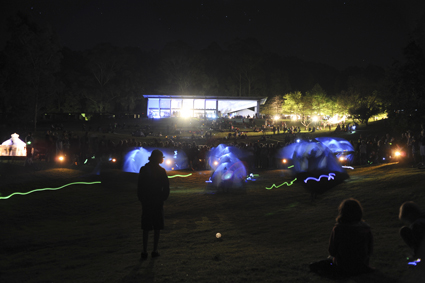
Niteworks
photo Heidrun Löhr
Niteworks
SITEWORKS
“SITEWORKS is quite the opposite of an intentional local engagement: it doesn’t really matter how many people come, this is really about the depth of conversation. I draw SITEWORKS as a coil, like a mosquito coil—an intense core and more and more outer circles of participation. It emerged from a conversation between two brothers, a scientist Tim Cohen and creative producer Michael Cohen. The core remains fairly constant so there’s always a lot of continuity in the people involved. It didn’t start out as a big art and science thing. Michael and Tim asked us if we could support the scientific research on the property and if we’d allow the artists to mess around with it, and we said, “Sure.” It was fascinating because the science was around research into climate change and suggested that our property was at a real tipping point for important measurements.
“I decided we should own SITEWORKS because it was about our place and because it gave us special information that we couldn’t afford to pay for. From that initial interaction—about 70 people at the first showing—there are a lot of other scientists and artists who contribute to SITEWORKS through research and commissions. And we now have a significant partnership with the University of Wollongong across arts and science faculties. I see SITEWORKS as very porous: we might be doing something about archaeology and memory in 2015—we’ve got a lot of farmers’ diaries and Indigenous history. Last year we focused on astronomy and the night sky and it was pretty sensational—1,000 people came. This year we’re looking at biodiversity. The thematic will often come from outside: scientists in the region came to us a couple of years ago and said food security is an enormous issue, can you use SITEWORKS to talk about it?” [See RT112]
Sharing the labour
Awed by their scope, I ask Ely how she manages such comprehensive, labour-intensive programs: “We have a really amazing staff. They’re very hard won. When we recruit it’s a very slow and painful process. We have an incredible skill set both in the arts and education staff, with huge experience, and our property and housekeeping staff are really beloved by our artists and visitors.”
Thinking about the future
“We’d like to share with the world the significant work developed at Bundanon. We are building a new digital platform because we know most people won’t necessarily come here, so we have to work out a way to allow people to engage with the conversations we’re having”—and develop “thought leadership given we’re the kind of place where ideas are hatched and shared, where ideas are jumping the fence all the time—because we’ve got a strong environmental platform as well as an arts and cultural and historical one. We also have plans for more built infrastructure to support the activity and the level of interest and to create opportunities for more people to stay here.”
Go deep
Staying at Bundanon is what Ely calls a “go deep experience. It’s not just a day visit. There’s something quite unusual about the landscape. Bundanon means ‘deep gully’ in language. So it may be something in the landscape itself.
“What is genuinely happening here is that Bundanon’s become a really important engine room as a resource for and across a lot of contemporary practice. I think the industry values it. People are relying on it. Australia’s very lucky to have it.”
Bundanon Trust, 170 Riversdale Road, Illaroo NSW 2540, www.bundanon.com.au
RealTime issue #121 June-July 2014 pg. 26-26
© Keith Gallasch; for permission to reproduce apply to realtime@realtimearts.net
A cold front hit NSW on the weekend of the Wired Open Day with torrential rain and temperatures dropping to single figures. Nonetheless a large group of locals and visiting audience members were not deterred. Rugged-up in puffer jackets and gumboots we all piled onto the courtesy bus in Cootamundra for the 40-minute drive, in part navigating a precariously muddy road, to the Wired Lab in Muttama for the deeply rewarding experience of Wired Open Day 2014.
Located on the farm on which artistic director Sarah Last, her father and grandfather grew up, The Wired Lab (also home to sound artist and computer scientist David Burraston) is a space for explorations around what Last calls “landscape scale practice.” The initiating project saw the construction of long wire instruments, made in collaboration with West Australian artist Alan Lamb. While they feature as a conceptual anchor to the lab, over the six years of its existence, the focus has extended to a range of listening engagements based in nature and environment. The 2014 instalment of the Open Day, incorporating elements from Last’s (G)local Frequencies Project, was focused on communication—not only between the local and global but between species as well.
In the main tent, offering a stunning view of the surrounding hills and vales, we are welcomed to country by Wiradjuri elder Bob Glanville and his grandson Peter Beath. Divided into four groups we are then led off into the landscape, our first stop being TARC, the Temporary Amateur Radio Club. Using the Wired Lab’s preinstalled wires as a Beverage antenna (used for short and medium wave transmission), the Wagga Wagga Amateur Radio Club, a group of ham radio enthusiasts is seated in a tent ready for transmission. In pairs, we get two minutes to communicate by voice or Morse Code with either the northern or southern hemisphere. The success of the communication is rated according to its reception strength and then we map our results with strips of bright pink tape rolled out across the grassy hillock. As the afternoon progresses the pink stripes fan out, a graphical manifestation of lines of connection. The framing of the experience by Jackson Castiglione, Dario Varcirca, Zoe Scoglio and Alice Dixson with Last and Burraston, including a cosy tent displaying ham radio paraphernalia, is well conceived and allows everyone a first-hand, if all too brief, experience of the ham world.
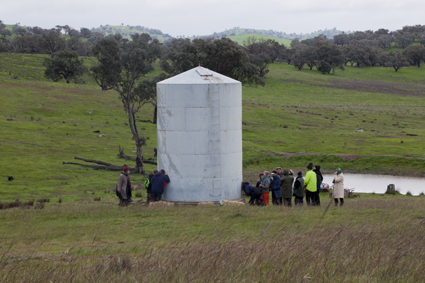
David Burraston, Grain Silo Meditation Tones, Wired Open Day and (G)local Frequencies Project
photo Jacob Raupach
David Burraston, Grain Silo Meditation Tones, Wired Open Day and (G)local Frequencies Project
Up over a hill and down a vale is an empty grain silo in which David Burraston has installed ring modulators and microphones to create a multilayered drone that changes and grows as the day unfolds. Poking your head in the chute or tapping the outside affects the resonance of the chamber, adding new properties to the sound. We are invited to sit on hay bales around the silo and meditate on the rich tones while looking out at the landscape. It is indeed a transcendent sound, the only problem is that everyone in our group is so damned friendly that there’s constant chatter and it’s hard to really have a moment of focused listening.
![Cat Jones, Evolution: A Walk [with Herbivores], Wired Open Day and (G)local Frequencies Project](https://www.realtime.org.au/wp-content/uploads/art/75/7549_priest_wiredopenday2014.jpg)
Cat Jones, Evolution: A Walk [with Herbivores], Wired Open Day and (G)local Frequencies Project
photo Jacob Raupach
Cat Jones, Evolution: A Walk [with Herbivores], Wired Open Day and (G)local Frequencies Project
Cat Jones is a guest artist for this year’s event presenting two works that continue her ongoing investigation into our relationship with plants. Evolution: A Walk [with Herbivores] is made specifically for the Wired Lab site and is an audio walk through the landscape (with sound by Melissa Hunt). Audience members don a protective jumpsuit adorned with leaves from the Grey Box Gum—offering an olfactory element—and are guided on a speculative journey into the life of both herbivore and plant. Alas I do not get to experience this directly since I choose to partake of Jones’ other work, Plantarum: Empathic Limb Clinic. In this one-on-one exchange in a small glasshouse in the middle of a field, Jones awakens my sense of smell, taste (with a fortifying nip of port) and touch, stroking my hands with a velvety soft branch of wormwood found on the property. Jones expands on the metaphorical connection of physical and psychic grafts as she attempts a kind of hypnotism. It’s subtle, multi-sensory, esoteric and a great lateral addition to the program. (See RT118 for a review of this work at Perth’s Proximity Festival).
The fourth afternoon activity is located in two listening tents. One contains Joyce Hinterding’s Very Low Frequency recordings made at the King’s Tableland in the Blue Mountains. This is an example of ‘natural radio’ as described in Douglas Kahn’s recent book Earth Sound, Earth Signal (RT120). In these recordings Hinterding taps into the sound of the ionosphere as radio waves and electrical energy ping around the globe. It’s fascinating material—a deep hum overlayed by static, chirps, whips and cracks—prompting you to ponder the vastness of space and its electromagnetic energies.
The second tent holds two headphone listening stations. The first allows us to hear the Wired Lab wires in real-time. Acoustically these wires literally sing: the two different lengths set up in a V-shape generate different pitches with glorious harmonic overtones. When miked up and amplified there are more zaps and pings as we hear the wires’ vibrations and shudders on a micro-level. The second listening station plays field recordings made by Burraston and UK artist Chris Watson, of the surrounding natural habitat of the Box Gum Grassy Woodlands—a world of birds and frogs and rustling winds.
As darkness hits, we all gather in the main tent where we warm ourselves with wine and are fed hearty dhal and cake. The evening’s performances start with Burraston’s Computational Beauty of Nature IV which looks at patterns and progressions in nature and translates them into sonic material—swathes of hum with warm static taken from the wires. Burraston, with Garry Bradbury, also performs The Bovine Opera, a piece conceived with Last using field recordings of cows and calves as they are being separated. Among the mournful bellows of the animals is Bradbury’s signature industrial throbbing that gives the work drive and a dramatic arc.
The centrepiece for the evening performance is a completely acoustic affair. In the lead-up to Wired Open Day, Last organised a workshop led by Western overtone singer Dean Frenkel and Mongolian overtone singer Burku Ganburged. Ten of the workshop participants join them to present a short work with many displaying a distinct level of skill. Frenkel and Ganburged are astounding, the room buzzing with a remarkable combination of harmonics.
The connection between this activity and the wires may at first seem oblique (though Last tells me there had been an intention to channel the voices down a temporary wire instrument, the weather rendering this experimentation too difficult). The link is to be found not so much in instruments or materials as in the sound itself. The majority of sounds generated at the Wired Lab are long and glorious drones encouraging the listener to explore the shifts and subtleties inherent in sustained tones. Listening to drones trains you to listen deeply, to appreciate sound in a profound way. Within this framework, the inclusion of the overtone singers is a perfect addition, not least because it offers a direct and meaningful engagement with local community, making them an integral part of the Wired Open Day.
In a realtime tv interview Sarah Last and I discuss how brutal weather made this event all the more significant; it required a different level of commitment from the audience, a capitulation to the forces of nature, as is always the case when you live on the land. Significantly the landscape, the weather, the art and our presence became one interconnected entity. The dominant memory I take away is the warm hum of communing.
The Wired Lab, Wired Open Day 2014, artistic director, curator Sarah Last, research & technology director David Burraston;
www.wiredlab.org
See also the video report of Wired Open Day 2014
RealTime issue #121 June-July 2014 pg. 28
© Gail Priest; for permission to reproduce apply to realtime@realtimearts.net
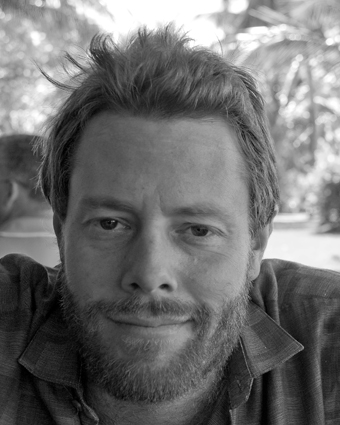
Sean Pardy
In the heart of Darwin in a set of lovely heritage buildings adjoining a large park is Brown’s Mart, the city’s first home for theatre and live performance. It’s a key site for the development and production of new work, providing professional support, affordable space and nurturing programs: Build Up, Shimmer and Share.
When Virginia Baxter and I were in Darwin last September, running a review-writing workshop for the NT Writers’ Centre during the Darwin Festival (territorians Fiona Carter, Nicola Fearn and Mike Bodnar now write for RealTime), we met Sean Pardy, Executive Director of Brown’s Mart Theatre, and chatted about his organisation’s connections with the city’s performance culture. I recently spoke with him in more detail about this.
Are you a Darwinian or Northern Territorian by background?
I wish I could claim that title but unfortunately no. We moved up here about five and half years ago. Previous to that I was doing theatre in Sydney, running a company called Critical Stages, which has been growing in leaps and bounds since I left—hopefully not because I left! Before that I was technical director at Darlinghurst Theatre, tour managing and stage managing, production managing and then just some quiet lighting on the side.
What drew you to Darwin?
I thought, we only live once and I wouldn’t mind seeing a different part of Australia and embracing a different community. We drove up with our car full of stuff. We had no friends, no jobs and no house to come to. We just arrived. And Darwin being the very welcoming place that it is, we soon landed on our feet. Slowly but surely I picked up a few contacts here and the industry is very supportive and easy to get to know. Eventually I found myself doing the venue managing here for about 18 months. I had a little spell as an independent artist, producer, freelance lighting designer and production manager. Then I took a job at the Darwin Council as a youth worker. At the beginning of last year I started here as Executive Director.
Brown’s Mart has been historically associated with community arts; what’s its focus and character now?
There’s been a very interesting shift in the venue and particularly the organisation in the last four to five years. It’s very much supporting professional Top End artists but the performance sector is so small up here that to truly support it we need to support all avenues of theatre creation. So not only do we run our Shimmer season of professionally produced local work, but we also run a Share program that provides affordable access to community groups or to artists who might be prepared to do a co-operative production or maybe some minority groups who are trying to get some work staged. We also support music by hosting Happy Yess, a live original music venue in the precinct and there’s Live on Fridays—free live music in the afternoon into the evening. There is a degree of crossover—an actor might also be a musician; sometimes theatre shows have a live musician [from our music programs] on stage.
Shimmer is your annual program of new work?
I would describe it as artist-driven work. Each production has a lead artist or creative producer driving that work; often it’s the writer or director but doesn’t necessarily have to be. They’re putting that work on because it’s important to them and they understand who the audience is they want to reach. Those artists then apply for funds—philanthropic or private sponsorship or government—to generate the resources to get the production on. We provide support as well. We put in some cash for those productions, some infrastructure and marketing support and guidance along the way in terms of producing the shows.
Are these co-productions?
Absolutely. We consider ourselves the presenters of the work and those creative individuals are the producers and they own the work; it’s theirs and we wouldn’t ever want to take it away from them.
What’s in the Shimmer program this year?
There are four works. The first was Jehovah’s One Table Restaurant by local writer Levin A Diatschenko, a philosophically based comedy, very funny and very well attended too. Set in a one-table restaurant, as the title suggests, it delves into the question of who we are and what we’re doing on this Earth mixed up with a love story and a philosophical take. Diatschenko’s a young up and coming writer with a background in film and literature. He’s written a few books and he’s just started to get into writing for the stage, which is great because he’s certainly a prolific writer. And paired up with the right dramaturg and directors, I think he’s got a bright future.
Next up was a co-production between Knock-em-Down and JUTE Theatre Company called Bastard Territory by Stephen Carleton [see the review, page 36].
Stephen is a Brisbane playwright. JUTE is based in Cairns and Knock-em-Down is a Darwin-based theatre company.
Yes, it’s exciting. It’s a big mix with actors from Darwin, Cairns and Brisbane; a great collaboration in that way. And it’s been really successful. Tongues are wagging. One of the characters describes the place as the “bastard territory” because everyone has an opinion on how it should be brought up but nobody sticks around long enough, which is very true. People fly in for a couple of years, get the experience and then fly out again.
The next play, The Hoist by a young writer Sarah Hope, has actually gone into rehearsal today. It won the prize for best script in the NT Literary Awards last year. Sarah’s a great young writer who has done a lot of work in remote communities, a lot of cultural development work. She’s a tutor at Corrugated Iron Youth Arts based here in Darwin. This is also a co-production, between Salt Theatre, which is Sarah’s company and Corrugated Iron and it’s going to help celebrate [the latter’s] 30th Anniversary this year.
Programming a work like this is a way to get new young artists involved and also to attract a younger audience. It’s a coming-of-age story about two boys who’ve been best mates for most of their lives, coming to the end of high school and contemplating questions like, ‘What am I going to do with the rest of my life?’
The Hill’s Hoist is such an Australian icon.
It’s in the design and part of the storyline involves climbing up on it, looking out to sea and dreaming of your future. In the script the Hoist is a character called Shirley. She doesn’t speak, I’m pleased to say.
The last of the works is a multimedia and puppetry show, The Book of Shadows. Is this another local product?
Yes. The creative brain behind The Book of Shadows [bookofshadows.org] is a Darwin-born writer, documentary maker and cross-media artist working here and in Melbourne, Tim Parrish who has paired up with an excellent local puppeteer, Conor Fox, and Stephen Mushin who has great puppeteering experience in Melbourne. In January, the artists went to Ubud in Bali to meet with masters in shadow puppetry and enjoyed a fantastic collaboration with them. What’s going to be interesting about The Book of Shadows is the combination of live performance with actors, puppets, shadow puppets and live projections. So the audience won’t always know which they’re watching. It’ll be a visual feast.
The Build-up is a seeding and development program, what kind of commitment do you make?
It’s very important because without support a lot of the ideas for works wouldn’t even get off the ground. We fund four developments a year with cash support of up to $12,000 and in-kind support valued at $6,000 per development. Again, it would be led by a key creative producer or lead artist and they’re able to source more funds if they feel they need them or if they want to have a longer development stage. It doesn’t have to end in a performative outcome, but it’s great for us if maybe the year after they might be able to propose a production.
We ran the first Build-up development last year and we’re negotiating to put that work on in 2015 and a second is toying with the idea of maybe 2015-2016. Another had an outing at the This Is Not Art Festival in Newcastle. It’s through the Build-up that we hope to grow the Shimmer seasons.
You regularly feature Indigenous works at Brown’s Mart. Are they part of these programs?
We’re very supportive of Indigenous artists. Last year we programmed three productions in which the key artists were Indigenous. One [was reacting to] the 100-year commemoration of the Cullen Compound, where local people had been kept, part of the Stolen Generations experience. We work very closely with the Darwin Entertainment Centre’s Indigenous Creative Producer Ben Graetz. Together with him we’re working on getting [well-known actress] Tessa Rose’s scripts developed and produced. We’ve also worked together with local artist Ali Mills for a similar program. And we’re trying to provide support for Lynette Hubbard to get her show, The Adventures of Namakili, further ground. It had a season here but we’d like to see Lynette touring the country with it.
Darwin is a fantastic melting pot of cultures and Indigenous people represent about a third of the population so it’s just natural that we’re big supporters of Indigenous work.
Do you have ambitions beyond what Brown’s Mart is currently achieving?
I think our programs, particularly in the last 18 months, have really started to develop. Beyond that our ambition is to have a sustainable theatre model. All the [artists and producers] flog their guts out trying to generate enough income so that everyone can be paid fairly. We’re receiving Program and Presenter funding from the Australia Council while the NT government provides the bulk of our funding. We’d like to even that up a little, increasing our federal support to provide certainty for the artists that there will be work into the future.
Brown’s Mart Theatre, Darwin, brownsmart.com.au
RealTime issue #121 June-July 2014 pg. 29
© Keith Gallasch; for permission to reproduce apply to realtime@realtimearts.net
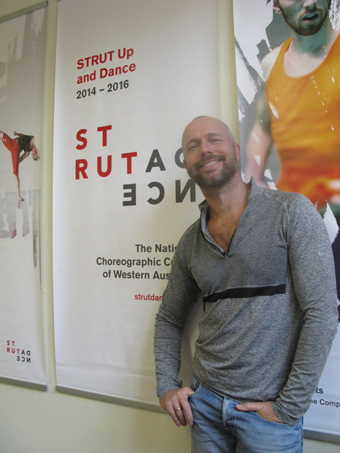
Paul Selwyn Norton, Director, STRUT
Raised in Africa and the West Indies and based in Amsterdam for 25 years until his recent move to Australia, Paul Selwyn Norton has danced with Amanda Miller/Pretty Ugly and William Forsythe’s Ballet Frankfurt. He set up a production company, no apology, in 2003 to support his work in the Netherlands while creating and restaging work for Ballet Frankfurt, Batsheva Dance, Galili Dance and, in Australia, Stalker Theatre and Chunky Move.
Norton was about to undertake Doctorate Studies in Dance with QUT in Brisbane when he was offered the job as Director of STRUT, The National Choreographic Centre of Western Australia, Perth. Norton’s vision is transforming STRUT into a national organization, opening membership up across the country and providing choreographers with introductions to unique methodologies and offering considerable development opportunities.
He is emphatic about his aim for STRUT in 2014: “This year is literally about bringing in benchmark training methodologies. There are a lot of performance outcomes but nothing really massive until the end of 2014 with the Mini MoveMe Improvisation Festival and then in early 2015, a co-production with Perth’s Fringeworld.” 2014 is really about coming back to our physical poetry and how we research that in our work.” With a national review of dance, Future Moves, and state government reassessment of the WA dance scene, “I thought, okay, what a great opportunity to come back to the body and not immediately produce work.” He’d also noted that there is little of the training associated with William Forsythe in Australia and nothing of Gaga [Ohad Naharin’s unique movement vocabulary which is now the daily training for the dancers at Batsheva Dance Company]. “As soon as I got this job, I phoned Ohad and Bill and said, hey, those methodologies are very pertinent, very resonant still and not practised here.”
Was it government policy decisions or your perception of the field that determined your approach?
It was a combination of three things—a paradigm shift in terms of benchmark training here in Perth, a strategic policy move and [a reflection of the fact] that I’ve worked with most of the national artists on previous visits to Australia. It was easy to get strategic leverage by bringing in two really high-end international choreographers. The Board and I thought it was a good balance between policy and artistic direction. Besides, Forsythe and Naharin will be represented by people who’ve worked with them, for instance Rachel Osborne—an Aussie girl who trained at QUT and used to work with Batsheva—has invited [another Batsheva alumni] Guy Shomroni to join her.
The Forsythe method is coming via Riley Watts and Michael Schumacher?
Yes and we’ve just signed off a deal with Christopher Roman, the Director of the Forsythe Foundation, who proposed mounting Forsythe’s One Flat Thing reproduced (2006). As we build it over the next three years, we’ll use this piece as a choreographic training model, since it has many extrapolations back to earlier Forsythe works such as Robert Scott (1986) and forward to Synchronous Object (2009, a website exploring One Flat Thing’s choreography). We’ll be doing the same with Batsheva, building pieces of repertoire into a full evening performance, exclusively on Australian dancers.
What are your plans for 2015?
In 2015 we just add another layer on top of 2014, working with a lot more locals, like Rachel Ogle, Jo Pollitt and Shona Erskine—who is doing some incredible work with Performance Psychology. Plus we’re designing a collaborative program, helping young choreographers who haven’t worked with composers before or those who’ve worked with them later in their development and would rather have developed the vernacular and understanding earlier on in their process.
Are you maintaining current programs?
Some of the current STRUT Seed Residencies that will go on to second and maybe third stage development, ready for presentation will be supported and presented in the bigger MoveMe Festival at the end of 2016. For the first time this year, a Seed Residency went to interstate artists. That was a contentious issue, but it’s about actually sharing and communicating across the states. So it is great that Gabrielle Nankivell and Luke Smiles will work with WA artists—it’s about making a beautiful, robust garden and sharing that experience.
Short Cuts has been a staple for STRUT for years and I wouldn’t want to shift that because it’s a great platform. But artists tend to use it as a launch into development and grant applications. I want to take that pressure off. So I thought let’s pull back and do Off-cuts with a smaller turnaround, more like an open-mike approach, or show part of your work and get some critical feedback, so artists don’t feel like they get one shot at that one Short Cuts program and that’s it for a whole year.
And what sort of support do they get?
It depends on what level. Say with Short Cuts, you get the performance space, production money, the door money—we don’t take anything from that—and technical support. Off-cuts is just studio time and you get the door. Prime Cuts, which is the final stage, is curated from Short Cuts and then there’s a substantial fee to produce the work in a real venue; this year we’re doing it with the WA Ballet Theatre. We are also building bridges between ballet and contemporary. Jane Smeulders, principal of the WA Ballet, was already in the first Gaga workshop.
What about the high male quotient in your 2014 program?
I’ll put it this way, Erin, Ohad and William are the two choreographers I’ve danced and created for and I needed to get some serious clout into the organisation because government was like, okay STRUT’s on standstill, Paul, you’re gonna have to pitch. So, I phoned up Bill and Ohad. I can phone them but I can’t phone say Trisha [Brown] or the Pina Bausch Foundation as I don’t know them. I phoned Stephanie Lake but she’s a very, very busy lady. I had to write a business plan in two and a half months. I just pulled what I could when I could. I talked to Nellie Benjamin who will be coming over and a lot of local female choreographers will be working with us next year. It’s something that’s happened by default. I have no preference either way. It’s got to be good work, good art, good poetry…
How do you see STRUT in terms of the changes happening in Perth?
The city is undergoing infrastructural change. The Metropolitan Redevelopment Authority (MRA), has four massive centres that it’s re-igniting and connecting so you’re going to get grungy Northbridge meets the corporate south. And all the beautiful local cafes that we have here—three of which we’re in partnership with because I really believe in community exchange—are full of tats, inks, beards and suits and power heels: a fantastic mix and that’s either our audience or potential new members.
There’s also the reactivation of the Cultural Centre where PICA, the Blue Room and the State Theatre Centre are. That’s why the Mini MoveMe Festival is centred there. STRUT is working with the MRA’s reactivation mandate to specifically enhance it. They’re ticking their boxes and we’re ticking ours. Michael Schumacher will present his Dans Le Jardin to JS Bach solos in the courtyard of the State Theatre Centre and then Pied-Piper the audience out into the Cultural Centre.
As for your own practice, you will be working with the Sydney Dance Company’s graduate year students later this year?
I was there in May. I did a two-week process and I come back in June and I think the work will be shown sometime in September. I think it’s important to continue those dialogues with your own practice and to feed it back into the sector. And dancers who are graduating there, not all of them are going to the Sydney Dance Company.
We’re saying to them, we’re a beacon and not a lighthouse. It’s not career suicide to go west. It’s actually career development, a beacon of opportunity and that’s why the Australia Council was so excited to get involved. This is something else I use when I enter the corporate conversation: ‘You’ll be investing in a national organisation and it’s in Perth.’ There are not many national arts organisations in this city, but we’ve got big dreams and the hope is that it all feeds back into the dance ecology here in WA.
The 2014 STRUT program includes Master Workshops with Byron Perry, Antony Hamilton, Improvisation Workshops with Riley Watts and Michael Schumacher and the Mini MoveMe Festival in partnership with TURA New Music, Ausdance WA, the State Theatre Centre of WA, the Perth Institute of Contemporary Arts, The Blue Room Theatre, FORM, Venn Gallery and Moana Project Space and featuring artists Rosalind Crisp, Ros Warby, Andrew Morrish, Peter Trottman, Jo Pollit and Paea Leach, workshops and a ‘caravan’ of works travelling on to Sydney’s Critical Path, Melbourne’s Dancehouse and Brisbane’s Judith Wright Centre (with Ausdance QLD). Nov 21-30; www.strutdance.org.au
RealTime issue #121 June-July 2014 pg. 30
© Erin Brannigan; for permission to reproduce apply to realtime@realtimearts.net
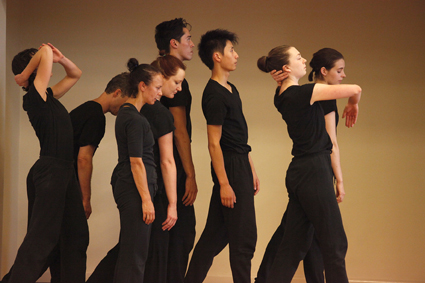
dance for the time being – Southern Exposure (2013), an earlier iteration of Love is Blind, Dance Exchange
photo Rachel Roberts
dance for the time being – Southern Exposure (2013), an earlier iteration of Love is Blind, Dance Exchange
There is an hypnotically silky texture in the movement of Russell Dumas’ dancers. It is not the tautly muscular control we link to any contemporary dance of a certain calibre. It doesn’t really look like control at all, but as though everything falls into place naturally, and the dancers’ volition is incidental, as light as a breeze.
In his new work, Love is Blind, this exquisite smoothness is in evidence again, and remains the most captivating aspect of the work. That said, such uncanny qualities are only made possible by Dumas’ commitment to dance as enquiry in its own right, a form that can stand alone “without marriage to other forms,” as he puts it.
Love is Blind seeks to examine how hearing and vision interrelate—in the experience of the audience but also in that of the dancers, for whom movement is obviously in the equation. A Schubert song cycle is an aptly emotive choice for this, and the work’s two parts are presented in separate spaces at Dancehouse: first the open floor of the theatre, which is cast in deep shadow by the black curtains of the proscenium stage behind; then the upstairs studio, with distinctive lighting.
To begin, seven dancers run onto the bare and darkened floor, form a brief, spinning circle until the form breaks, then softly spread out in the room. The cycle of songs begins and we watch the dancers find ways into structures: radial patterns reminiscent of snowflakes or merry-go-rounds in centrifugal play. With interlocking arms their counterbalance allows for descent to the floor, and ascent with the structure intact. At one point, a small ‘circle’ of three rotates, enclosed by a circle that moves in counter-direction. There’s a formality here (acknowledged in moments of muted humour with quaint nods and bows) that might appear prim if delivered in a different way. But an almost tender quality in these moving bodies—a transparent sensitivity as they fold into and out of each other—awakens a different view. Display of external precision is clearly not the goal here. Instead, in how these bodies rely on each other there is an intrinsic order of sorts revealed: self-regulation that still gives space for individual feeling.
A succession of duos and trios unfolds through the rest of part one, with seamless lifts and gliding descents, structures that segue into other structures with ease. These take place simultaneously and obliquely on the floor, then culminate in a solo performed in double. An image of this still lingers in my mind: one male dancer alone on the floor; his doppelganger on stage behind him, obliquely, framed to one side by the black curtain, beneath a weak and distant glow of light. While their movements are identical, they slide subtly in and out of sync.
Dumas tells me after the performance that he didn’t ask his dancers to mark time by music, but assigned them bodily tasks to foil the influence of rhythm—in the case of this double solo, a breath-based score to induce an embodied sense of time. This flexing apart of sensory response is an obvious challenge for the dancers and meanwhile, for the audience, Schubert’s song offers up its melodic persuasion. “Music affects emotion, and breath, and hence the way we see,” says Dumas. So we have, side by side, separate systems of sensory stimulation.
The result is both dreamlike and strangely reassuring. Things hold together, but not in an exactly familiar way. And the not-quite-in-kilter details yield to a strangely smooth ride.
After interval we move to the studio space upstairs for part two, Dumas appearing briefly to announce this is a sketch, not a resolution. It is a playful displacement of expectation, a kind of macro-synchronisation of the show. The lighting design is no longer the oneiric penumbra of downstairs, but a sort of lantern effect: an almost stark jumble of shapes and shadows against the wall. Part two then unfolds with similar material to part one, but with the contrast of silence, and I ask myself if this really does sway my perception.
In truth, I’m not sure. On that night I was not yet privy to the particulars of Dumas’ experiment, and the unique magic of those moving bodies was quite a sensory spell, never mind the explanation. But there’s no doubt his curiosity has profound outcomes and shows what can be done by fine-tuning a lens on the simplest ingredients of performance. Through careful attention to the nature of our senses—rather than just feeding or bombarding them—a realm of exquisite sensitivity is laid bare in this work. And this feels reassuring, somehow, like a lost memory being quietly recovered.
–
Love is Blind, choreographer Russell Dumas, dancers Jonathan Sinatra, David Huggins, Molly McMenamin, Eric Fon, Nicole Jenvey, Beth Lane, Esperanza Quindara, associate artist Linda Sastradipradja, Dancehouse, Melbourne, 28-30 March
RealTime issue #121 June-July 2014 pg. 31
© Jessica Sabatini; for permission to reproduce apply to realtime@realtimearts.net
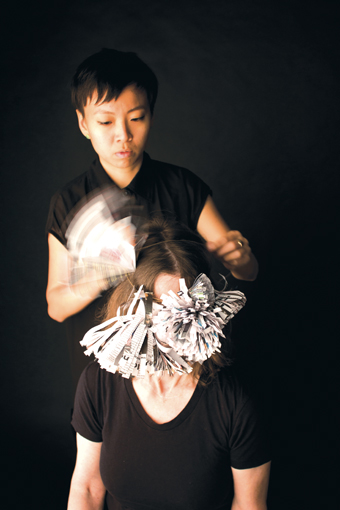
Beatrice Chew at work on the RealTime 121 cover
photos courtesy the artist
Beatrice Chew at work on the RealTime 121 cover
RealTime designer Graeme Smith took on the challenge to create the perfect cover for the magazine’s celebratory 20th Birthday issue in collaboration with two young artists Beatrice Chew and Su-An Ng.
Graeme (peonypress.com.au; goodhabitat.com.au), describes himself as a rare communications hybrid: a roughly 50/50 balance of writing and designing for any appropriate medium. He’s a distiller. “I work out what things are, what they mean, where they are now and what and where they may be next, then present the findings in words and pictures. Sometimes the aim is to sell things and other times it’s to try to make places better for living in.”
Beatrice Chew works with Graeme in Good Habitat, a working unit formed with prominent designer-writer Heidi Dokulil. Social and educational programs, government and private, the built environment, talks and workshops, exhibitions and conferences, good food, reporting and publishing are some of the things that come within their sphere of interest and influence.
Beatrice (www.beatricechew.com) created the amazing masks made from back issues of RealTime and worn by founding editors Keith Gallasch and Virginia Baxter. Beatrice is a researcher whose interests include design processes, technology and sustainability (especially in the areas of food and education). She says, “The masks are an exploration in modules. They were executed in two ways: a mathematical tessellation and a floral arrangement that gave birth to: [1] parasitical hexagons engulfing the face; [2] an over-sized floral arrangement made to create contrast and communicate the romance of publication. I am sure in the 121 editions that have been published, there are many parts that make RealTime what it is today. Similarly, with the masks, no one part can exist without all the others.”
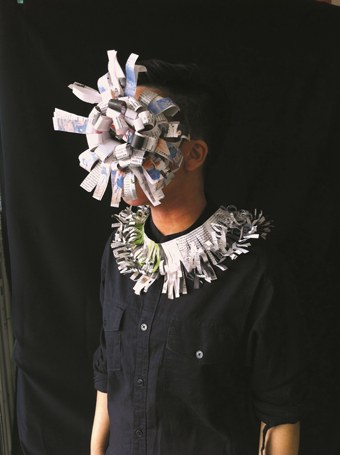
Su-An Ng (incognito), paper sculpture by Beatrice Chew
photos courtesy the artist
Su-An Ng (incognito), paper sculpture by Beatrice Chew
The images were photographed by Su-An Ng, an award-winning animation graduate from Emily Carr University of Art & Design in British Colombia who has shown her work in film festivals here and internationally. She’s recently completed a short animated film with the National Film Board of Canada. Entitled ITCH, it’s an engrossing, short stop-motion film made with ceramic clay, an abstract expression of what it feels like to go through an eczema flare-up. You can see more of Su-An’s multi-faceted visions at www.su-anng.com
Graeme’s brief from the editors was to create an image that celebrated the hybridity that has been the focus of RealTime’s attention over two decades. What he and his collaborators came up with was the miraculous transformation of copies of the magazine into another form—hand-crafted, intricately woven paper masks which become the faces of the editors who are at once themselves and an enduring publication.
Keith and Virginia.
Managing Editors, RealTime
RealTime issue #121 June-July 2014 pg.
© Keith Gallasch & Virginia Baxter; for permission to reproduce apply to realtime@realtimearts.net
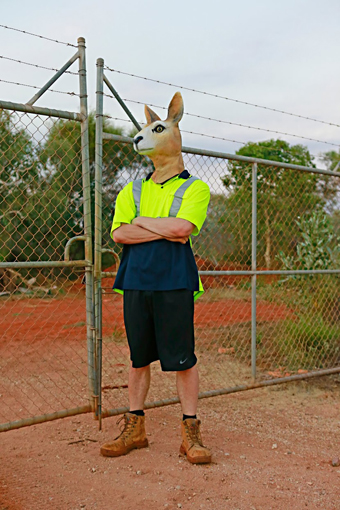
Josh Mu, Cut the Sky, Marrugeku
photo Rod Hartvigsen
Josh Mu, Cut the Sky, Marrugeku
In late May. Broome dance theatre company Marrugeku showcased Cut the Sky for an invited community audience as a prelude to a program of national and international touring in 2015. Cut the Sky looks to the future, contemplating global climate change from an Indigenous point of view in a multi-artform work. It has been developed by a team of artists and Indigenous cultural leaders from across the Kimberley and urban Australia collaborating with artists from Burkina Faso, Belgium and Assam in Northern India.
The work is presented in five acts based around five poems by Walmajarri/Nyikina poet and ‘dream catcher’ Edwin Lee Mulligan, with two original songs composed by Papua New Guinean born ‘future soul’ singer/songwriter Ngaiire and extant songs by Nick Cave, among others, all sung by Broome-based actress Ngaire Pigram.
Mulligan’s poems are a standout, capturing what I have observed over the years to be an Indigenous three dimensional grid of knowledge and perspectives that encompasses the heavens, earth and water, and which has existed via traditional stories and lore in this part of the world for over 40,000 years: “…Taking a transformation as an eagle and in that formation I was travelling within the cloud dust…”
To see and hear Mulligan performing his poetry without artifice and with an accent that suggests English may be his second or third language brings an integrity to the work that is in keeping with the authenticity of Marrugeku’s ethos.
Mulligan’s poetry encapsulates a way of being in the world, of “holding it, that may demand a new kind of attention of its audience” as Cut the Sky director Rachael Swain puts it in her essay, “Time and a Mirror: Towards a Hybrid Dramaturgy for Intercultural-Indigenous Performance” in New Dramaturgy, editors Katalin Trencsényi and Bernadette Cochrane, Bloomsbury, 2014.
Marrugeku’s hallmark style of contemporary dance—devised from the performers’ personal and cultural backgrounds—is on full display. In a memorable sequence dancer-choreographer Dalisa Pigram’s portrayal of a drunk FIFO mine worker veered from the comic to the compelling, before morphing into a study of a disturbed psyche in a disturbed land, culminating in a frenzy of ‘digging up’ her own self.
A distillation of the unique perspectives of Kimberley cultural and artistic leaders is the work’s heart and greatest strength. Other contributors to these perspectives include Marrugeku’s patron Patrick Dodson, Bunuba cultural leader June Oscar and Yawuru dancer and language speaker Dalisa Pigram, the company’s co-artistic director. These perspectives are then framed within a multi-art form expression embracing both contemporary video and archival footage—including the famed Noonkambar Station anti-drilling campaign in 1979—original music and sound-scape design, virtuosic contemporary dance and original text.
The sum total is an ambitious and richly imaginative work that eschews didacticism. Instead, it ignites our imaginations by using the transformative power of metaphor to provide a window through which we can glimpse the possibilities of a different way of being, both before and after what would appear to be inevitable climate catastrophe.
–
Cut the Sky, co-created by cast and creative and cultural team; concept Dalisa Pigram, Rachael Swain, director Rachael Swain, co-choreographers Dalisa Pigram, Serge Aimé Coulibaly, storyteller Edwin Mulligan, performer, singer Ngaire Pigram, dancer Miranda Wheen, Dalisa Pigram, Eric Avery, Josh Mu, dramaturg Hildegard de Vuyst, cultural advisor Patrick Dodson, musical director Matthew Fargher, new media artists Desire Machine Collective [Sonal Jain, Mriganka Madhukaillya], costumes, set realisation Stephen Curtis; Broome, May 22, 23
RealTime issue #121 June-July 2014 pg. web
© Mari Lourey; for permission to reproduce apply to realtime@realtimearts.net















 Here is a true rarity, an Australian book celebrating the long life and distinctive vision of a theatre company—Geelong’s internationally successful Back to Back Theatre ensemble. Rather than its works being playwright-driven, the company is an exemplar of contemporary performance, teaming an intensely collaborative director, designers and composers with performer-devisors with perceived intellectual disabilities to collaborate over very long periods on creations that unsettle our sense of time, space, identity and, not least, ability.
Here is a true rarity, an Australian book celebrating the long life and distinctive vision of a theatre company—Geelong’s internationally successful Back to Back Theatre ensemble. Rather than its works being playwright-driven, the company is an exemplar of contemporary performance, teaming an intensely collaborative director, designers and composers with performer-devisors with perceived intellectual disabilities to collaborate over very long periods on creations that unsettle our sense of time, space, identity and, not least, ability.




























 We’re exhilarated. We’re dispirited. Here we are celebrating 20 years of RealTime’s support for adventurous Australian art. “Exhilarated” at the thought of artists’ prodigious output, ceaseless inventiveness, resourcefulness and increasing connectedness across the nation. “Dispirited” because the previous Labor Government’s promised increase of mostly new cultural funding, $263m over four years, will not be realised by the new Coalition Government.
We’re exhilarated. We’re dispirited. Here we are celebrating 20 years of RealTime’s support for adventurous Australian art. “Exhilarated” at the thought of artists’ prodigious output, ceaseless inventiveness, resourcefulness and increasing connectedness across the nation. “Dispirited” because the previous Labor Government’s promised increase of mostly new cultural funding, $263m over four years, will not be realised by the new Coalition Government.
 RealTime has its origins in discussions around a dining table in inner city Sydney in the early 1990s. These were long conversations (often well lubricated with a bottle of red) about the need for the performance community to develop a forum where work could be properly documented, connections made, lineages understood and the achievements of artists acknowledged through supportive and informed criticism.
RealTime has its origins in discussions around a dining table in inner city Sydney in the early 1990s. These were long conversations (often well lubricated with a bottle of red) about the need for the performance community to develop a forum where work could be properly documented, connections made, lineages understood and the achievements of artists acknowledged through supportive and informed criticism.

 The early years of RealTime now seem like a distant dream, a fuzzy recollection of a fury of creation, learning on the job, reaching out across the country to engage writers and distributors, connecting with artists, knocking out grant applications, labelling bundles and loading trucks, covered in ink, wracked with endless financial trepidation, exhilarated every time an edition rolled off the presses and partying every time (we’re no longer up to that). Final layout happened variously in an old flourmill in Newtown (now home to the Omeo Dance Studio), graphic design studios in Surry Hills and, for years, the crowded city office of Art Almanac with artist Paul Saint patiently at the computer through the long nights.
The early years of RealTime now seem like a distant dream, a fuzzy recollection of a fury of creation, learning on the job, reaching out across the country to engage writers and distributors, connecting with artists, knocking out grant applications, labelling bundles and loading trucks, covered in ink, wracked with endless financial trepidation, exhilarated every time an edition rolled off the presses and partying every time (we’re no longer up to that). Final layout happened variously in an old flourmill in Newtown (now home to the Omeo Dance Studio), graphic design studios in Surry Hills and, for years, the crowded city office of Art Almanac with artist Paul Saint patiently at the computer through the long nights.





 An important new book on Australian contemporary dance, Bodies of Thought: 12 Australian Choreographers features a generation of award-winning, innovative Australian choreographers with international reputations and legacies of influence:
An important new book on Australian contemporary dance, Bodies of Thought: 12 Australian Choreographers features a generation of award-winning, innovative Australian choreographers with international reputations and legacies of influence:










![Cat Jones, Evolution: A Walk [with Herbivores], Wired Open Day and (G)local Frequencies Project](https://www.realtime.org.au/wp-content/uploads/art/75/7549_priest_wiredopenday2014.jpg)







